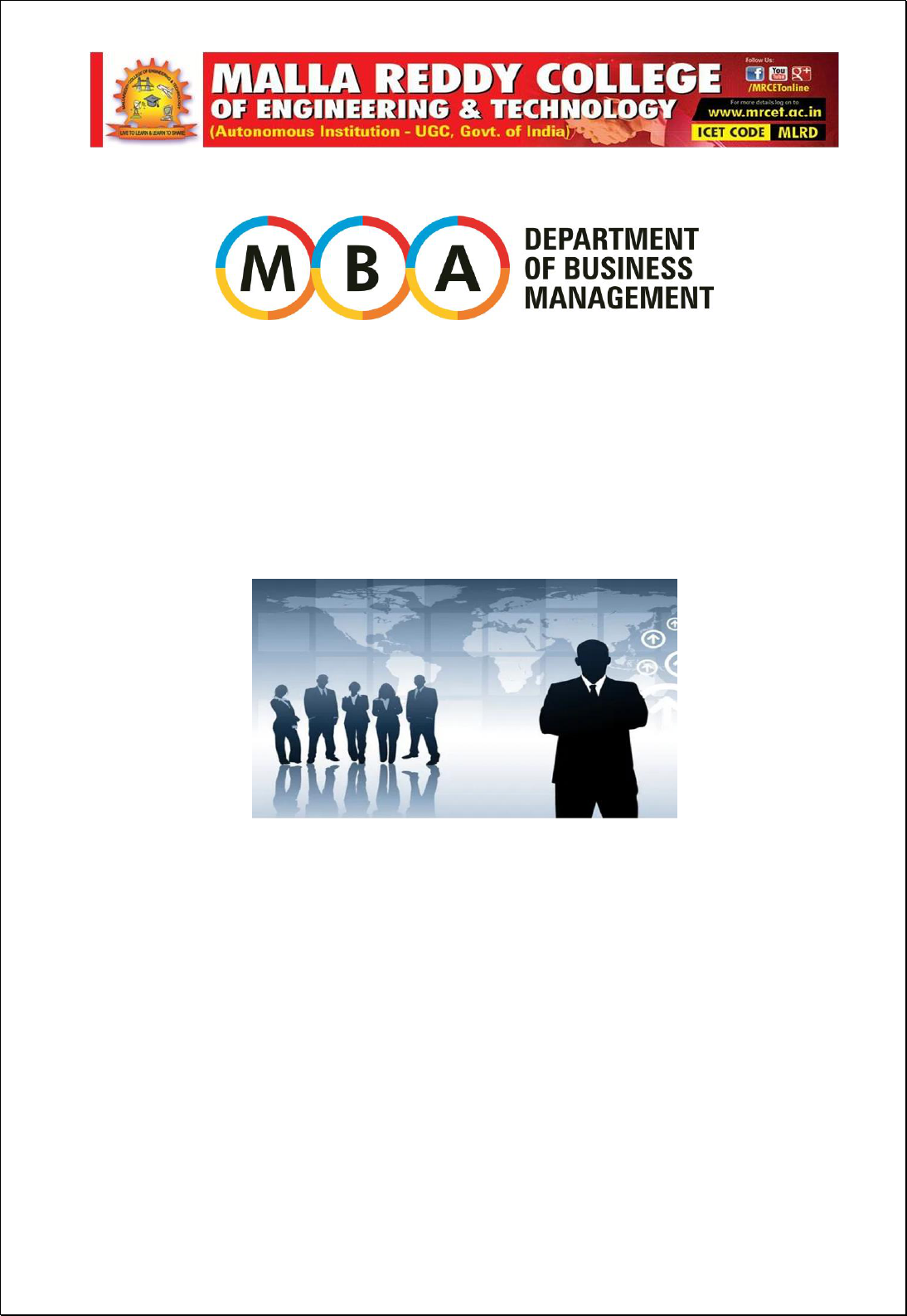
Digital Notes
PROFESSIONAL COMMUNICATION SKILLS
(R20MBA10)
Academic Year 2020-22
Compiled
By
Dr. P Ramya
Mr. V Hari Krishna
Ms. M Sunita
MALLA REDDY COLLEGE OF ENGINEERING & TECHNOLOGY
(Autonomous Institution-UGC, Govt. of India)
Maisammaguda, Dhulapally, Kompally, Medchal, Hyderabad - 500100

Course Aim/s:
To enable students how to improve communication skills.
Learning Outcome/s:
To develop Writing skills in preparing business letters, report, memos, and proposals.
To develop Oratory skills through public speaking
To understand importance of professional attire in corporate environment.
To get knowledge on various business etiquette and inculcate the etiquette for corporate fit.
Unit-I: Concepts of Communications
Introduction: Definition and Process of Communication - Forms of Verbal and Non-verbal
Communication.
Barriers of Communication: Communication Barriers and Overcoming Communication Barriers -
Guidelines for Effective Communication.
Business Writing: Direct and Indirect approaches to Business Writing - Five Main Stages of Writing
Business Messages.
Exercise: Role Play, Square Talk Activity.
Unit-II: Written Business Communication
External Communication: The Seven C’s of Letter writing - Kinds of Business Letters - Business
Reports and Proposals - Purpose of Business Reports.
Internal Communication: Format and Principles of Writing Memos - General Warning - Cautions.
Exercise: Preparation of Reports on different issues.
Unit-III: Oral Communication
Public Speaking: Types of Public Speaking - importance of Public Speaking.
Power Point Presentation: Planning the Presentation - Delivering the Presentation - Developing &
Displaying Visual Aids - Handling Questions from the Audience.
Listening: Definition - Types of Listening Skills - Features of a Good Listener - Causes and effects of
Poor Listening.
Exercise: Elocution and Extempore
Unit-IV: Behavioural Techniques
Body Language: Facial Expressions - Body Posture - Gestures - Eye Movement - Touch and the use of
Personal Space.
Business Attire and Grooming: Different types of Attire - Guidelines for Business Attire.
Exercise: Power of Body Language, Charades.
Unit-V: Etiquettes
Etiquettes: Greeting Etiquette - Corporate Etiquette - Telephone Etiquette - E-mail Etiquette - Meeting
Etiquette - Netiquette - Personal Etiquette - Social Etiquette - Dining Etiquette.
Exercise: Introduction and Art of Conversation, Telephonic Activity.
REFERENCES:
Meenakshi Raman and Prakash Singh, Business Communication, Oxford
Lesikar: Basic Business Communication, TMH
David Irwin: Effective Business Communications, Viva- Thorogood.
Rajendra Pal, J S Korlaha HI: Essentials of Business Communication: Sultan Chand & Sons,
New Delhi

UNIT-1
Unit-I: Concepts of Communications
Introduction: Definition and Process of Communication - Forms of Verbal and Non-verbal
Communication
Barriers of Communication: Communication barriers and overcoming communication barriers -
guidelines for effective communication.
Business Writing: Direct and Indirect Approaches to Business Writing - Five Main Stages of Writing
Business Messages.
___________________________________________________________________________
Introduction: -
Communication is as old as human civilization. The common need for protection led to group
life. As group life developed, forms of communication also developed. Communication was in
the forms of codes, indications, signals, and expressions.
Gradually with the increase in population, division of labor, exchange economy, etc.,
necessitated the development of language. In the present-day world, communication is a vital
need of every Step in any industrial or commercial activity.
The term communication has been derived from the Latin word, ‘communis’, which means
common. Communication means, to tell, show, spread information, and inform. The term
communication is used to signify the process of transferring ideas or receiving them by any
means such as word of mouth, telephone, telegram, letter, message, etc. Thus, communication
stands for sharing of information, imparting or conveying ideas and knowledge.
Meaning
The English word ‘communication’ is derived from the Latin word communis, which means common.
The term communication refers to the sharing of ideas in common. In other words, it is the
transmission and interaction of facts, ideas, opinions, feelings, or attitudes. Communication is the
essence of management. The basic function of management (planning, organizing, staffing, directing,
and controlling) cannot be performed well without effective communication.
In short, Communication is the process of passing ideas, views, facts, information, and understanding
from one person to another. This process is necessary for making the subordinates understand what the
management expects from them.
Communication cannot take place without two parties – the receiver and the sender. The information
which is sent by the sender must be understandable to the receiver.
Definition:
Following are some of the important definitions of communication:
Communication may be defined as “the transfer of information and understanding from one
person to another.”
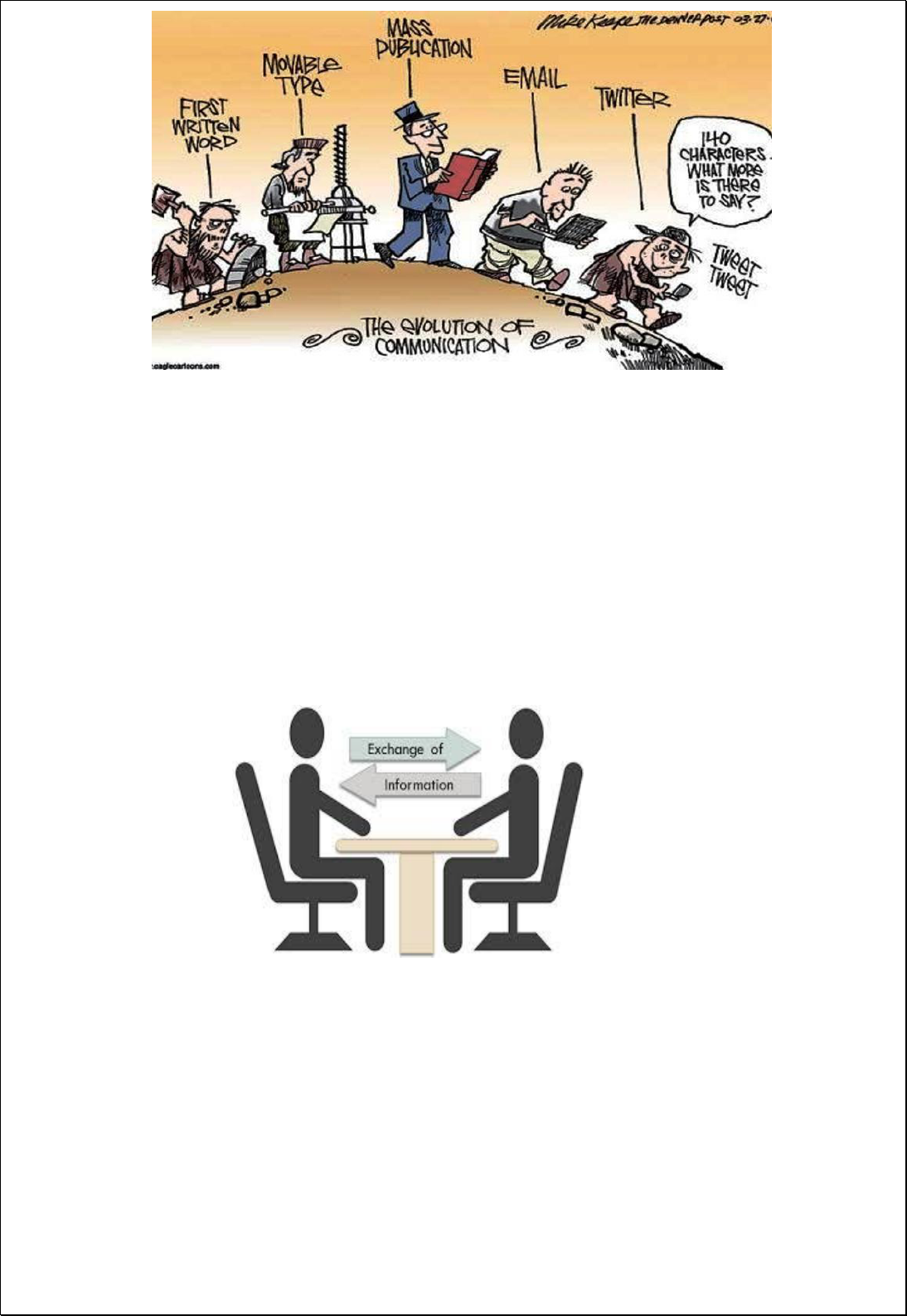
According to Koontz and O’Donnel, Communication may be understood “as the exchange of
information at least between two persons to create an understanding in the mind of the other,
whether or not it gives rise to conflict.”
Newman and Summer- “Communication is an exchange of facts, ideas, opinions or emotions
by two or more persons.”
‘Communication is the sum of all things a person does when he wants to create an
understanding in the mind of another. – Louis A. Allen
‘It is the process of passing information and understanding from one person to another. It is
essentially a bridge of meaning between people. By using this bridge of meaning, a person can
safely cross the river of misunderstanding that separates all the people’. – Keith Davis
Objectives
The primary objective of communication in management is to convey information—instructions,
policies, procedures, decisions, etc., so the listener will hear, read, understand what is said, agree and
accept the message, and react as intended by the manager or sender of the communication.
There are many objectives of communication. They are
Stronger Decision Making
Increased Productivity
Steadier Workflow
Enhanced Professional Image
Clearer Promotional Material
Provide Advice
Provide Order
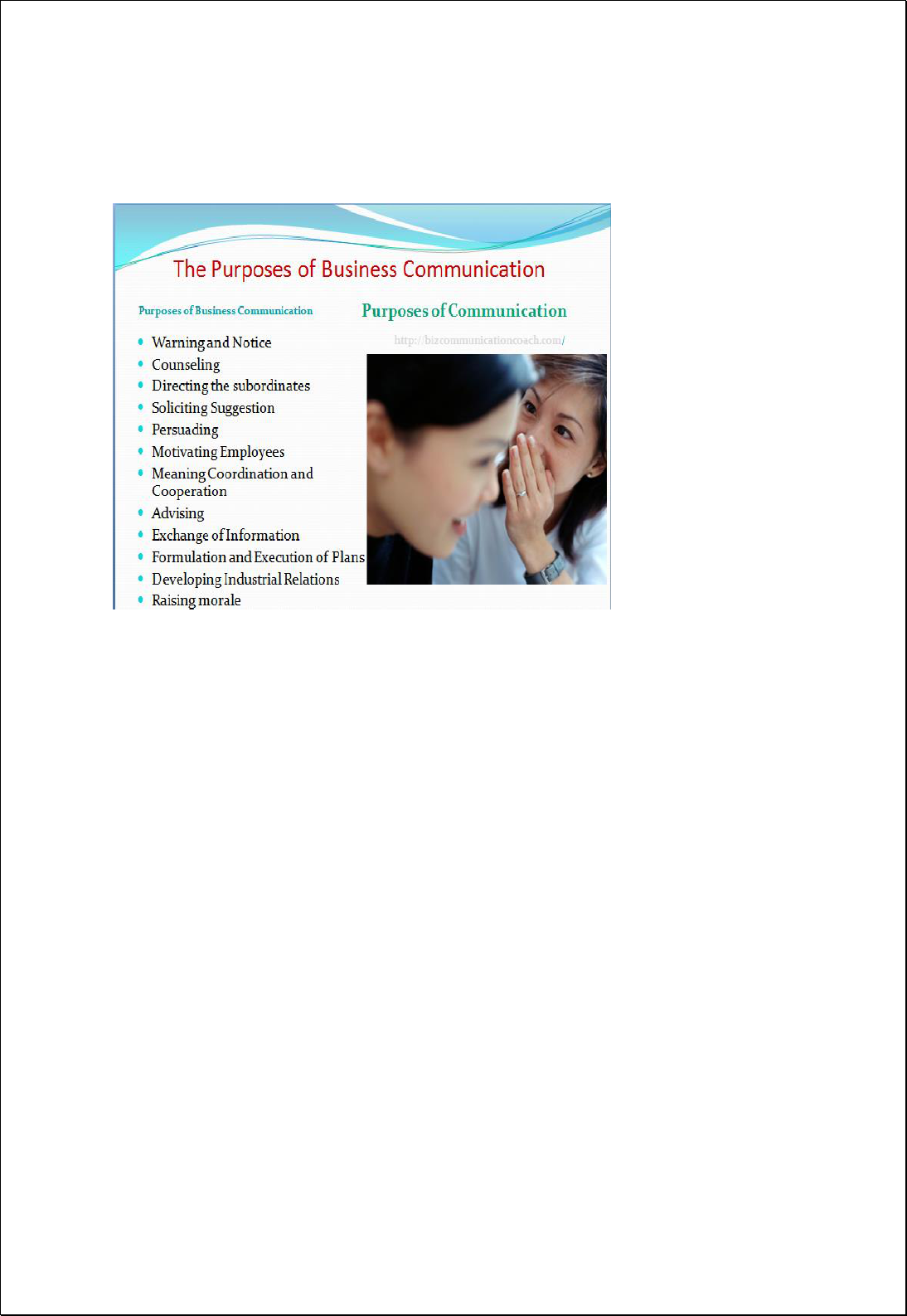
Suggestion
Persuasion
Education
Warning
Raising Morale & Motivation
To Give & Receive information
To Provide Counseling
To Improve Discipline
Communication – Characteristics
The characteristics of communication are as follows:
(i) At least two persons – Communication involves at least two persons—the sender and the receiver.
The sender sends the message and the receiver receives the message. There is an exchange of
information between two or more persons.
(ii) Two-way process – Communication is essentially a two-way process. It does not merely mean
sending and receiving messages. It is not complete unless and until the message has been understood
by the receiver in the same sense.
(iii) Form of communication – Communication may take several forms, e.g., order, instruction, report,
queries, etc. It may be verbal or written. It may be formal or informal.
(iv) Scope – Communication is present in all human relationships. It is essential in all types of
organizations and at all levels of management. It has a very wide scope.
(v) Dynamic process – Communication is influenced by the mood and thinking of the sender and
receiver. It keeps on changing depending upon the Level of understanding of the sender and receiver.
(vi) Goal-oriented – Communication is goal-oriented and is effective only when there is a congruence
of goals of the sender and the receiver.
(vii) Interdisciplinary – Communication derives knowledge from several sciences like anthropology
(the study of body language), sociology (the study of human behavior), psychology (the study of a
human), etc. The linking between these sciences makes communication effective.
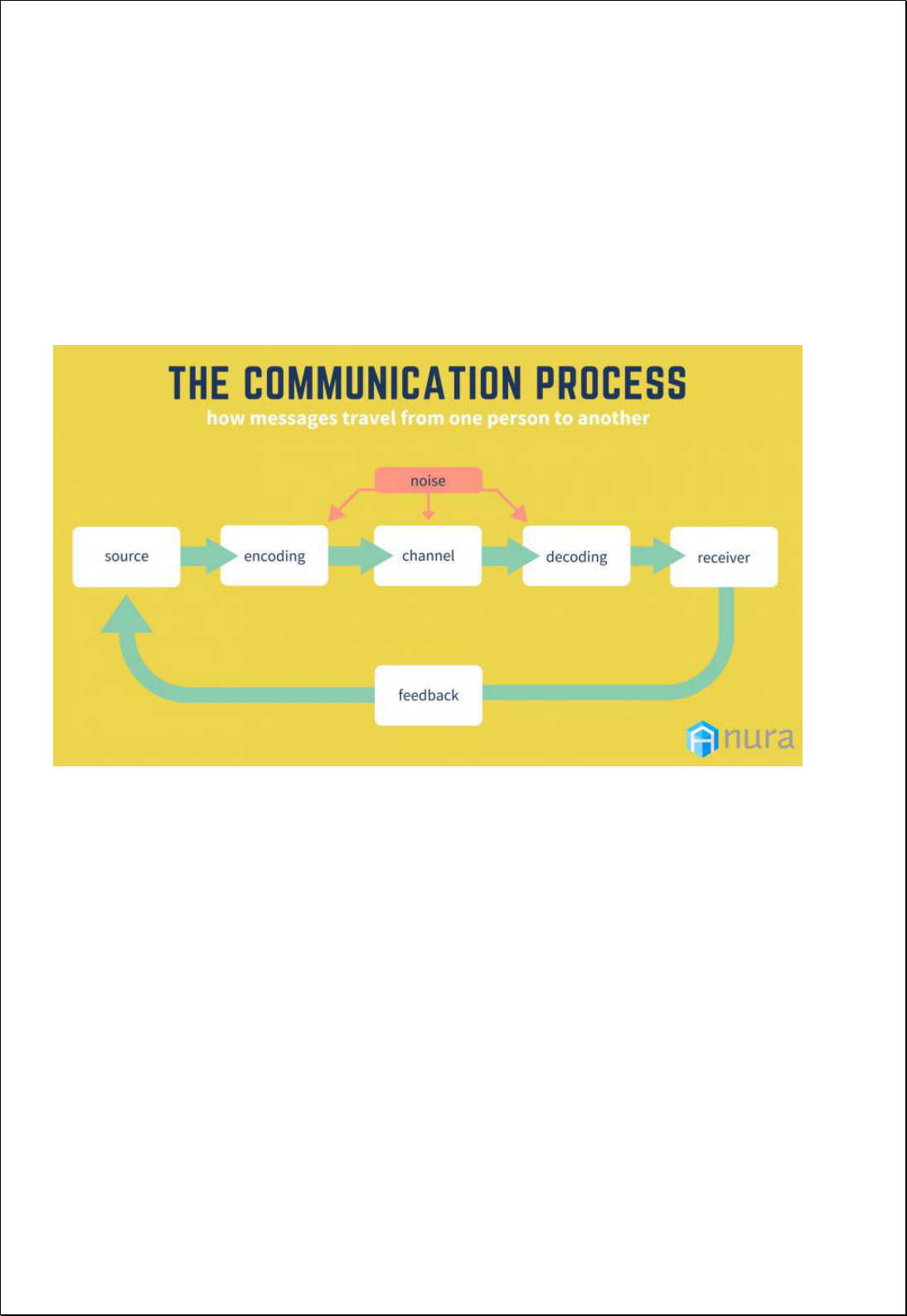
(viii) Interpersonal relations – The main purpose of communication is to influence the human behavior
which creates interpersonal relations.
(ix) Circular process – There is a circular flow of information in the communication process. After the
feedback, the receiver of the original message is required to transmit another message. The response
indicates the success of the communication.
Elements of Communication Process:
The communication is a dynamic process that begins with the conceptualizing of ideas by the
sender who then transmits the message through a channel to the receiver, who in turn gives
the feedback in the form of some message or signal within the given time frame. Thus, there
are Seven major elements of communication process:
1. Sender: The sender or the communicator is the person who initiates the conversation
and has conceptualized the idea that he intends to convey it to others.
2. Encoding: The sender begins with the encoding process wherein he uses certain
words or non-verbal methods such as symbols, signs, body gestures, etc. to translate
the information into a message. The sender’s knowledge, skills, perception,
background, competencies, etc. has a great impact on the success of the message.
3. Message: Once the encoding is finished, the sender gets the message that he intends
to convey. The message can be written, oral, symbolic or non-verbal such as body
gestures, silence, sigh’s, sounds, etc. or any other signal that triggers the response of a
receiver.
4. Communication Channel: The Sender chooses the medium through which he wants
to convey his message to the recipient. It must be selected carefully in order to make
the message effective and correctly interpreted by the recipient. The choice of
medium depends on the interpersonal relationships between the sender and the
receiver and also on the urgency of the message being sent. Oral, virtual, written,
sound, gesture, etc. are some of the commonly used communication mediums.
5. Receiver: The receiver is the person for whom the message is intended or targeted.
He tries to comprehend it in the best possible manner such that the communication
objective is attained. The degree to which the receiver decodes the message depends
The communication process has the following components:
1. Sender or communicator – Sender is an employee with ideas, intentions, information, and a purpose
for communicating. He is the source or initiator of the communication. He has something with a
meaning to communicate. Communication begins when a sender identifies the need to send a
message based on certain reasons.
2. Message – The sender encodes meaning into a message that can be transmitted. The message
represents the meaning, the source is trying to convey.
3. Encoding – The function of encoding is to provide a form in which ideas and purpose can be
expressed as a message. The result of the encoding process is the message. Encoding involves
translating the sender’s intent or ideas into a systematic set of symbols or gestures.
4. Channel or medium – A medium serves as the means of communication whereas a channel refers to
the means of transmission of a message between the sender and the receiver.
A medium, which is an abstraction, can be oral, written, or non-verbal. Channel, on the other hand,
is concrete and could be a letter, a report, a book, a memorandum, fax, an email, the television, the
telephone, etc.
A sender conveys his/her message to the receiver by some medium (oral, written, or non-
verbal) over some channel (electronic means or printed Media).

5. Receiver – The receiver is the individual whose senses perceive the sender’s message. There may be
one or many receivers. If the message does not reach the receiver, communication is not completed.
6. Decoding – Decoding is the process by which the receiver interprets the message and translates it into
meaningful information. Decoding is a two-step process – (a) the receiver must first perceive the
message, and (b) the receiver must then interpret it. The decoding process is very much affected by
some factors such as the receiver’s need, status, experience, situational factors, etc.
7. Communication noise – In communication, noise can be thought of as those factors that disturb or
distort the intended message. Noise may occur in each of the elements of communication. “Noise”
hinders communica-tion.
It includes the following factors:
(a) Factors that hinder the development of clear thought.
(b) Faulty encoding due to ambiguous symbols.
(c) Defects in the channel.
(d) Inattentive reception.
(e) Faulty decoding due to prejudices, wrong under-standing, personal outlook, the wrong meaning of
words and symbols.
Noise can result in miscommunication. Hence the important point is to realize all these possibilities of
noise and to minimize them.
8. Feedback – A feedback provides a link or channel for the communicator to know the receiver’s
response and to determine whether the message has been received and has produced the intended
change.
Feedback may come in many ways. In face-to-face communication, feedback comes through the facial
expressions of the receiver. Some indirect means of feedback are such factors as declines in
productivity, poor quality of production, lack of coordination, absenteeism, etc. Feedback may cause
the sender to modify his future communication.
FORMS OF COMMUNICATION:
There are several types of communication in our practical life. It depends on an organizational pattern;
parties of organization involved; several workers, the pattern of activating, etc. the types of
communication are shown below in a diagram:
A. Based on parties
1. External communication: External communication is the process of exchanging information
with the people of various external or outside parties of the organization. Generally, these
parties are a stakeholder of the organization.
2. Internal communication: Internal communication is the process of exchanging information
among people of different levels or internal participants within the organization.
(i) Horizontal communication: Horizontal communication is the communication where information or
messages flows between or among the parallel or same level or statuses people of the organizational
structure.
(ii) Vertical communication: Vertical communication is the communication where information or
messages flows between or among the subordinates and superiors of the organization.
(i) Downward communication: Downward communication is the communication where information or
messages flows from the top of the organizational structure from the bottom of the organizational
structure.
(ii) Upward communication: Upward communication is the communication where information or
messages flows from the down/bottom of the organizational structure to the top of the organizational
structure.
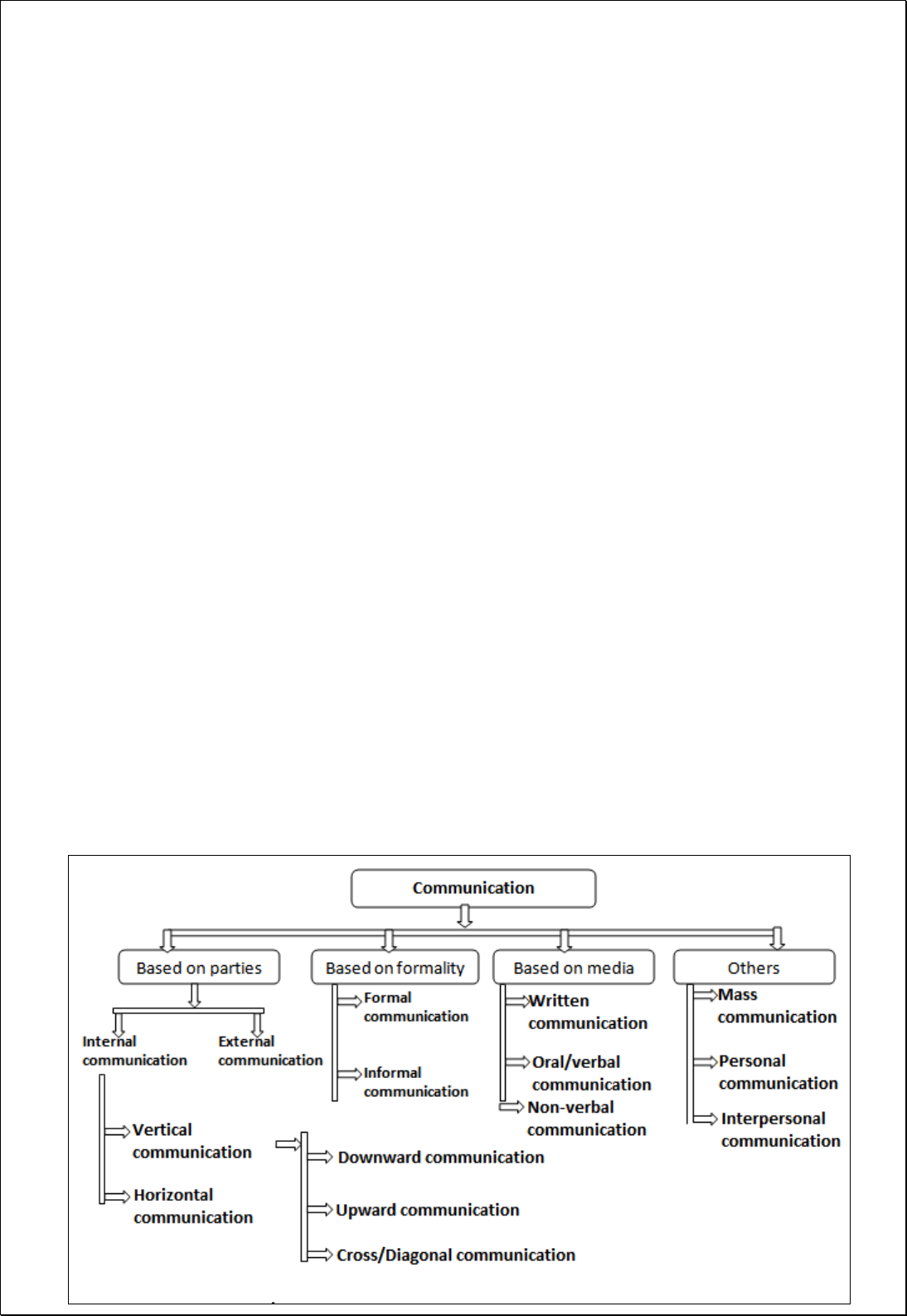
(iii) Cross or diagonal communication: Diagonal or cross-communication occurs when information
flows between persons at different levels who have no direct reporting relationship. It is used to speed
information flow, to improve understanding to coordination etc. for the achievement of the organization.
B. Based on formality
Formal communication: Formal communication is the process of exchanging information by
following the prescribed or official rules, procedures, systems formalities, chain of command
etc. in the organizational structure.
Informal communication: Informal communication is the process of spontaneous exchange of
information among various people of different status in the organizational structure.
C. Based on media
Written communication: Written communication is the process of communication in which
messages or information is exchanged or communicated within sender and receiver through
written form.
Oral or verbal communication: Oral or verbal communication is the process of
communication in which messages or information is exchanged or communicated within
sender and receiver through using any spoken or written word.
Non-verbal communication: Non-verbal communication is the process of communication in
which messages or information is exchanged or communicated within sender and receiver
through without using any spoken or written word.
D. Others
Mass communication: Mass communication is a process of transmitting information,
thoughts, opinions or attitude through specific channel or media to a large number of
heterogeneous audiences.
Personal communication: When people exchanged information related to their personal life
or personal affair is known as personal communication.
Interpersonal communication: Interpersonal communication occurs when two individuals are
involved or exchanging information, ideas, opinions, feelings relating to the personal, social,
organizational, national and international matter who are located in the same place. It is a
process of face-to-face communication between individuals where messages may be verbal
(that is, expressed in words) or they may not involve words at all but consist of gestures, facial
expressions, and certain postures (body language).
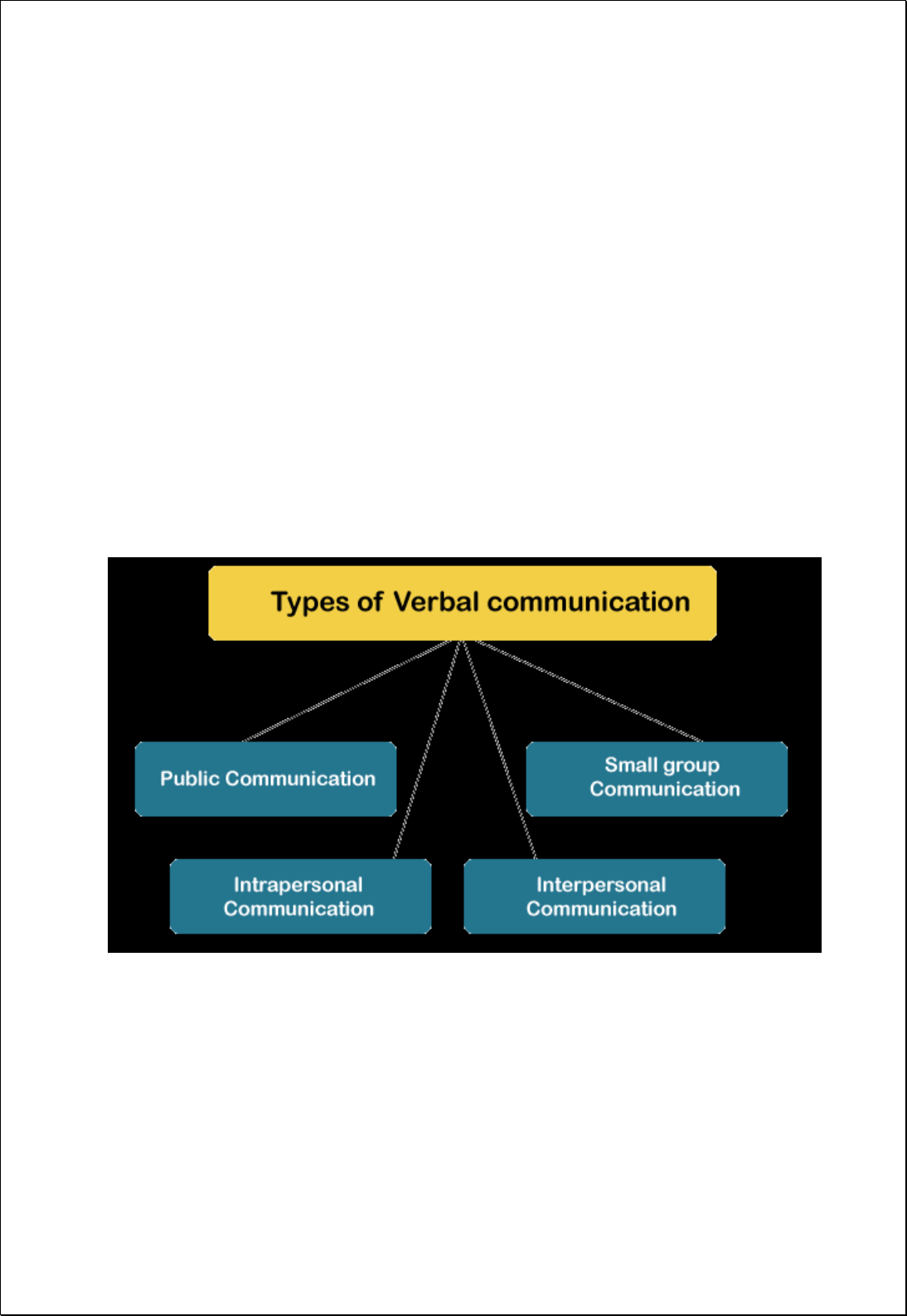
1. Verbal Communication: The communication happens through verbally, vocally or through
written words which express or convey the message to other is called verbal communication.
Example: Baby crying (vocal) is verbal communication which express the hungry or pain through
vocally.
Verbal communication has classified into two types:
A . Oral Communication B. Written Communication.
Apart from oral and written, verbal communication is also has following types:
a. Public Communication, c. Intrapersonal Communication
b. Small Group Communication d. Interpersonal Communication
Types of Verbal Communication:
A. Oral Communication: A communication which happens through word of mouth, spoken
Words, conversations and also any messages or information are shared or exchanged between one
another through speech or word of mouth is called oral communication.
Example: Public speech, News reading, Television, Radio, telephone and mobile conversations.
B. Written Communication: A communication happens through any word written or often
written sign which refers the languages uses in any medium is called written communication.
Example: Simply any hand written, typed, Newspaper, printed word documents, letters, books
and magazines.
There are also other four types of verbal communication, which are listed below:
A. Public Communication: The public communication is defined as the communication of a
person with the public. It involves a massive assembly of people. For example, the Prime
Minister addressing the public about the multiple developing projects; Other examples include
elections, campaigns, public speeches, etc.
B. Small-Group Communication: The small group communication is defined as communication
within two or more people. The number of people participating in such communication is
enough to have a good interaction with each other; For example, school meetings, board
meetings, press conferences, office meetings, team meetings, family gatherings, etc.
C. Intrapersonal Communication: Intrapersonal communication is communication within us. It
is also called as internal communication. It includes self-thinking, analysis, thoughts,
assessments, etc. associated with the inner state of mind.
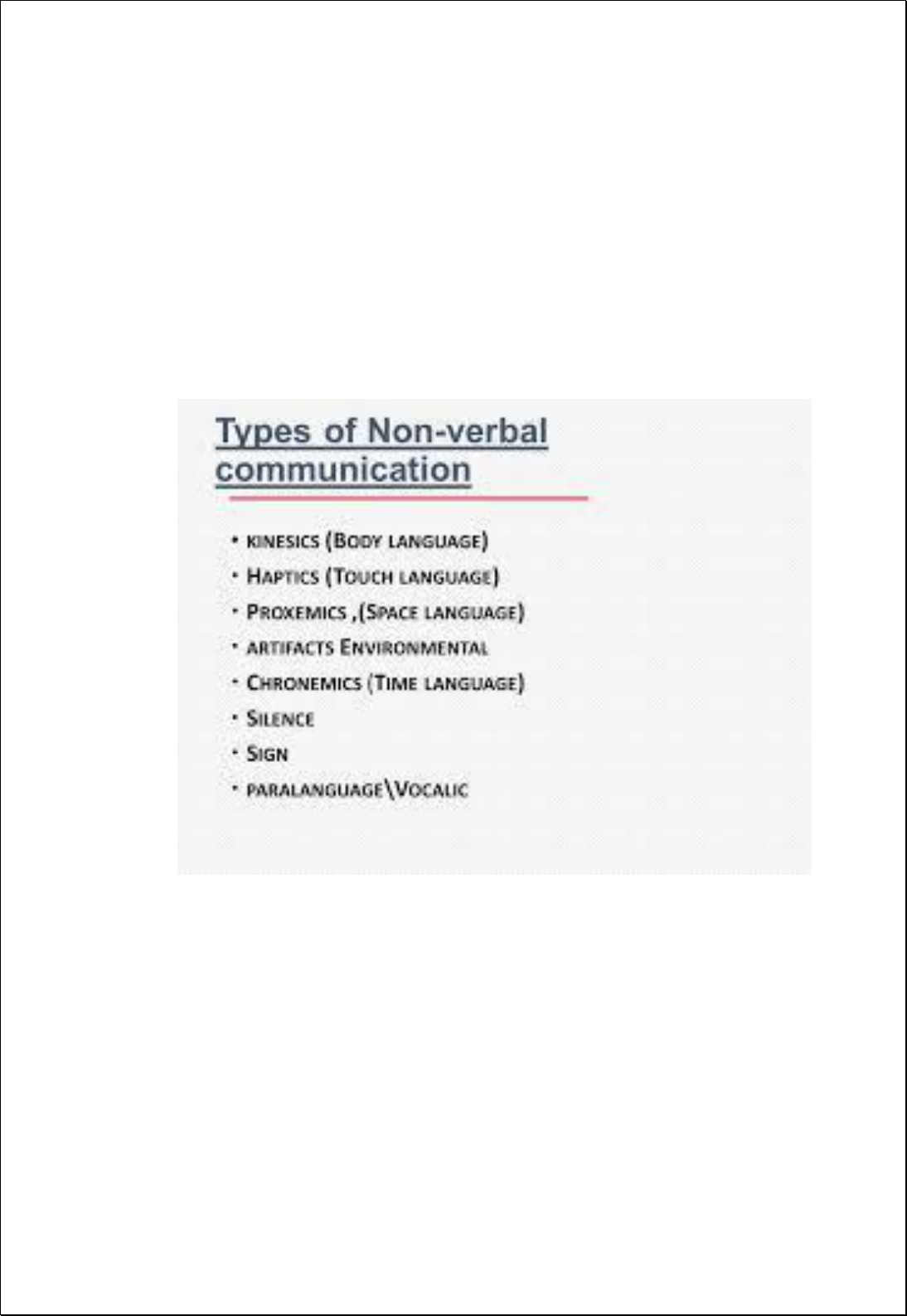
The person's internal thoughts or feelings play a vital role in intrapersonal communication. It
also includes various activities, such as solo speaking, solo writing, solo dancing,
concentration, and self-awareness.
D. Interpersonal Communication: Interpersonal communication is the communication between
us and others over the channel. The communication can be online, face-to-face, video
conference on mobile, etc.
Interpersonal skills are essential, whether we are a manager, employee, or looking for work.
Such skills are also known as soft skills that determine how well a person can communicate,
behave, and relate to others.
2. Non-Verbal Communication: Any communication without word of mouth, spoken words,
Conversation and written languages are called Non-Verbal Communication. It happens through
Signs, symbols, colors, gestures, body language or any facial expressions are known as non-verbal
communication.
Examples: Traffic signals are one of the best examples for non-verbal communication.
TYPES OF NONVERBAL COMMUNICATION
1. Kinesics
Body Movements
Gestures and Body Stance
Facial Expressions
Eyes Movements
2. Proxemics
3. Haptics
4. Chronemics
5. Paralanguage
6. Appearance
7. Artifacts
8. Environment

1. KINESICS:
a. Body language is a type of a nonverbal communication in which physical behaviors are
used to express or convey the information. Such behavior includes facial expressions, body
posture, gestures, eye movement, touch and the use of space. Interpretations of human body
language. It is also known as kinesics.
b. Facial expression is a part of body language and the expression of emotions such as the
movement of the eyes, eyebrows, lips, nose and cheeks. The face displays numerous
emotions such as: Happiness, Surprise, Disgust, Anger, Sadness, etc...
c. Head and neck signals: The body language of the head should be considered in
conjunction with that of the neck. Body language conveyed by the head and neck involves
various ranges of movement. Nodding of the head is generally considered as a sign of
saying 'yes'. Shaking the head is usually interpreted as meaning 'no'.
d. Body postures: Emotions can also be detected through body postures. For example, a
person feeling angry would portray dominance over the other, and their posture would
display approach tendencies. Sitting or standing postures also indicate one's emotions. A
person sitting till the back of their chair, leans forward with their head nodding along with
the discussion implies that they are open, relaxed and generally ready to listen. On the other
hand, a person who has their legs and arms crossed with the foot kicking slightly implies
that they are feeling impatient and emotionally detached from the discussion
e. Gestures - Gestures are movements made with body parts (example hands, arms, fingers,
head, legs) and they may be voluntary or involuntary. Different hand gestures help
emphasize meanings and regulate interaction between or among participants.
For Example: Relaxed hands indicate confidence and self-assurance, while clenched
hands may be interpreted as signs of stress or anger. If a person is wringing their hands,
this demonstrates nervousness and anxiety.
f. Oculesics - Oculesics, a subcategory of body language, is the study of eye movement, eye
behavior, gaze, and eye-related nonverbal communication. Eyes are said to be the window
to the soul. - Through eye contact, one can tell if the other party is paying attention to the
speaker’s words. - It can also help in determining whether one is saying the truth or not. -
Through eye contact we can be able to know one’s emotional condition.
2. PROXEMICS-
Another notable area in the nonverbal world of body language is that of spatial
relationships, which is also known as Proxemics. Introduced by Edward T. Hall in 1966,
Proxemics is the study of measurable distances between people as they interact with one
another.
Hall also came up with four distinct zones in which most men operate:
Intimate distance for embracing, touching or whispering
Personal distance for interactions among good friends or family members
Social distance for interactions among acquaintances
Public Distance used for public speaking.
3. HAPTICS(Touch)-
It is a subcategory of Body Language, and the study of touching as such, handshakes,
holding hands, back slapping, high fives, brushing up against someone or patting someone all
have meaning. Touching is the most developed sense at birth and formulates our initial views
of the world. Touching can be used to sooth, for amusement during play, to flirt, to express
power and maintain bonds between people, such as with baby and mother.
4. CHRONEMICS(Time)–
The use of time in nonverbal communication is formally defined as chronemics. Time
perceptions include punctuality, willingness to wait, and interactions. The use of time can

affect lifestyles, daily agendas, speed of speech, movements and how long people are
willing to listen.
5. PARALANGUAGE–
The attributes of voice like audibility, pleasantness, distinctness, and correctness in
pronunciation, flexibility, etc. help to shape the meaning in oral communication. - These
attributes help in creating meaning. - Paralanguage goes beyond the linguistic form of an
utterance.
Diction, the highness and lowness of tone, intensity, the manner of delivery, rate of
speaking, etc. create the intended meaning of an utterance. - When something is delivered
coupled with gestures and facial expressions may reflect the feeling(s) and/or emotion(s) of
the participant in a communicative situation.
6. APPEARANCE-
Personal appearance refers to the way the audiences with their expectations of
appropriateness, see and evaluate the way you look. The ways you look is all about your
outward appearance of clothing, grooming, and make-ups.
Physical appearance largely determines attractiveness and those who are attractive are more
likely to be considered as more intelligent, more persuasive, and more likeable than the
unattractive ones.
Appearances also include:
*Hairstyles
* Body cleanliness
* Clean Nails
* Shiny shoes
*No tattoos
*Being appropriately dressed
7. ARTIFACTS-
Artifacts are forms of decorative ornamentation that are chosen to represent self-
concept. They can include rings and tattoos, but may also include brand names and logos.
From clothes to cars, watches, briefcases, purses, and even eyeglasses, what we choose to
surround ourselves with communicates something about our sense of self. They may project
gender, role or position, class or status, personality, and group membership or affiliation.
8. ENVIRONMENT-
Environment involves the physical and psychological aspects of the communication
context. The perception of one’s environment influences one’s reaction to it. For example,
Google is famous for its work environment, with spaces created for physical activity and
even in-house food service around the clock. The expense is no doubt considerable, but
Google’s actions speak volumes. The results produced in the environment, designed to
facilitate creativity, interaction, and collaboration, are worth the effort.
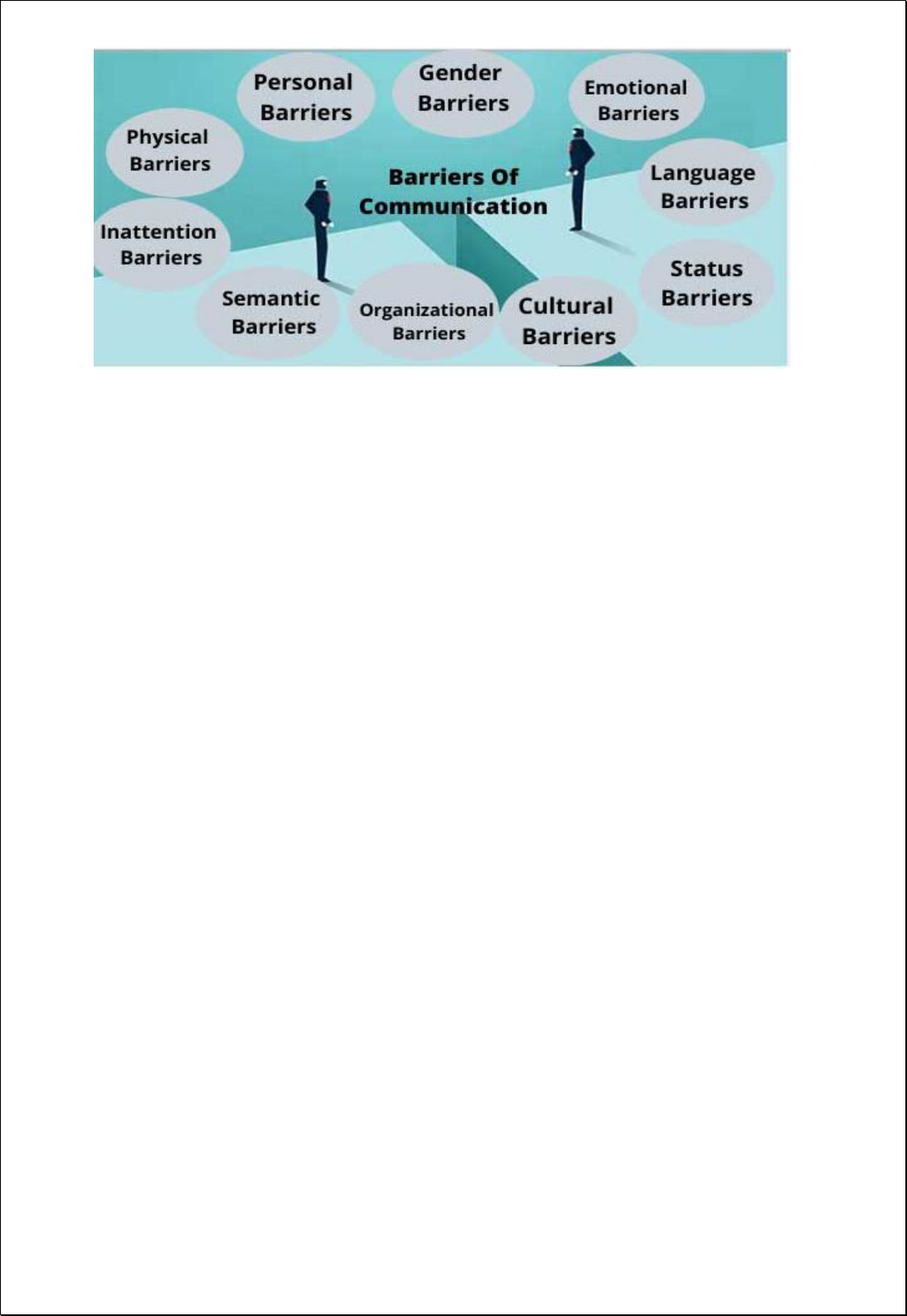
BARRIERS TO COMMUNICATION:
The barrier of communication is such a part that you have to keep in mind during every communication.
Even after taking care of every other detail during the conversation, some misunderstandings remain
during communication. Therefore, we must keep in mind some communication barriers to eliminate
misunderstandings.
Barriers during communication can be of many types such as linguistic barriers, physical barriers,
Personal barriers, Gender barriers, Emotional barriers, Language Barriers, Status Barriers, Cultural
Barriers, Organizational Barriers, Semantic Barriers, and Inattention Barriers and many more barriers.
1. Physical Barriers: It is also caused by barrier distance. Suppose that the person sending the
message is far away from the recipient. And communication is happening between the two. The
barrier arises due to him not being heard clearly because of far distance.
2. Personal Barriers: The personal factors of both sender and receiver may exert influence on
effective communication. These factors include life experiences, emotions, attitudes, behavior that
hinders the ability of a person to communicate.
3. Gender barriers: Gender barrier is also a type of barrier, such as male and female in an
organization, people of both genders work. Societal stereotypes, assumed gender roles, and
interpersonal differences can contribute to a communication gap between the gender and there is a
rift between people due to gender. For Example: Women are focused on relationships and men are
focused on tasks.
4. Emotional Barriers: The emotional barrier changes according to our mood. Emotional barriers are
due to mental limitations created by one’s own self. Emotional Barriers are the mental walls that
keep you from openly communicating your thoughts and feeling to others.
5. Language Barriers: Language barriers are the most common communication barriers which cause
misunderstandings and misinterpretations between people. ... Not using the words that other person
understands makes the communication ineffective and prevents message from being conveyed.
6. Status Barriers: People often have difficulty navigating status differences when trying to inform
or persuade others. To many, social status is an indicator of credibility and legitimacy, and this
effects how seriously others take what one communicates. Status differences can create a bias
against those with the perceived lower status.
7. Cultural Barriers: Past experiences, perception, and cultural background greatly affect the way
people talk and behave. Culture plays an important role in shaping the style of communication. ...

The culture in which individuals are socialized influences the way they communicate, and the way
individuals communicate can change the culture.
8. Organizational Barriers: Inside the organization, there are many things inside which a
communication barrier is created. Just like the policy of the organization, about the rule and regulation
of the organization, about the status, the facility, there are many other things which cause a lot of
barriers.
9. Semantic Barriers: Semantic barriers to communication are the symbolic obstacles that distort the
sent message in some other way than intended, making the message difficult to understand. The
meaning of words, signs and symbols might be different from one person to another and the same
word might have hundreds of meanings.
10. Inattention barriers: Sometime the persons do not pay adequate attention to the message. They
do not listen, the spoken words attentively. The communication has no impact on those who are
unwilling to listen. Inattention arises due to lack of interest, over stimulation and time pressure.
OVERCOME BARRIERS OF COMMUNICATION
Eliminating differences in perception: Seek clarity: if we are unclear about expectations,
assumptions, preferences or beliefs of another person in an interaction, confusion may arise. The key
to overcoming perceptual barriers is asking questions to gain a sense of clarity and ensure that you
and the other person are on the same page.
Use of Simple Language: Use of simple and clear words should be emphasized. Use of ambiguous
words and jargons should be avoided.
Reduction and elimination of noise levels: Noise is the main communication barrier which must be
overcome on priority basis. It is essential to identify the source of noise and then eliminate that
source.
Active Listening: Listen attentively and carefully. There is a difference between “listening” and
“hearing”. Active listening means hearing with proper understanding of the message that is heard.
By asking questions the speaker can ensure whether his/her message is understood or not by the
receiver in the same terms as intended by the speaker.
Emotional State: During communication one should make effective use of body language. He/she
should not show their emotions while communication as the receiver might misinterpret the message
being delivered. For example, if the conveyer of the message is in a bad mood then the receiver
might think that the information being delivered is not good.
Simple Organizational Structure: The organizational structure should not be complex. The number
of hierarchical levels should be optimum. There should be a ideal span of control within the
organization. Simpler the organizational structure, more effective will be the communication.
Avoid Information Overload: The managers should know how to prioritize their work. They should
not overload themselves with the work. They should spend quality time with their subordinates and
should listen to their problems and feedbacks actively.
Give Constructive Feedback: Avoid giving negative feedback. The contents of the feedback might be
negative, but it should be delivered constructively. Constructive feedback will lead to effective
communication between the superior and subordinate.
Proper Media Selection: The managers should properly select the medium of communication. Simple
messages should be conveyed orally, like: face to face interaction or meetings. Use of written means
of communication should be encouraged for delivering complex messages. For significant messages
reminders can be given by using written means of communication such as : Memos, Notices etc.
Flexibility in meeting the targets: For effective communication in an organization the managers
should ensure that the individuals are meeting their targets timely without skipping the formal
channels of communication. There should not be much pressure on employees to meet their targets.

GUIDELINES FOR EFFECTIVE COMMUNICATION:
Effective communication is a part and parcel of any successful organization. A communication should
be free from barriers so as to be effective. Communication is a two way process where the message
sent by the sender should be interpreted in the same terms by the recipient. The characteristics of
effective communication are as follows:
1. Clarity of Purpose: The message to be delivered must be clear in the mind of sender. The
person to whom it is targeted and the aim of the message should be clear in the mind of the
sender.
2. Completeness: The message delivered should not be incomplete. It should be supported by
facts and observations. It should be well planned and organized. No assumptions should be
made by the receiver.
3. Conciseness: The message should be concise. It should not include any unnecessary details. It
should be short and complete.
4. Feedback: Whether the message sent by the sender is understood in same terms by the receiver
or not can be judged by the feedback received. The feedback should be timely and in personal.
It should be specific rather than general.
5. Empathy: Empathy with the listeners is essential for effective verbal communication. The
speaker should step into the shoes of the listener and be sensitive to their needs and emotions.
This way he can understand things from their perspective and make communication more
effective.
6. Modify the message according to the audience: The information requirement by different
people in the organization differs according to their needs. What is relevant to the middle level
management might not be relevant to the top level of management. Use of jargons should be
minimized because it might lead to misunderstanding and misinterpretations. The message
should be modified according to the needs and requirements of the targeted audience.
7. Multiple Channels of communication: For effective communication multiple channels should
be used as it increases the chances of clarity of message. The message is reinforced by using
different channels and there are less chances of deformation of message.
8. Make effective use of Grapevine (informal channel of communication): The employees and
managers should not always discourage grapevine. They should make effective use of
grapevine. The managers can use grapevine to deliver formal messages and for identification of
issues which are significant for the employees. The managers can get to know the problems
faced by the employees and can work upon it.
BUSINESS WRITING:
Business writing is a type of writing that is used in a professional setting. It is a purposeful piece of
writing that conveys relevant information to the reader in a clear, concise, and effective manner. It
includes client proposals, reports, memos, emails, and notices. Proficiency in business writing is a
critical aspect of effective communication in the workplace.
BUSINESS MESSAGES
Business messaging is a set of channels over which companies and consumers can communicate with
each other. The most common messaging channel is SMS or text messaging.
TYPES OF BUSINESS MESSAGES
This division is based in accordance with the effect it has on the reader Concept
1. POSITIVE Messages: Convey good feeling Letters of appreciation, thanks giving,
expression of interest, sympathy, etc.
2. NEGATIVE Messages: Convey disappointment, disapproval, dissatisfaction Letters of
disapproval, disagreement, denial, refusal, job denials, cancellation, etc.
3. NEUTRAL Messages: Convey no feeling; contain information, necessitating action
Day-to-day messages, reports, routine letters, reminders, proposals, etc.

4. PERSUASIVE Messages: Action demanding communication system, agreement with
the writer’s point of view Memoranda of Interests, Invitations, Brochures, etc.
DIRECT AND INDIRECT APPROACHES TO BUSINESS MESSAGES
Regardless of the more popular methods of communication, such as e-mail and other social
media exchanges, letters remain the most formal and legal type of written business
communication.
Five types of business letters are thank you letters, claim letters, adjustment letters, inquiry
letters, and transmittal letters.
These letters can be written in a direct approach or an indirect approach.
Most claim letters, inquiry letters, and transmittal letters are written in a direct approach, where
the writer refers to background, stating his/her purpose for writing in the opening sentences of
the first paragraph.
The indirect approach is used for letters that have negative messages. These types of letters are
letters that deny requests, such as adjustment letters that deny claims or letters that deny
employment applications.
After referring to background, the writer using the indirect approach adds a disclaimer that is
intended to soften a negative decision. The second paragraph states and explains the purpose of
the decision. This arrangement is a respectful, professional way to deliver a negative message.
DIRECT APPROACH:
When you use the direct approach, the main idea (such as a recommendation, conclusion, or
request) comes in the "top" of the document, followed by the evidence.
This is a deductive argument. This approach is used when your audience will be neutral or
positive about your message.
In the formal report, the direct approach usually mandates that you lead off with a summary of
your key findings, conclusions, and recommendations.
This "up-front" arrangement is by far the most popular and convenient for business reports. It
saves time and makes the rest of the report easier to follow.
For those who have questions or want more information, later parts of the report provide
complete findings and supporting details.
The direct approach also produces a more forceful report. You sound sure of yourself when you
state your conclusions confidently at the outset.
INDIRECT APPROACH:
In the indirect approach, the evidence is presented first, leading therefore to the main idea.
This is an inductive argument. This approach is best if your audience may be displeased about
or may resist what you have to say.
At times, especially if you are a junior member of an organization or if you are an outsider,
writing with an extremely confident stance may be regarded as arrogant.
In such cases, or if your audience will be skeptical or hostile, you may want to use the indirect
approach: Introduce your complete findings and discuss all supporting details before presenting
your conclusions and recommendations.
The indirect approach gives you a chance to prove your points and gradually overcome your
audience’s reservations. By deferring the conclusions and recommendations, you imply that
you’ve weighed the evidence objectively without prejudging the facts.
You also imply that you’re subordinating your judgment to the audience, whose members are
capable of drawing their own conclusions when they have access to all the facts.

Although the indirect approach has its advantages, some readers will always be in a hurry to
get to "the answer" and will flip to the recommendations immediately, thus defeating your
purpose.
Conclusion:
Therefore, consider length before choosing the direct or indirect approach. In general, the longer
the message, the less effective an indirect approach is likely to be. Furthermore, an indirect
argument is harder to follow than a direct one. Because both direct and indirect approaches have
merit, businesspeople often combine them. They reveal their conclusions and recommendations as
they go along, rather than putting them first or last. As a result, the approach strategy of business
reports can sometimes be hard to classify.
Two Sample Introductions for Formal Reports
1. Direct Approach (assumes audience will favour or be neutral to your recommendations),
Since the company’s founding 25 years ago, we have provided regular repair service for all our
electric appliances. This service has been an important selling point as well as a source of pride
for our employees. However, we are paying a high price for our image. Last year, we lost
$500,000 on our repair business.
Because of your concern over these losses, you asked me to study the pros and cons of
discontinuing our repair service. With the help of John Hudson and Susan Lefkowitz, I have
studied the issue for the last two weeks and have come to the conclusion that we have been
embracing an expensive, impractical tradition.
By withdrawing from the electric appliance repair business, we can substantially improve our
financial performance without damaging our reputation with customers. This conclusion is based
on three main points that are covered in the following pages:
I. It is highly unlikely that we will ever be able to make a profit in the repair business.
II. Service is no longer an important selling point with customers.
III. Closing down the service operation will create few internal problems.
2. Indirect Approach (assumes audience will be hostile to or resistant to your recommendations or
that you are much lower in the organizational power structure than the primary reader)
Since the company’s founding 25 years ago, we have provided regular repair service for all our
electric appliances. This service has been an important selling point as well as a source of pride
for our employees. However, the repair business itself has consistently lost money.
Because of your concern over these losses, you asked me to study the pros and cons of
discontinuing our repair service. With the help of John Hudson and Susan Lefkowitz, I have
studied the issue for the last two weeks. The following pages present my findings for your
review. Three basic questions are addressed:
I. What is the extent of our losses, and what can we do to turn the business around?
II. Would withdrawal of this service hurt our sales of electric appliances?
III. What would be the internal repercussions of closing down the repair business?
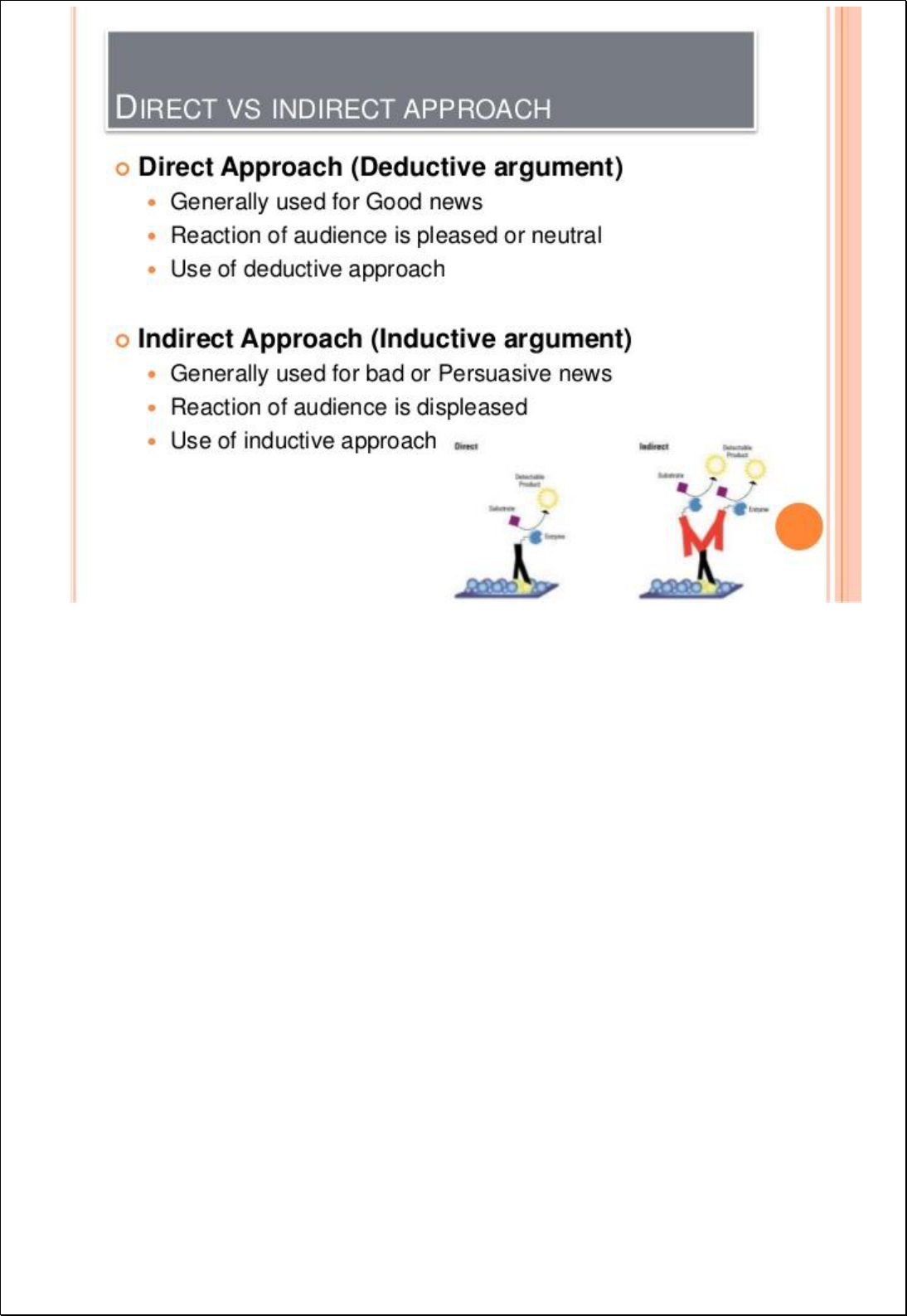
FIVE MAIN STAGES OF WRITING BUSINESS MESSAGES:
Writers have their own writing process as per their preference and they follow those steps
naturally. Whenever they get stuck with some tough topics, they follow the steps which are
familiar to all to stimulate their ideas in a right manner. It starts with prewriting and ends with
publishing. However, 5 basic stages of the writing process are prewriting, drafting, revising,
editing and publishing.
Each stage is precisely discussed here to represent a clear perception about the entire process of
writing.
1.Prewriting: Prewriting is important as it is the first stage, where a writer chooses the topic and
narrow down the points as well as he determines the purpose of his writing. Additionally, the
writer should consider his audience whom he needs to address. Find your idea and then try to
develop your idea and accumulate pertinent information that supports your idea. The next step is to
plan and structure your idea.
2. Drafting: Drafting is nothing but putting your points and ideas on paper and arrange these
points in a readable manner. Writers usually research about their topics at the prewriting stage and
then they accumulate the entire information at this stage. First, the writers do a rough draft and
then they try to arrange their points in a best possible way and gradually prepare a final draft.
3. Revising: Revising is another imperative stage, where a draft is scrutinized thoroughly and
points incorporated in the draft are rearranged. At this stage, new points are added and some points
are replaced and removed as per the requirements. However, revision is indispensable to make the
outlook of the writing catchy and cogent.
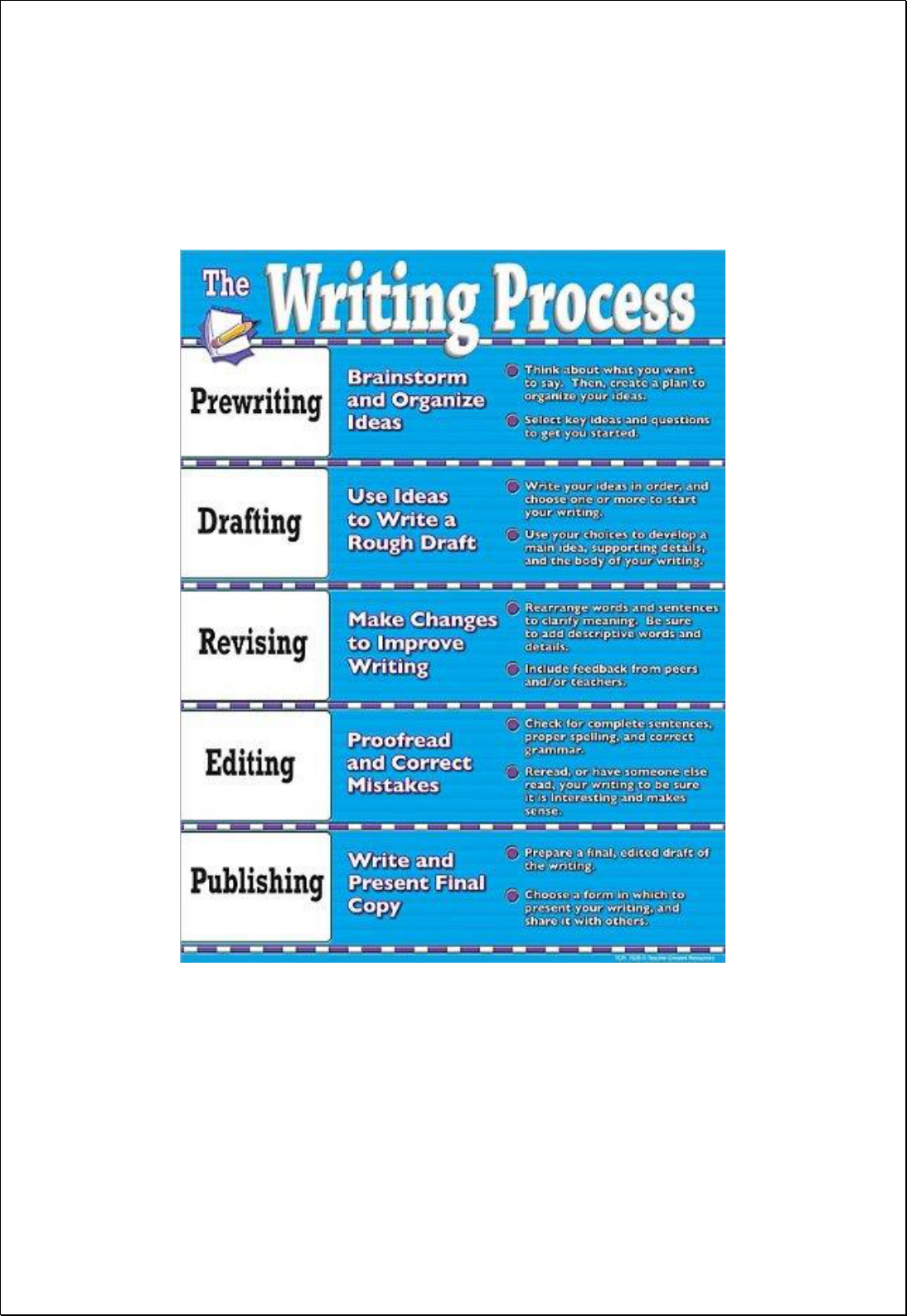
4. Editing: Fine the tone of the writing and check each line thoroughly. Check spelling, grammar,
punctuation, sentence structure, document format and other things. Check the entire content as
mistakes should not leave behind. However, editing is the stage where writers can modify their
lines as well as theme. It is always better to give your writing to someone for editing.
5. Publishing: Publishing is the last stage where writers submit their work to the publisher. Make
sure your written document should be completed before giving to the publisher. However, each
writer’s goal is to publish his work and reach to the readers.
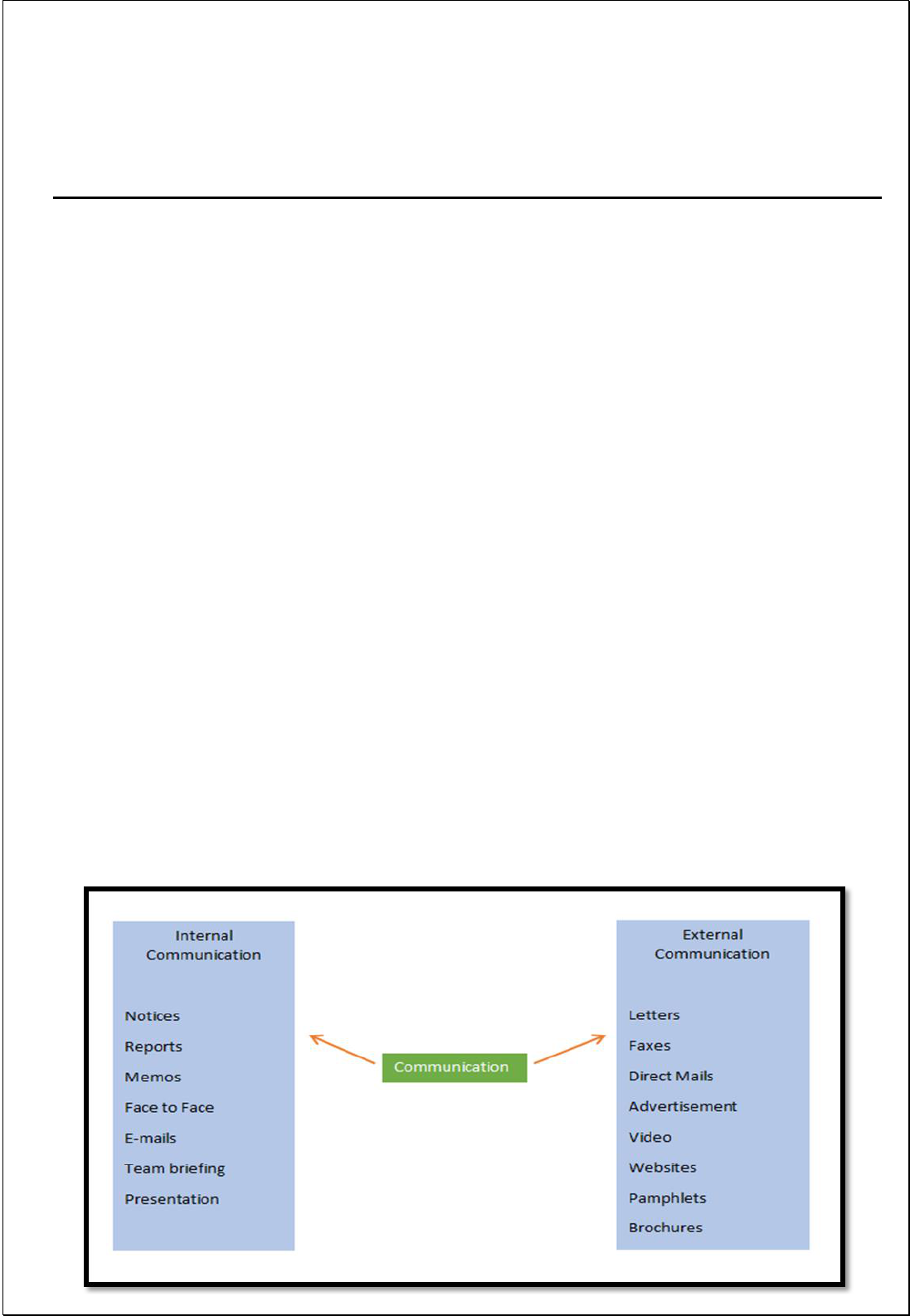
UNIT-II
Unit-II: Written Business Communication
External Communication: The Seven C’s of Letter writing - Kinds of Business Letters - Business
Reports and Proposals - Purpose of Business Reports.
Internal Communication: Format and Principles of writing Memos - General Warning - Cautions.
External Communication
External communication is the transmission of information between two organizations. It also occurs
between a business and another person in the exterior to the company.
These persons can be clients, dealers, customers, government officials or authorities etc. A customer’s
feedback is also external communication. An organization invests a lot of time and money to improve
their image through external communication.
Effective External Communication
One can easily find the importance of external communication. Some of them are
Clear ideas, thoughts, and statement or the reason for communication.
It must be two-way communication.
Clear, error-free, formal, jargon-free, and easy language.
Understanding the need of the audience.
Proper choice of words for communication.
Importance of External Communication
It presents a favourable image of an organization.
It provides information about products and services to customers.
Advertise the organization.
Promote an organization
Reduces the risks of mistakes.
Common External Communication
Advertisement of an organization.
Response to a customer.
Press conference.
Annual reports and letters.
Print media.
Face to face meeting of two organization heads.
Tender documents.
Brochures.
Feedbacks.
Questionnaire.
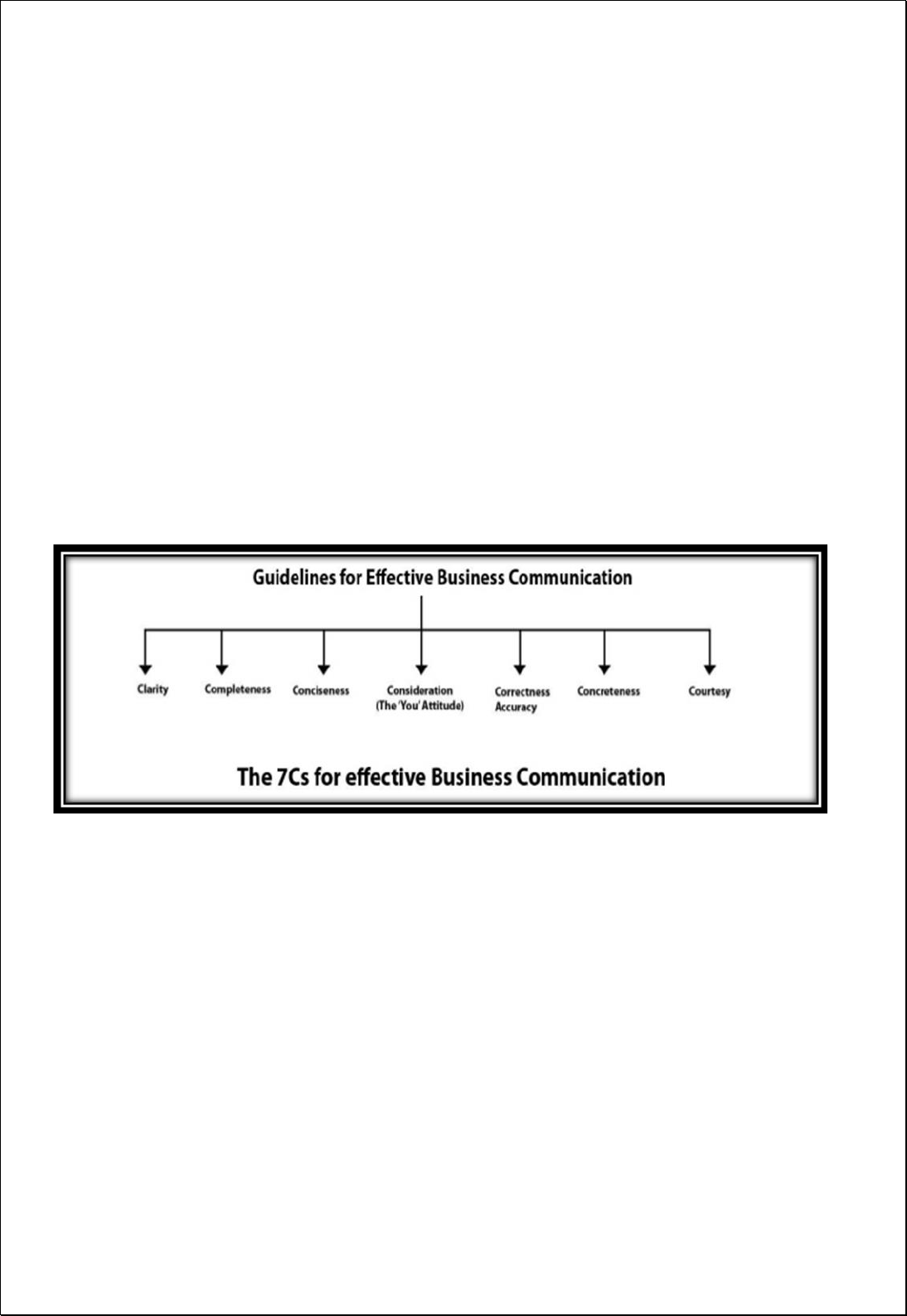
The Seven C’s of Letter writing:
The Seven C’s are also known by the name of the “Principles of Effective Communication (EBC)”, and
called Seven C’s because every letter begins with the name of C and they are seven in number.
Although they are just seven small words beginning with a letter “C” but their importance for effective
business communication is same as the importance of seven seas for the world.
Importance Seven C’s
The Seven C’s can be applicable for the both sort of Communication i.e., Oral and Written.
To compose an effective Written or Oral message these Principles provide us the guide lines, that how an
effective message can be written to stimulate the reader for the desired Outcome/Output/results.
The Seven C’s has a much wider scope because these are applicable for each and every one during the
course of a whole day. Weather is he giving presentation, facilitate meetings, participating in conference
calls, doing conversation with his/her fellows, chatting, playing, etc.“The message is said to be effective
when the receiver understands the same meaning that the sender was intended to convey”.
For any communication in business, in order to be an effective, it must have these seven qualities.
1. Completeness 2.Conciseness 3.Consideration 4.Concreteness 5.Clarity 6.Courtesy
7. Correctness
1.Completeness:
By completeness means “the message must bear all the necessary information to bring the response
you desire”. One of the most famous terms use under this title is the “5’w’s”. 5’w’s includes Who,
What, When, Where and Why.
The 5’w’s means while composing an effective message we have to think about the receiver (You
Attitude). And also have to answer each of the above5’w’s.
The five-question method is useful when you write requests, announcements, or other informative
messages. For instance, to order (request) merchandise, make clear WHAT you want, WHEN u need
it, WHERE it is to be sent.
While composing an effective message we have to bear the following points in mind.
• Provide all necessary information.
• Answer all questions asked.
• Give something extra, when desire.
Benefits of Completeness:
Complete messages are more likely to produce desired results.
They can do a better job of building goodwill.
Complete messages help to avert the costly lawsuits.

2. Conciseness:
Conciseness means “The message only contains the information only relating to the topic and don’t
have irrelevant information.” And writer also strives to make the small and simple sentence which are
easily understandable by receiver. A concise message saves time of both the sender and the receiver.
Conciseness in a business message can be achieved by avoiding wordy expressions and repetition.
Achieving conciseness does not mean to loosen completeness of message.
While composing a conciseness in message we have to bear following points in mind.
• Eliminate wordy expressions.
• Include only relevant stuff.
• Avoid unnecessary repetition.
Benefits of Conciseness:
Conciseness saves time of both the sender and receiver.
Concise communication provides short and essential message in limited words to the
receiver/audience.
Concise message is more appealing and comprehensible to the receiver/audience.
Concise message is non-repetitive in nature.
3. Consideration:
“Consideration demands to put oneself in the place of receiver while composing a message”. It refers
to the use of “You Attitude”, emphases positive and pleasant facts, visualizing reader’s problems,
desires, emotions and his/her response.
Effective communication must take the receiver/audience into consideration, i.e., the
receiver/audience’s viewpoints, background, mind-set, education level, etc.
Ensure that the self-respect of the audience is maintained and their emotions are not at harm. Modify
your words in message to suit the receiver/audience’s needs while making your message complete and
meaningful.
Example of You Attitude:
1. We-Attitude: I am delighted to announce that we will be extending our hour to make shopping
more convenient.
2. You-Attitude: You will be able to shop evening with the extended hours.
While composing a Consideration in message we have to bear following points in mind.
• During the process of Consideration we have to understand the level of receiver.
• Focus only on the related stuff.
• Emphasize on the positive facts.
• Avoid from the negative facts as much as we can.
Benefits of Consideration:
Pose the good and pleasant effect.
Whenever next time same reader read this, he will read like a word view.
Length of the message is short which saves time both sender and receiver.

4. Concreteness:
“Being definite, vivid and specific rather than vague, obscure and general leads to the concreteness of
the message”.
Facts and figures being presented in the message ought to be specific.
Often it means using denotative (direct, explicit, often dictionary-based) rather than connotative words
(ideas or notions suggested by or associated with a word or phrase).
While composing Concreteness in a message we have to bear the following points in mind.
• Use specific facts and figures.
• Put actions in our verbs.
• Choose vivid, image-building words.
Benefits of Concreteness:
Concreteness reinforces confidence.
It is supported by specific facts and figures.
It makes use of words that are clear and that build the reputation.
It creates a positive and pleasant effect on the reader.
5. Clarity:
“Clarity demands the simple language and easy sentence structure in composing the messages”. When
there is clarity in presenting ideas, it’s easy for the receiver/decoder to grasp the meaning being
conveyed by the sender/encoder.
Clarity also implies emphasizing a specific message or goal at a time, rather than trying to achieve too
much at once. When we have a choice between an along word and a short one, always use the short,
familiar words that our reader or listener will frequently understand.
While Composing the Clarity in the message we have to bear the following points in our mind.
• Choose precise, concrete, and familiar words.
• Construct effective sentences and paragraphs.
• Use simple words rather than jargon words.
The benefit of the Clarity:
Clarity makes comprehension easier.
Complete clarity of thoughts and ideas enhances the meaning of the message.
A clear message makes use of exact, appropriate, and concrete words.
The clarity in the message stimulates the receiver/buyer for an action.
6. Courtesy:
“Doing well with good intentions” called Courtesy. In business, almost everything starts and ends in
courtesy. Courtesy means not only thinking about the receiver but also valuing his feelings, emotions
& attitudes. Much can be achieved by using Euphemism (polite and decent language), gestures, being
appreciative, thoughtful, tactful, and showing respect to the receiver.
Besides, the following guidelines discussed under CourteousCommunication generate a special
Euphemism tone in the writing or speaking message.
Here the following suggestions for generating a courteous tone.
• Be sincerely tactful, thoughtful, and appreciative.
• Use expressions that show respect.
• Choose non-discriminatory expressions.
• Omit questionable Humour.

Benefits of Courtesy:
Courtesy creates goodwill.
Courtesy strengthens relations.
Courtesy implies taking into consideration both viewpoints as well as feelings of the receiver of
the message.
Courteous message is positive and focused at the receiver/audience.
It makes use of terms showing respect for the receiver of message.
It is not at all biased.
7. Correctness:
The core of Correctness means “sentence ought to be proper grammatical, punctuation, and well spell”
or free from any sort of errors.
At the time of encoding, if the encoder has comprehensive knowledge about the decoder of message, it
makes the communication an ease. The encoder should know the status, knowledge and educational
background of the decoder.
However, a message may be perfect grammatically & mechanically but still insult or lose a customer.
The term correctness, as applied to business messages also means the following three characteristics.
Use the right level of language.
Check accuracy of figures, facts and words.
Maintain acceptable writing mechanics.
While composing the Correctness in message we have to bear the following points in mind.
• Eradicates the confusing words like, accept, except, affect, effect, farther, further, lay, laid, lain
etc.
• Sometimes informal words are to use than formal words.
• e.g., Participate /Join, Procure /Get, Deem/Think (Believe), Endeavour/Try.
Benefits of Correctness:
Correctness in message helps in building confidence.
The message is exact, correct and well-timed.
If the communication is correct, it boosts up the confidence level.
It checks for the precision and accurateness of facts and figures used in the message.
It makes use of appropriate and correct language in the message.
Kinds of Business Letters
The term “business letters” refers to any written communication that begins with a salutation, ends
with a signature and whose contents are professional in nature. Historically, business letters were sent
via postal mail or courier, although the internet is rapidly changing the way businesses communicate.
There are many standard types of business letters, and each of them has a specific focus.
Here are some of the most commonly used types of business letters:
1. Cover letters
Cover letters accompany your application when applying for a new position. You can use cover letters
to introduce yourself, describe your interest in a company and outline your qualifying skills. A cover
letter will include the following:
Contact information
Include your name, phone number and email address on the cover letter to ensure the reader knows
how to contact you after reviewing your application.

Salutation
Begin the letter by addressing the person to which you are writing the letter. This person may be the
hiring manager, department head or other company representative identified in the job listing.
Purpose of the letter
In your introduction, discuss why you are writing by mentioning the job title, the company name and
where you found the job listing.
Qualifying skills
In the body of your letter, highlight the specific skills that make you a strong candidate for the open
position. Your cover letter should complement your resume, so build off of the information in your
resume to provide more specific details of your professional experience.
Conclusion
End the cover letter with a memorable statement about why you are a good fit for the open position.
Include a call-to-action to encourage the reader to follow up on your application should they want to
interview you and learn more about how you could fit into their company.
2. Letters of recommendation
A letter of recommendation is written by another person who can confirm a professional’s
qualifications and work ethic. A letter of recommendation can strengthen an application for
employment, higher education or another professional opportunity. This letter often includes the
following information:
Relationship of the recommendation
The letter should state the relationship of the person making the recommendation to ensure the reader
knows what qualifies the writer to speak on the applicant’s behalf. Those who write these letters might
include a professor, supervisor or co-worker.
Evaluation of the candidate’s qualifications
The recommendation is often the body of the letter and speaks directly to the candidate’s skills,
positive character traits, professional goals and their potential in the program or position.
Examples
The writer can include specific examples of how the candidate demonstrated their skills during their
time working, studying or otherwise interacting with each other. This information can help prospective
employers understand how the candidate positively impacts their peers and supervisors.
Closing statement
It should conclude with a final confirmation of the candidate’s qualifications and include the writer’s
contact information should the reader want to know more.
3. Interview follow-up letters
You can send a follow-up letter after interviewing for an open position to thank the interviewer for
their time and to demonstrate your interest in the job further. A follow-up letter will include the
following:
Overview of the interview
Include key topics discussed during the interview, such as specific job tasks or a talking point that
interested you. Be sure to mention the title of the position. These details demonstrate active listening
while expressing your continued interest in the open position.
Skills related to the position
The follow-up letter is a good time to reiterate the skills you offer as they relate to the open position.
Gratitude
You can also use the follow-up letter to thank the hiring manager for taking the time to meet with you.
This step shows professional courtesy that can leave a good impression on your prospective employer.
4. Offer letters
An offer letter is an official offer of employment that describes the specific terms of the position. If
you agree to the terms the letter offers, then you will sign the offer letter and accept the job.

An offer letter will usually include the following:
Job description: This item outlines the specific job tasks and requirements of the role.
Job title: A letter that states the official name of the position can ensure you are hired for the
right role.
Requested start date: This is the date on which you will begin employment. You may discuss
with your employer if you need to adjust the date.
Salary and benefits: This information includes the offered salary, bonus and benefits that
come with the role. Some employers may specify when bonuses are given and benefits, such as
health care, begin.
Acceptance timeline: This is the date by which you must respond to the offer letter.
5. Sales letters
The purpose of a sales letter is to introduce a service or product to a client or customer. Sales
professionals often use these letters when making new contacts with prospective buyers or
strengthening relationships with long time clients.
A sales letter often includes the following:
Description of product or service
Include specific details about the item or service you are offering. Consider identifying a possible
solution this product or service provides to the recipient to best demonstrate its value.
Cost
Some letters include information about the price of the product or service, especially if the buyer is a
current patron. It may be included if the cost was already discussed in a previous meeting as well.
Call to action
Include directions to the reader explaining how they should take action if they want to buy. You may
include your contact information, the best times to reach you and a date by which they should reply to
take advantage of your offer.
6. Letters of commendation
Letters of commendation are a form of employee appreciation, and companies send them out to the
entire staff to congratulate an employee for a job well done. They may include the following:
Purpose: Begin a letter of commendation identifying who is being commended and for what
reason.
Details of the commendation: Include details about the specific tasks, achievements or awards
for which the team member is being recognized.
Call to action: This letter may include a call to action that encourages fellow employees to
congratulate the team member on their success.
7. Letters of resignation
A letter of resignation informs your employer of your intent to resign. While you may verbally notify
your co-workers and employer of your plans to leave, many organizations prefer to have an official
letter for documentation purposes.
A letter of resignation often includes the following:
Statement of resignation
Begin this letter with the official statement declaring that you are resigning from the company.
Reason for leaving
Depending on your situation, you may consider mentioning why you are leaving so your employer
understands your decision. This may include accepting an opportunity elsewhere, pursuing higher
education or relocating.
Dates
Include the date on which you are delivering the letter and the date of your official last day of
employment. This step can ensure your employer can best prepare for your leaving and fill your
position.

Thank you
Consider thanking your employer for the opportunity and the skills you gained while working for
them. This step is a professional courtesy that can strengthen your professional relationship with your
employer should you need their recommendation in the future.
Important components of a business letter
Though many types of letters have certain formatting requirements and include a variety of
information, there are a few components that are consistent across most business letters, including:
Contact information
This step is essential, especially when ending a physical copy of a business letter. Your contact
information should include your name, phone number, and business address or email address.
Subject line
A subject line is used when sending a business letter via email. This brief line often includes a few-
word summary of the purpose of your letter.
Greeting
The formality of the greeting will depend on the type of business relationship you have with the reader.
If you are looking for a new job, your greeting should be formal. If you are sending a quick follow-up
to a customer that you have already created a relationship with, then you might choose to use their first
name.
Introduction
The introduction describes the purpose of the letter and what you are hoping to achieve with it. This is
your chance to grab the reader’s attention with information such as a discount on a product you sell or
that you’re inquiring about an open position.
Detailed information
The body of your business letter includes specific details about your purpose, including asking or
answering questions and providing additional information.
Conclusion
Your conclusion should leave the reader with a call to action, such as how the reader can order a
product or reach out to you for more information.
Signature
A signature can be as simple as writing your name or as complex as including your credentials and
certifications. How you sign a business letter will also depend on your current relationship with the
reader.
BUSINESS LETTER TIPS
Here are a few guidelines to keep in mind when writing a business letter:
Customize your letter
All business letters should be written explicitly for their intended recipient. For example, a cover letter
should state why you want to work for that particular company.
Be punctual with delivery
Timely business letters can demonstrate your time management skills to a prospective employer or let
your recipient know that you value their time.
Consider the method of delivery
Your relationship with the recipient, the type of letter and the level of urgency may influence whether
you send it via email or traditional mail.
Choose the appropriate level of formality
The majority of business letters you write will be worded professionally. Your relationship with the
recipient, the type of letter and your intent may dictate the formality of the language in your letter.
Limit your letter to one page
Concise business letters that quickly get to the point are more likely to be read in full. Evaluate each
paragraph for relevancy, and only include information the reader needs to know.

BUSINESS REPORTS AND PROPOSALS
Every business or enterprise needs business annual reports to see how things are working right now, and
what adjustments can be done to improve the situation. They provide a summary or analysis of a
particular situation or issue and give specific recommendations for further improvement. You should
know how to write a business report to ensure the best results, as well as choose the right type of
report you need for every situation
Business reports are actual documents that inform by summarizing and analyzing a particular situation,
issue, or facts and then make recommendations to the group or person asking for the report.
The goal of these reports is usually one of the following:
To examine potential and available solutions to an issue, situation, or problem
To apply business and management theories to produce different suggestions for
improvement
To show your evaluation, reasoning, and analytical skills in recognizing and
considering possible solutions and outcomes
To make conclusions about an issue or problem
To produce a range of suggestions for future action
To present clear and concise communication skills
Keep in mind that with business reports, you’ll get several possible solutions instead of just one. Your
job would be to identify and weigh-up the cost and benefits of each solution for the organization in the
form of a business report.
How to Write a Business Report?
A business report uses headings and subheadings, as well as tables, diagrams, and bullet points,
if needed, to make the data easy for the reader to understand. The main function of the report is
to communicate relevant information and facts clearly, quickly, and efficiently. Don’t forget
the target audience while writing the report – is it aimed only for the CEO or the entire staff?
This will help you adopt the right level of formality, objectivity, fairness, and sensitivity.
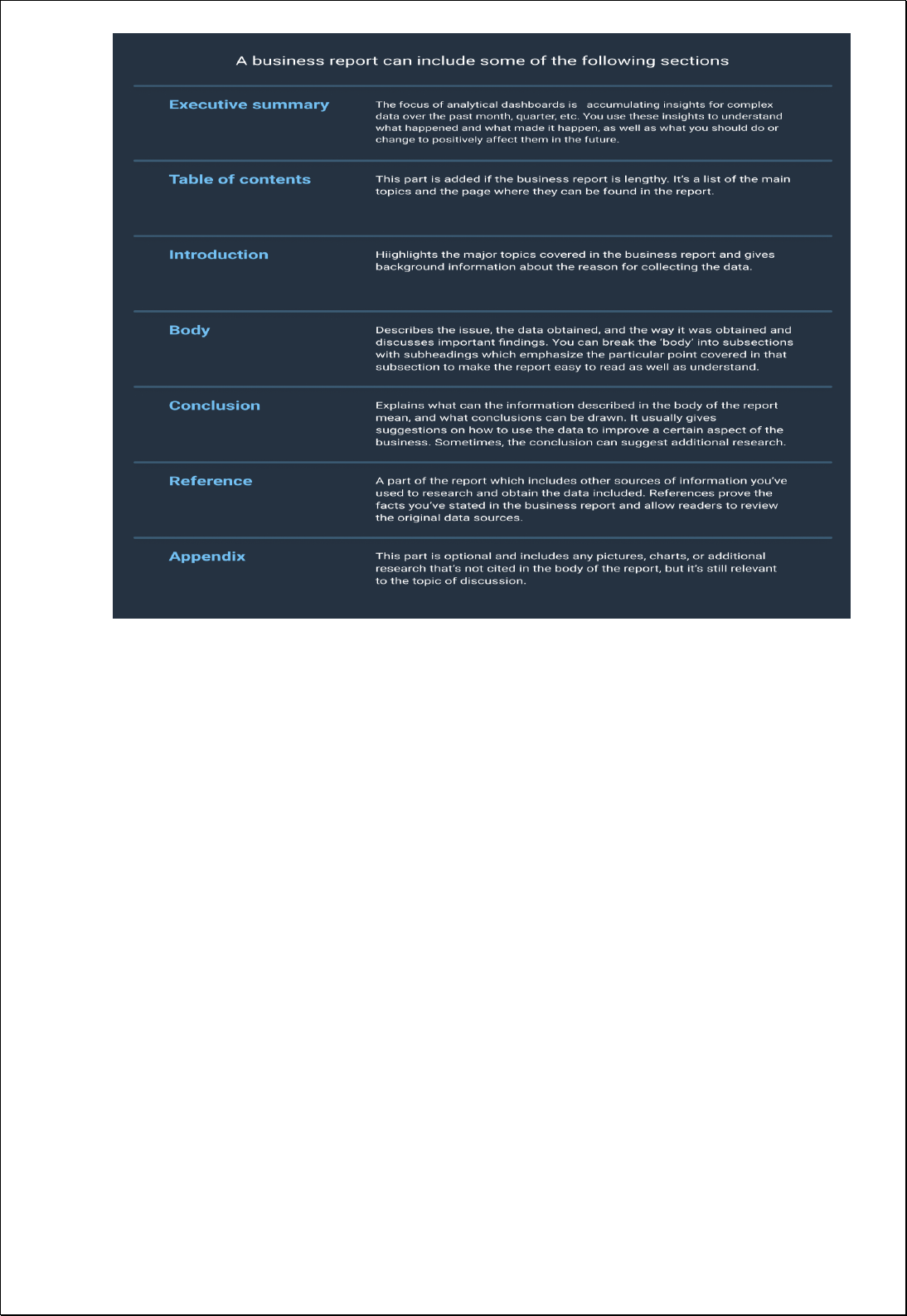
A business report can include some of the following sections:
Types of Business Reports
There are many different types of business reports, depending on the business’ needs and situation. Here
are some of the most common:
1. Informational Reports
You ask for this report when you want objective information on something. It presents non-biased facts
without explaining the reasons and the possible outcomes of a situation. It is the ideal business report for
learning things such as the number of employees, the role each of them plays in the company, or the
departments the employees work in.
2. Analytical Report
This type of business report is usually required when a company is trying to make an important decision.
An analytical report analyses the company’s situation, presenting relevant information, explanations,
and conclusions. It helps the company to make good decisions going forward.
3. Research Report
This is the most comprehensive type of business reports required when a company considers trying
something new, such as going into a new geographical area or offering a new product. A team of
specialists or researchers are given a topic and asked to find all the relevant statistics and details
obtained from an informational report, followed by a detailed analysis of the data found in the analytical
report. The conclusion of the research report will be based on the available data obtained from the
analytical and informational reports.
4. Explanatory Report
This report is required when you want to explain a topic or situation so that everyone can understand it.
For example, you can write it to explain the research you’ve conducted. Along with the table showing
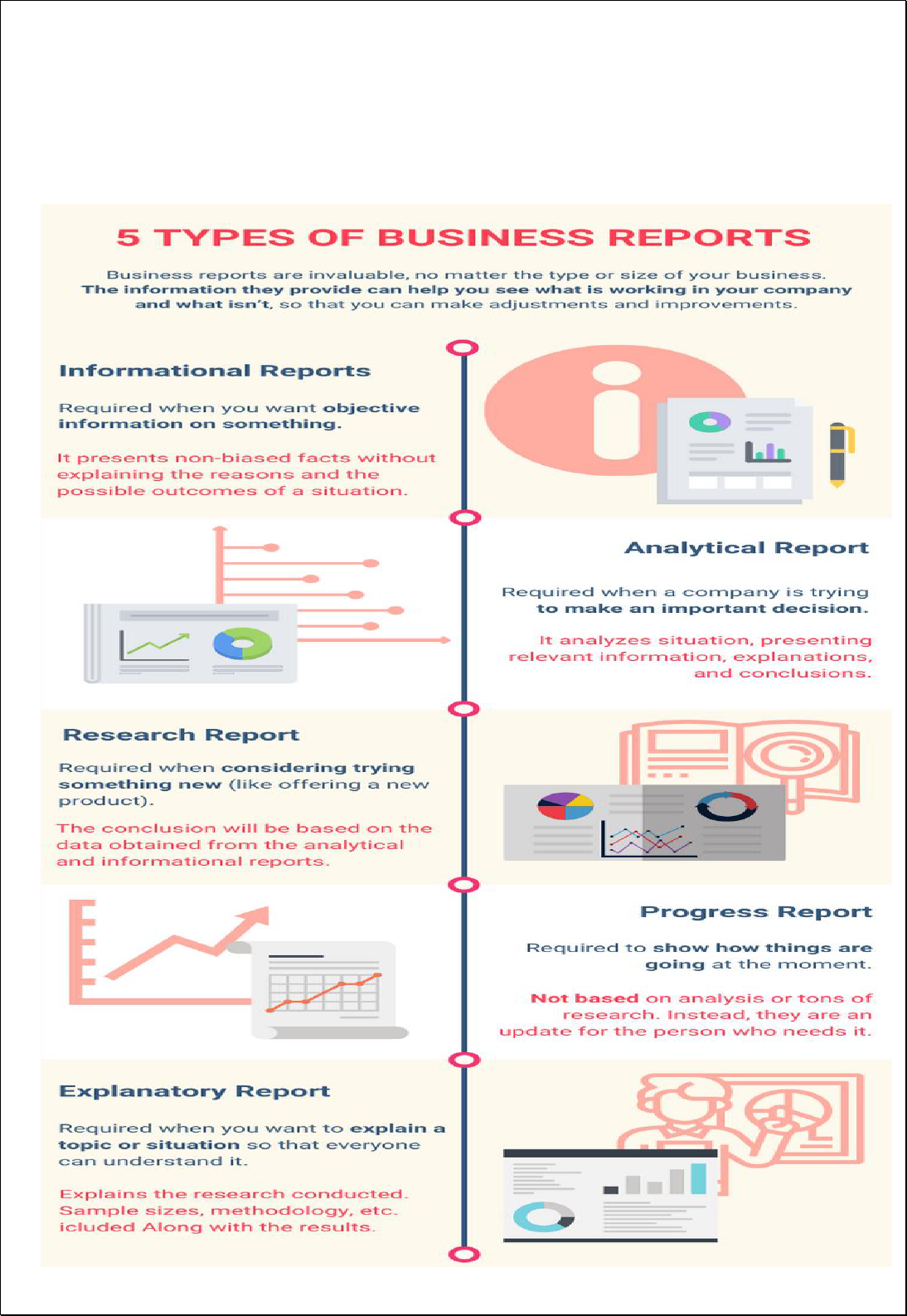
the results, you should include the reason for the research, sample sizes, methodology, etc. After
explaining the results, you should briefly summarize the findings.
5. Progress Report
You want this report to show how things are going at the moment. A progress report isn’t based on
analysis or tons of research. Instead, they are an update for the person who needs it. One example of this
could be a weekly report disclosing the progress made throughout the week and what tasks you're
looking to work on in the upcoming week.

Purpose of Reports
The report plays an important role in decision-making in an organization. And such importance of report
can be understood through the following discussions:
1. Decision-Making Tool
Today’s complex business organizations require thousands of information. Reports provide the required
information a large number of important decisions in business or any other area are taken on the basis of
the information presented in the reports. This is one of the great importance of the report.
2. Investigation
Whenever there is any problem, a committee or commission or study group investigates the problem to
find out the reason behind the problem and present the findings with or without the recommendation in
the form of a report. It is another importance of the report.
3. Evaluation
Large scale organizations are engaged in multidimensional activities. It is not possible for a single top
executive to keep a personal watch on what others are doing. So, the executive depends on reports to
evaluate the performance of various departments or units.
4. Quick Location
There is no denying the fact that business executives need information for quick decision-making. As
top executives are found to be busy for various purposes), they need vital sources of information. Such
sources can be business reports.
5. Development of skill
Report writing skill develops the power of designing, organization coordination, judgment, and
communication.
6. Neutral presentation of facts
Facts are required to be presented in a neutral way; such presentation is ensured through a report as it
investigates, explains, and evaluates any facts independently.
7. Professional Advancement
The report also plays a major role in professional achievement. For promotion to the rank-and-file
position, satisfactory job performance is enough to help a person. But for promotion to a high-level
position, intellectual ability is highly required. Such ability can be expressed through the report
submitted to a higher authority.
8. Proper Control
Whether activities are happening according to plan or not is expressed through a report. So, controlling
activities are implemented based on the information of a report.
9. A managerial Tool
Various reports make activities easy for managers. For planning, organizing, coordinating, motivating,
and controlling, the manager needs help from a report which acts as a source of information.
10. Encountering Advance and Complex Situation
In a large business organization, there is always some sort of labour problems that may bring complex
situations. To tackle that situation, managers take the help of a report.
The discussions mentioned above justify the importance of reports in our daily life.
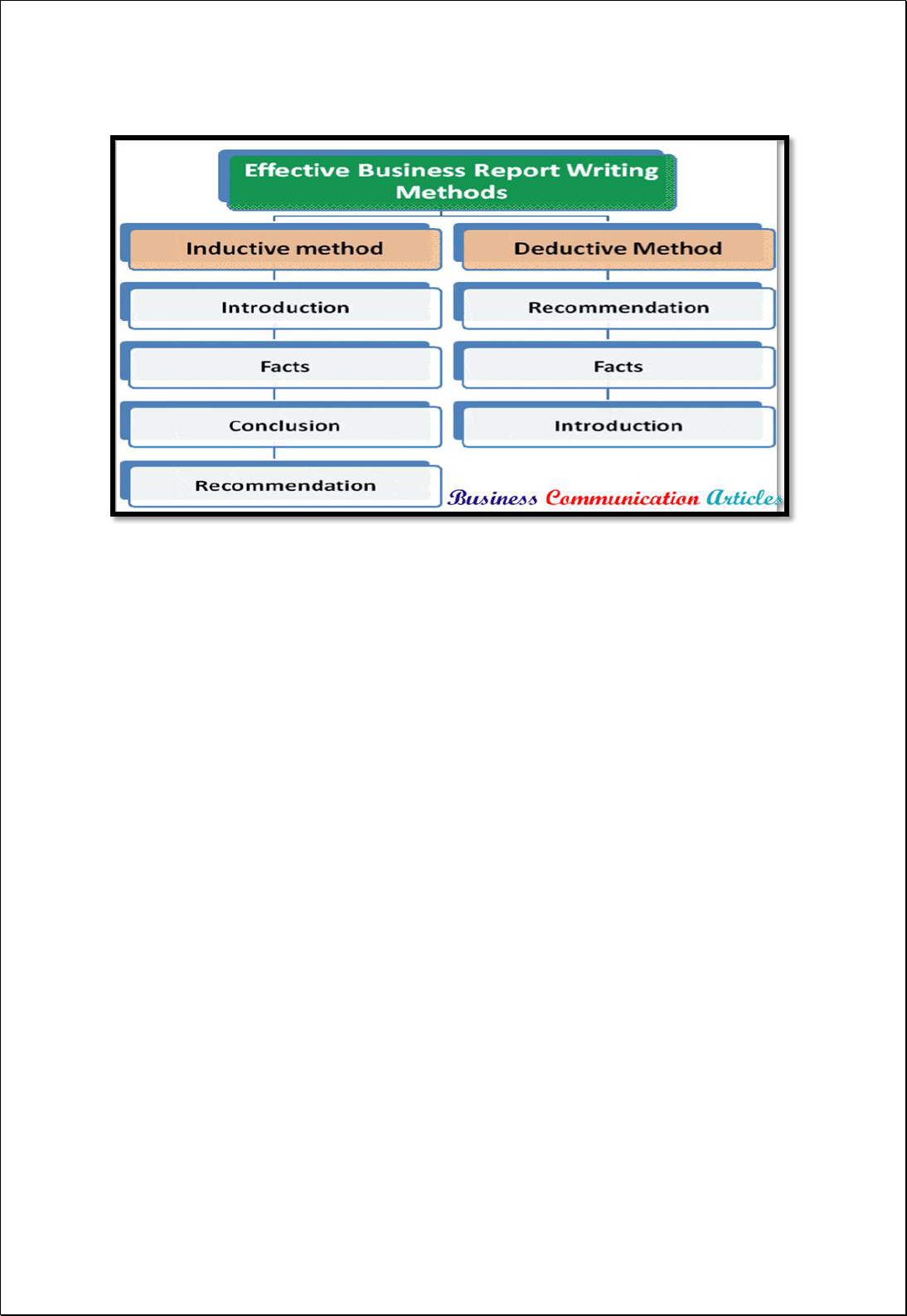
Report writing methods
There are two (2) methods that are widely used in the modern world to draft report, which are
1. Inductive method
2. Deductive Method
1. Inductive method
Here we determine first the subject matter and then we try to find out the cause of the subject matter.
We follow the following sequence in the inductive method:
Introduction
Facts
Conclusion
Recommendation
E.g. an action taken against a subordinate in an organization can be drafted as a report by following the
inductive method, such as:
Introduction: Various incidents during the past two months cause investigation of the work record of
Mr. Micle Clark, sales executive, sales department
Facts: The investigation of his work provides the following points:
1. He has been late to his work seven times
2. He has been absent without notice to authority three times
3. He has made sales to unauthorized dealers.
Conclusion: Due to his negligence and unauthorized activities, our performance is subject to the bad
will. Immediate steps should be taken for recovery.
Recommendation: Based on the conclusion, it is recommended that Mr. Micle Clark should be fired.
2. Deductive Method
Here we first determine the cause and then we present the subject matter. We follow the following
sequence in the deductive method:
Recommendation
Conclusion
Introduction
E.g. an action taken against a subordinate in an organization can be drafted as a report by following the
deductive method, such as:
Recommendation: Mr. Micle Clark, Sales executive, sales department should be fired. Conclusion
negligence and unauthorized activities have caused us a bad will and therefore immediate steps are
required for recovery.
Facts: The Conclusion reached is based on the following points

1. He has been late to work seven times
2. He has been absent without notice to authority their times
3. He has made sales to unauthorized dealers
Introduction: Various incidents during the last two months made us investigate the work record of
Mr. Micle Clark, sales executive, sales division.
Which report writing methods are better and why?
If the report is short or small or daily report then it is easy to follow the deductive method
Moreover when more emphasis is given on the recommendation of a report rather than facts or
information in such a case deductive method is suitable.
On the other hand, when a long report is prepared then it is better to follow the inductive
method because in such a report more emphasis is given on. The facts or information and its
analysis and explanation.
In general, a deductive method is more scientific and it is more reader-oriented. Busy
executives can easily understand the recommendation and the summary of the report prepared
according to the deductive method. Such executives can save them valuable time also.
Which method is better, it depends on nature or circumstances? The method which is
acceptable in one situation may become unacceptable in another situation. So best method is
dependent on circumstances.
Business Proposals:
Business Proposal is a document, which is written for a specific reason either to get a job or a
project. Usually, it is sent to the company or the client for giving a brief introduction about the
services and the professional features of the seller.
It has been said that the Business Proposal can help grow a rich relationship between the two
companies and strengthen their mutual cooperation. The most common reason for writing a
business proposal is to obtain any project or offer the services for required work in order to
benefit both companies i-e the sender company and the company to whom the proposal is being
sent.
In simple words, a business proposal is a document or written offer from the side of the seller
to the buyer for getting a project to be put into action in the future time.
Types of Business Proposals
There are three different types of Business Proposals that are:
1. Formally Solicited
2. Informally Solicited
3. Unsolicited
1. Formally Solicited Business Proposals:
In most of the organizations, formally solicited proposal is written in the response of given requirements
by the buyer. In order to meet the needs of the proposal, it is categorized under the following categories.
RFP (Request for Proposal)
RFP’s contain brief information related to the offer of the customer to make sure the seller completely
fits the needs and demands. Sometimes, it also contains routes to prepare a to the point proposal along
with evaluation criteria. Mostly, RFP’s are issued by the customers when available products or services
do not meet with the requirements.
RFQ (Request for Quotation)
The RFQ is issued by the customer when there is a need for a larger quantity of goods. In such cases,
prices are not the only thing to consider, but other services also matter, such as the availability of
commodities, time of delivery and quality of services. An effective proposal might lead the seller to
obtain a big project.

IFB (Invitation for Bid)
Whenever any customer wants to get the needed services such as construction, then IFBs are issued.
The primary goal to issue an IFB is only to check the prices. While on the other hand, the quality of the
services also has much importance, but prices have more impact than quality.
RFI (Request for Information)
RFI (Request for Information) issued to get the information about the available products, services and
retailers. Its main purpose is to view “marketing intelligence” and is lead to the final settlement of the
business deal. So many sellers take it very seriously and fill the information according to the
requirement carefully. Surely, it is one step to final RFPs, RFQs and IFBs.
2. Informally Solicited Business Proposals:
These types of business proposals are an output of oral conversation between the retailer and the
customer. It is also known as the Sole-Source Proposal because it does not possess any requirements to
meet, just a little meeting and capture the deal. Normally, these proposals are written in roundabout 25
pages, and in some time may go down to 5 pages or even less.
3. Unsolicited Business Proposals:
The Unsolicited types of Business Proposals are like a marketing brochure that contains necessary
information about the needs of the seller. In this type of proposal, there is no direct connection between
the sellers and the customers. It is also termed as “leave-behind” or “give-away” in the last moments of
any meeting. The main reason for issuing an Unsolicited Business Proposal is to increase the chances of
sales.
Purpose of Business Proposals
Business Proposal by nature creates a great impact on the image of the seller because it
represents the actual condition of the seller for a specific job.
It is an assurance to the buyer that the seller will try hard to achieve the main goal of the project
and get it done by the deadline.
At some point, it is considered to be a key step in joint sell where the buyer considers
extraordinary results against the price, so acceptance of the proposal is really a gigantic
achievement.
There are many organizations in the world, which are well familiar with the art of proposal
writing and have advanced skills to prepare a proposal in a short period.
The proposal contains necessary information about the seller for accomplishing the mentioned
task.
It is in favor of the seller that the seller meets the requirements of the buyer entirely and can do
the job within a specified span.
The buyer likes to get a proposal prior to making a deal in order to check the abilities of the
seller whether they satisfy the needs or not.
Both parties get exactly what they want when a proposal achieves success by making the agreed
sale.
INTERNAL COMMUNICATION
Internal communication is the transmission of information within an organization. Internal
communication is a lifeline of a business. It occurs between an employer and an employee.
It is communication among employees. Internal communication is the sharing of the information,
knowledge, ideas, and beliefs between the members of the company.
Internal communication can be formal or informal. It depends upon the persons to which we are
communicating.
We use informal or not so formal language with our colleagues.
The language used while communicating the head of the company is formal.

Effective Internal Communication
Effective internal communication must have the following.
The open and clear reason for communication.
Understanding the need of the audience.
Consistent and regular communication.
Clear, jargon-free, to the point, and brief language.
Two-way communication.
Good use of vocabulary.
Importance of Internal Communication
One can easily find the importance of internal communication. some of them are
It increases productivity.
Effective and responsive customer service.
Easy attainment of goals.
Reduce day-to-day conflict between team members.
Enable fast response.
Enable fast decision making.
Helps in motivating the employees.
Common Internal Communication
Group meetings.
Company blogs.
Employee training within an organization.
Personal meetings.
Telephonic conversation between employees.
Inquiry of employee.
E-mails within an organization.
Staff communication.
Company newsletter
Format and Principles of writing Memos:
A memo is actually short for Memorandum. It is one of the most used means of official communication in
the business world. Its main purpose is to serve as a reminder or to give some instructions. Again, these
like circulars are a means of mass communication, i.e., to communicate with a large number of people
within the organization.
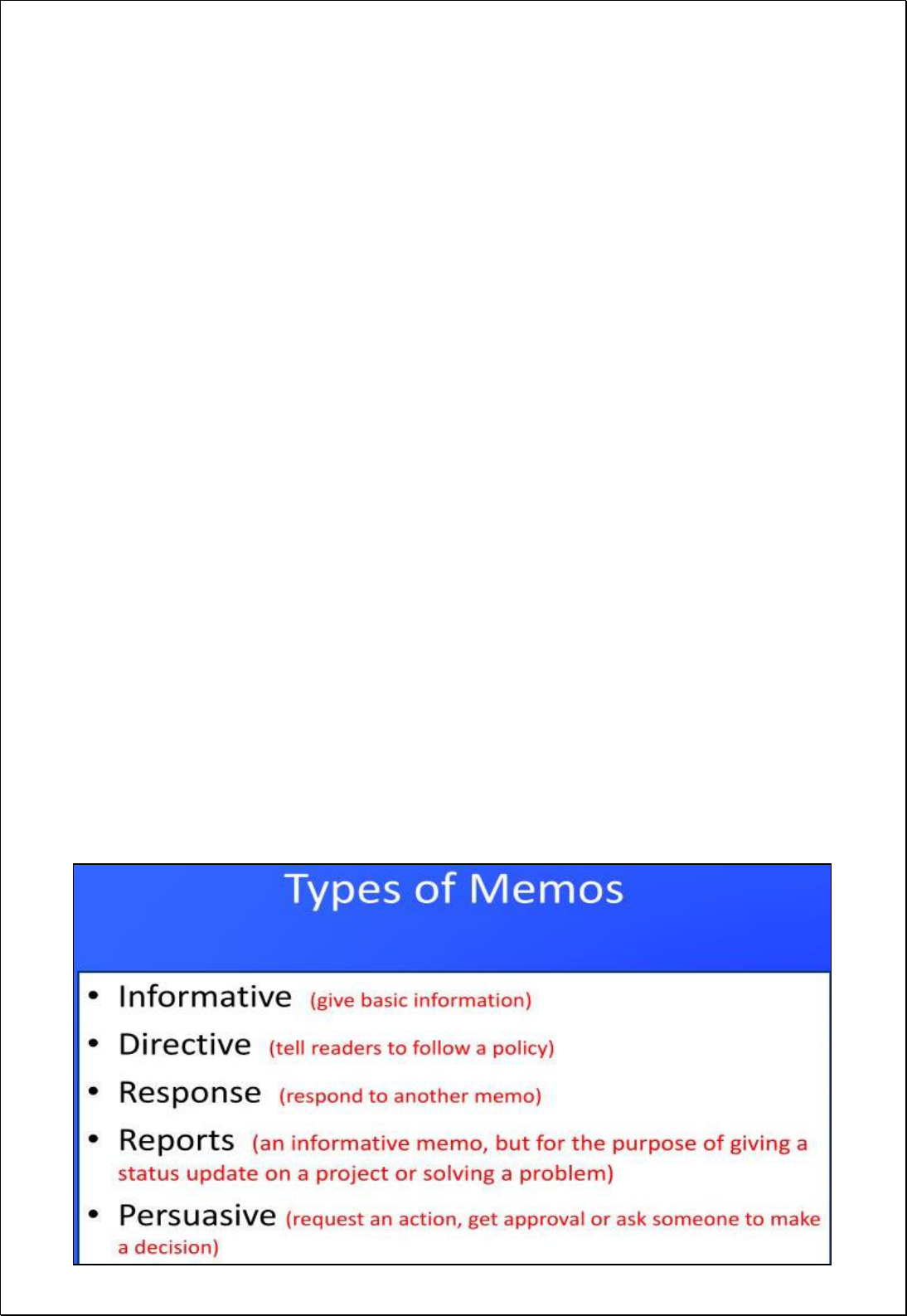
Usually, we write a memo is for one of the following five reasons
i. as a reminder
ii. highlight an event or circumstance
iii. to recount an event
iv. keep an official record of anything
v. to pass information or instructions
Memos have been a popular way for commuting for over a century now. This is because they have many
advantages as seen below:
They are a very cost -effective way of mass communication. And their transmission is also
very cheap.
Another advantage is its simplicity. They are very simple to write and understand.
Memos tend to be brief and to the point. They also reach a lot of people. So, they are very
time-saving as well.
They also serve as evidence in case of a dispute
The Format of a Memo:
Let us see the steps of writing a memo.
Heading: After the name and address of the company (which is on the letterhead) we type the word
“Memo’ or ‘Memorandum’ at the top of the page in the centre.
Recipient: Address the recipients in the correct format, Example -‘To: All Employees of the Sale
Division’
Writer: Write the name of the person writing the memo, Example – ‘From: Mr. ABC, Head of
Sales’
Additional Recipients: These are the people who will receive a courtesy copy of the memo. We
don’t address the memos to them, but we keep them in the loop.
Date: The date of writing the memos is an important detail that one must include.
Subject Line: This will give the reader a brief idea about the information in the memos. The line
must be brief, precise and to the point. Example – Subject: Meeting of all employees of the Sale
Division.
The body of a memo: This is where all the information is contained. A formal salutation is not
required in a memo. Just relay the necessary information with clarity and precision. The body must
not be too long. The ending must restate the issue and end on a positive note.
Proofread: Finally, proofread the memo before sending it.
Types of Memo’s:
There are four types of memos you might have to write, each with its own organizational format:
information, problem-solving, persuasion, and internal memo proposal.

1. Informative Memo:
Used to deliver or request information or assistance
First paragraph provides main idea
Second paragraph expands on the details
Third paragraph outlines the action required
2. Directive memo:
States a set of instructions or directions for the reader to follow.
Directive memos are also used when a change in policy or something of the like happens in the
workplace.
A directive memo would be sent over an email with similar information for the reason that the
information might be time sensitive so the viewer would need to see it immediately to follow the
actions and directives within.
3. Response memo:
It provides information to their audience.
The format is divided into sections because it contains more information than other memos.
The sections are purpose statement, summary, discussion, and action. One way to identify a
response memo is that instead of having a "Subject:" line you have a "RE:" line, just like when
you directly reply to an email.
Since a response memo is a direct follow-up method of communication to a question, it is
necessary for the memo to begin by stating the original question or paraphrasing the initial
problem, and continuing by answering it immediately.
4. Report/ Problem-solving Memo:
Suggests a specific action to improve a situation
First paragraph states the problem
Second paragraph analyses the problem
Third paragraph makes a recommendation
When making a recommendation, include not only the positive details but also the drawbacks
and diffuse them yourself.
5. Persuasive Memo:
In a persuasive memo you must constantly keep your reader's feelings in mind. Consider how
the person will react to what you are saying. What would convince him or her most readily?
How much should you rely on logic, and how much should you appeal to emotion?
Step1. Open with a statement that focuses the reader's attention on the issue.
Step 2. State what you want to persuade the reader to do or not do.
Step 3.Explain why the reader should cooperate. Calling attention to personal benefits will
help.
Step 4. Close with a call to action. Add any additional information the reader may need.
General Warning:
Employee warning notices are used to address and confirm an employee's performance or
inappropriate conduct at work. A company usually issues an employee warning form after a
meeting with him/her to discuss the issue. This gives the employee an opportunity to correct
their behavior moving forward.
It's important to be upfront and clear about your company's employment policies. You should
ensure that all employees are aware of these policies and have access to your employee
handbook.

Remember, you should also establish clear rules for your managers to ensure that all employees
are treated equally. To comply with federal laws, all managers must act consistently when
carrying out disciplinary actions to avoid being accused of unfair treatment down the line.
When should you write up an employee a Warning?
Absenteeism.
Tardiness.
Consistent Sub-Standard Work.
Inappropriate Behavior toward Customers or Clients.
Illegal Behavior.
Insubordination.
Company Policy Violation.
How do you write a warning letter to an employee?
1. Identify the problem.
2. Meet with the employee and clarify the issue.
3. Create your warning letter and include all the performance issues you've considered.
4. Give the employee the warning notice and make sure you receive a signature to confirm
receipt.
Caution:
To caution someone is to tell someone to be careful. If you know someone who is going to do
something that could be dangerous, you would caution him or her away from doing that thing.
When someone is about to make a life-altering mistake, giving him advice about how to avoid
making that mistake is cautioning him about it.
It is possible to caution someone who is in grave danger, and it is also possible to caution
someone who is about to make smaller mistakes.
To caution someone about something is to show care for the wellbeing of that person, no matter
the situation.
To take caution is to make sure to avoid danger. Therefore, to caution someone else is to help
him or her avoid danger.

UNIT-III
Public Speaking- Meaning
Public speaking(sometimes termed as oratory or oration) is the process or act of performing a
presentation (a speech) focused around an individual directly speaking to a live audience in a
structured, deliberate manner in order to inform, influence, or entertain them. Public speaking is
commonly understood as the formal, face-to-face talking of a single person to a group of listeners.
Public speaking is the process of speaking to a group of people in a structured deliberate manner
intended to inform, influence or entertain the listeners.
Basic Principles of Public Speaking
In order to make a successful presentation, a speaker should practice certain principles of good
delivery.
1. Look natural
If the presenter is stiff or artificial, he/she will look uncomfortable and awkward. The audience may
see this as a lack of confidence, which might affect their perceptions of credibility. The good speaker
strives for a natural, easy going style of presentation.
2. Maintain eye contact
Make and maintain eye contact with the audience members often. This demonstrates confidence in the
information being communicated to them, and engages them in discussion. Nervous eye-shifting and
avoidance of eye contact will display anxiety that the audience will notice.
3. Practice
While we are humans and no one is perfect, consistently practising presentations will continuously
improve public speaking skills. Speaking to a friend or a few colleagues is very different from
commanding an audience of one hundred or thousand people. The more we practice the better we will
become, and the more comfortable we will be with public speaking.
4. Do not read from notes
Reading from notes for any extended length of time takes the interest of audiences away, although it is
acceptable to glance at notes infrequently.
5. Speak with conviction
The material we present orally should have the same ingredients as that which are required for a
written research paper i.e. logical progression from introduction to body to conclusion.
6. Pause
Allow yourself and your audience a little time to reflect and think. Don’t race through your
presentation and leave your audience, as well as yourself, feeling out of breath.
7. Audio-visual aids
There are many kinds of props which you may use for a successful presentation. This can be a good
substitute for an introductory statement. This can also generate a more interesting approach to the
audience. When using audio-visual aids to enhance your presentation, be sure all necessary equipment
is set up and in good working order prior to the presentation.
8. Speak, Listen, respond, Adjust and Adapt
Speak to your audience, listen and respond to their reactions, adjust and adapt. Always be prepared for
unexpected. If you are short of time, know what can be safely left out. If you have extra time, know
what could be effectively added.
9. Leave them with anticipation
When it comes to public speaking, less is more. Make your presentation a bit shorter than expected.
Never allow your delivery to be so long that your audience wonders when it will be over.

10. Inspire change
Focus on the benefit you want to provide your listeners or the change you want to encourage them to
make. Think about the following:
What is the purpose for your presentation?
What are you helping or motivating your audience to do?
What are you teaching them?
What goals are you helping them to achieve?
What message do you want them to walk away from your presentation with?
The Importance of Public Speaking
There are many reasons why the public speaking is very important:
By learning how to effectively speak to the public, we can increase our self-confidence. As public
speaking is among the most common fears in the modern world, by mastering this complex skill,
we would feel confident while meeting complex future challenges.
Learning public speaking is an enormous way for students to do better in the college and provide
them better opportunities to get admissions in the top schools.
Public speaking often helps you to feel more comfortable with the other people, like strangers.
When you become capable of addressing and instructing the whole room of strangers, it will be
very easy to shake hands, smile, and meet strangers in more special and less ominous
circumstances.
Public speaking can help you fine-tune your daily verbal or non-verbal communication abilities. It
is particularly true for the people that spend a huge amount of time working through the written
words.
The skills that you'll develop by learning public speaking will boost your value and performance
in nearly all the fields – office, home, or life.
Use of public speaking efficiently will allow you to make difference in the business, society and
maybe even in your life.
Types of Public Speaking
Every day people around the world stand before some type of audiences to speak. Although the
public speeches have different types, they may usually become grouped into three types based on
the intended objectives: Informative Speaking, Persuasive Speaking, and Entertaining Speaking.
1. Informative Speaking: Among the most familiar public speaking types is informative speaking. The
main objective of the informative speaking is to distribute one’s knowledge of any subject with the
audience. The reasons for informative speaking vary extensively. For instance, you could be invited
to train a co-workers’ group on how to employ the latest computer software or report to the
managers’ group about how your newest project is going on.
Informative speaking is incorporated in many different occupations. The teachers speak to the
parents and their students also. Physicians usually give lectures regarding their expertise to the
patients, medical students, and other physicians. Fire-fighters provide demonstrations regarding
how to efficiently control fire in your house. Informative speaking is a general part of many jobs
and everyday activities. Therefore, speaking efficiently has become a vital and necessary expertise
in today’s life.
2. Persuasive Speaking: Another common reason for speaking to the audience is to convince others.
In everyday lives, we are generally called to motivate, convince, or encourage others to transform
their beliefs, taking action, or reconsidering the decision. Supporting music education for your
school, convincing the clients to buy products of your company, or inspiring students to go to
college, all these involve controlling other people using public speaking.
For people like elected officials, persuasive speaking is an important part of getting and continuing
success. People make their careers through speaking to the other people that pay to hear them. If
you can develop the skills of persuading effectively, it will prove to be professionally and
personally rewarding.

3. Entertaining Speaking: Entertaining speaking engages display of speaking to the occasions
including introductions of wedding toasts, giving and acknowledging awards, motivational speeches
and after-dinner speeches. There are experts, from comedians to religious leaders that make living
only from giving entertaining speeches. Anybody who has observed award shows on the television,
indicates that speaking for the entertainment is the task, which needs practice and preparation to be
efficient.
Advantages of Public Speaking
Influence the World: The finest ways of changing our society is the use of communication power.
The common citizens of any republic nation across the world are influencing this world by using
their power of speech. If you want to see examples of that, just type “citizens speak out” in any
search engine. You’ll get many examples of how commonly the citizens, use the power of speech
to make the actual changes in this world.
Develop Leadership Skills: Have you thought of climbing the business ladder and finally getting
yourself in the management or any leadership positions? If yes, the skills of public speaking are
extremely important to you. Efficient public speaking skills is a requirement for all the leaders. In
case you wish people to pursue, you need to communicate clearly and effectively what the
followers need to do. Among the most vital skills for the leaders for development is their skills of
public speaking and that is the reason why executives pay millions of dollars each year to attend
workshops on public speaking.
Become a Thinking Leader: Even though we don’t have any leadership position; efficient public
speaking can help us become a “thinking leader.” When your prospects, customers, and colleagues
rate you like a very smart person, you have become a thinking leader. For achieving the status of a
thinking leader, the individuals have to talk about their ideas with others in both public speaking
and writing.
POWER POINT PRESENTATION
Introduction
Well-developed presentation skills enable you to communicate clearly, precisely and effectively in
a variety of modes or registers and settings. It should be pointed out that they are rated as one of
the most important soft skills. The ability of communicating with the audience and giving
presentations should be seen as a mandatory prerequisite for both the effective learning process
and the successful working life.
Thus, it is imperative to gradually increase and enhance your presentation skills through a
continuous training that will help you to become more competent, confident and competitive.
Objectives
To develop your skills to communicate clearly, effectively and confidently with a range of
audiences in a range of different contexts.
To improve your research and design skills, and strengthen your delivery techniques.
To enhance your use of different support electronic and other visual tools.
To reinforce your performance skills (verbal and non-verbal).
To increase your confidence level in interacting with audience and control your nervousness.
To promote critical and reflective thinking by dealing with feedback on your presentation skills.
Types of Presentations
There are two basic types of presentations
1. Informative Presentations
The purpose of informative presentations is to promote understanding of an idea or to convey
information. They are often used to provide people with information about a concept or idea that is
new. A presentation on "Endangered Species in the South American Rain Forest" is an example of
an informative presentation.
2. Persuasive Presentations
The second type of presentation is a persuasive presentation. The goal of a persuasive presentation is
to influence a change in the belief, attitude, or behavior of another person when that person has some
degree of free choice. Expanding upon the example provided above, a persuasive presentation would

not only inform the audience members about the South American rain forest and its endangered
species, but would also try to get them to take specific and appropriate actions to save these species.
Both types of presentations can be used to start a discussion by providing information on a
given topic followed by time for questions, answers, and discussion.
Steps in Preparing a Presentation
Planning your presentation
Preparing a presentation can be an overwhelming experience if you allow it to be one. The
strategies and steps below are provided to help you break down what you might view as a large
job into smaller, more manageable tasks.
Step 1: Analyze your audience
The first step in preparing a presentation is to learn more about the audience to whom you'll be
speaking. It's a good idea to obtain some information on the backgrounds, values, and interests
of your audience so that you understand what the audience members might expect from your
presentation.
Step 2: Select a topic
Next, if possible select a topic that is of interest to the audience and to you. It will be much
easier to deliver a presentation that the audience finds relevant, and more enjoyable to research
a topic that is of interest to you.
Step 3: Define the objective of the presentation
Once you have selected a topic, write the objective of the presentation in a single concise
statement. The objective needs to specify exactly what you want your audience to learn from
your presentation. Base the objective and the level of the content on the amount of time you
have for the presentation and the background knowledge of the audience. Use this statement to
help keep you focused as you research and develop the presentation.
Preparing the content of your presentation
Step 4: Prepare the body of the presentation
After defining the objective of your presentation, determine how much information you can
present in the amount of time allowed. Also, use your knowledge about the audience to prepare
a presentation with the right level of detail. You don't want to plan a presentation that is too
basic or too advanced.
The body of the presentation is where you present your ideas. To present your ideas
convincingly, you will need to illustrate and support them. Strategies to help you do this
include the following:
Present data and facts
Read quotes from experts
Relate personal experiences
Provide vivid descriptions
And remember, as you plan the body of your presentation it's important to provide variety.
Listeners may quickly become bored by lots of facts or they may tire of hearing story after
story.
Step 5: Prepare the introduction and conclusion
Once you've prepared the body of the presentation, decide how you will begin and end the talk.
Make sure the introduction captures the attention of your audience and the conclusion
summarizes and reiterates your important points. In other words, "Tell them what you're going
to tell them. Tell them. Then, tell them what you told them."
During the opening of your presentation, it's important to attract the audience's attention and
build their interest. If you don't, listeners will turn their attention elsewhere and you'll have a
difficult time getting it back. Strategies that you can use include the following:
Make the introduction relevant to the listeners' goals, values, and needs
Ask questions to stimulate thinking
Share a personal experience
Begin with a joke or humorous story
Project a cartoon or colourful visual
Make a stimulating or inspirational statement
Give a unique demonstration

During the opening you want to clearly present your topic and the purpose of your presentation.
Clearly articulating the topic and purpose will help the listeners focus on and easily follow your
main ideas.
During the conclusion of your presentation, reinforce the main ideas you communicated.
Remember that listeners won't remember your entire presentation, only the main ideas. By
reinforcing and reviewing the main ideas, you help the audience remember them.
Practicing and Delivering
Step 6: Practice delivering the presentation
Most people spend hours preparing a presentation but very little time practicing it. When you
practice your presentation, you can reduce the number of times you utter words and phrases
like, "um,""well," and "you know." These habits can easily diminish a speaker's credibility.
You can also fine-tune your content to be sure you make your most important points in the time
allotted.
In addition to planning the content of your presentation, you need to give advanced thought to
how you want to deliver it. Do you want to commit your presentation to memory, use cards to
guide you, or read from a script? Or, you might want to use a combination of methods. To help
you decide, read.
Advantages and disadvantages of the four delivery methods described below:
Speaking from Memory
A distinct advantage of speaking from memory is your ability to speak to the audience without
relying on notes or a script. This allows you the flexibility to move away from the podium and
to maintain eye contact with the audience. However, speaking from memory has disadvantages,
too. Presentations from memory often sound rehearsed and the possibility exists that you’ll
forget an important point, present information that’s inaccurate, or completely loses your train
of thought. If you decide to deliver your presentation from memory, have notes handy to jog
your memory just in case!
Speaking from Notes
Many people like to speak from notes. Typically these notes are either on cards or paper in
outline form and contain key ideas and information. If you are using an electronic presentation
tool, you may be able to include your notes in the presentation itself. The benefit of delivering
a presentation from notes is that you sound natural rather than rehearsed and you can still
maintain relatively good eye contact with the audience. The down side is that you might not
express your key ideas and thoughts as well as you may have liked had you planned your exact
words in advance.
Speaking from Text
Speaking from text involves writing your speech out, word for word, then basically reading
from the text. As with speaking from memory, an advantage of this method is that you plan, in
advance, exactly what you're going to say and how you're going to say it. A disadvantage is
that you might appear to the audience to be stiff or rehearsed. You will need to make frequent
eye contact and speak with expression to maintain the audience's interest.
Using a combination of methods
You may find the best method to be a combination of all three. For instance, experts suggest
you memorize the first and last ten minutes of your talk so that you can speak flawlessly and
without notes. Notes may be suitable for segments of your presentation that you know very
well, for example, relating a personal story. Finally, speaking from a text might be appropriate
when you have quotes or other important points that you want to make sure you communicate
accurately and completely. You can make a smooth segue to written text by saying something
like: "I want to read this quote to you verbatim, to ensure that I don't distort the original intent."
Step-7: Being a credible speaker
Have you heard someone speak whom you thought lacked credibility? Did you dismiss what he
or she had to say because you thought it was probably not true? That's what typically happens
when a speaker lacks credibility. While it's always important to be thought of as believable, it's
especially important when you speak to a group of people, and vital if you plan to deliver a
persuasive presentation. Without credibility, members of the audience may dismiss what you

have to say as either unimportant or untrue. The guidelines that follow are provided to help you
learn how to become a more believable speaker.
Be accurate and exact with quotes, names, dates, and facts
If you want people to believe you, you have to earn their trust. That means getting the facts
straight. Research the information you're going to present to make sure it's accurate and make
sure you report it correctly. Practice pronouncing names correctly, and state dates, facts, and
quotes accurately. Copy information that you think you might state incorrectly and read it from
your notes if necessary.
Provide support for your ideas
It's not enough just to make a statement, you need to back it up by providing factual
information, quoting an expert, or speaking from experience. The point is, it's not enough to
state your ideas, you need to be able to explain why you have those ideas.
Dress in a professional manner
If you want to be taken seriously, then dress accordingly. Being the worst dressed person in the
room just won't do. You don't need to have the most expensive clothes or the most current
wardrobe, but do look well groomed. Like it or not, research has determined that people are
influenced by the appearance of the speaker.
Use visual aids that look professional
Visual aids can enhance your presentation if they are well designed and look professional. Be
certain to use the visual aids when you practice your presentation.
Know your material
Knowing the material will help you speak more quickly and fluidly. Research has shown that a
speaker's credibility is enhanced by speaking more quickly and without hesitation (uh, well,
you know) or qualifiers (sort of, kind of, I guess). People who speak faster are perceived to be
more intelligent, more confident, and more effective than people who speak slower. Knowing
your material will also help you reduce hesitations and qualifiers that might diminish
credibility.
Use language that's appropriate for the audience
Don't try to impress them by using words they don't understand. If your subject is new to
audience members, be certain to explain jargon they might not comprehend. Also, be certain to
use your best grammar. Slang can be appropriate for the right audience, but the use of incorrect
grammar may be taken as a lack of knowledge on your part.
Step-8: Using humour effectively and controlling your nervousness
Using humour effectively
Integrating humour into your oral presentation helps enhance and maintain the audience's attention and
interest. Here are some pointers for effectively incorporating humor into your presentation.
Beginning a presentation with a joke or humorous story is a great way to break the ice. It can help
audience members relax, which will help you relax, too.
Using humor and stories in the body of the presentation is a great way to emphasize key points,
and recapture the attention of the audience.
Use topic-related cartoons, drawings, or illustrations that can be projected for all to see.
Use humor that maintains your personal dignity as well as the dignity of audience members. Never
use humor that would embarrass an audience member or damage his or her self-esteem.
Try out your stories or jokes on a couple friends and/or acquaintances to make sure they are
humorous. Practice telling the stories or jokes before the presentation to improve your delivery.
Use humor that's acceptable to the group and not offensive. Avoid references to ethnicity, religion,
politics, and gender.
Most humor is very culturally specific and in some cases regionally specific. Make sure you know
who your audience is and what they find humorous before using any jokes.

Controlling your nervousness
Most people are a little nervous when they speak in public. In fact, a little nervous energy can enhance
a performance or presentation. It is important to control this nervous energy, however, so that it
remains a positive motivating force rather than a debilitating one.
If you are well prepared you will be less nervous. Practice your oral presentation in advance and
keep rehearsing it until you're satisfied. Then, when the time comes to deliver the presentation,
you'll be confident in your ability to do well.
Prior to the presentation dedicate time to focus and clear your head of other thoughts. Run through
the presentation in your head one final time and remind yourself of how well prepared you are.
Greet the people with whom you'll be speaking. This helps you create a rapport with the audience
from the beginning and helps you recognize that the audience "isn't out to get you" — they want
you to deliver a good presentation.
Take deep breaths and consciously relax your body from head to toe to reduce some of the
physical symptoms of being nervous.
Make eye contact with members of the audience before you begin your presentation. If you've
already established a rapport with them by greeting them, this will re-establish in your mind that
the audience wants you to succeed.
Step-9: Delivering the presentation
How you say things may often appear to be more important than what you say. Have you listened to
charismatic speakers who gain and maintain the attention of the audience? Have you also encountered
speakers who quickly put an audience to sleep? Experienced presenters learn to communicate
effectively by using voice, gestures, and visual aids while trying to establishing a comfortable
environment for the audience.
Voice
Using your voice effectively can have a great impact on your delivery. The best speaking voice is
conversational, natural, and enthusiastic. Use the following guidelines to develop an effective speaking
voice:
Alter the pitch (high and low) of your voice to prevent yourself from sounding monotone. Don't
alter the pitch too much, however, because this may make you sound unnatural.
Speak loudly enough to be heard by everyone in the room, but vary the volume of your voice to
maintain interest and emphasize key points.
Stress certain words as another way to add emphasis. Typically when you stress a word, the pitch
and the volume increase.
Alter the rate at which you speak to maintain interest and add emphasis. Speak faster to show
excitement and/or build suspense. Speak slower to show the importance of an idea. Pause after
important ideas to allow the audience time to grasp them.
Gestures
Speakers often communicate with their audience either intentionally or unintentionally using
gestures and other physical behaviours. Use the guidelines below to help use gestures to your
benefit:
Maintain eye contact with members of the audience to keep their attention level high. Eye contact
signals that you care about the audience and you are attuned to their needs. Also use eye contact to
detect confusion or boredom so that you can then modify your approach.
Use positive facial expressions such as smiles, expressive eyes, and looks of empathy and
encouragement to communicate feelings and emotions.

Stand naturally with your feet spread slightly apart and arms relaxed at your sides.
Minimize gestures like pacing back and forth, rocking back and forth, playing with coins in your
pocket, wringing your hands, and other types of fidgeting. These gestures not only signal that you
are nervous, but they are distracting to the listener as well.
Use quick and energetic movements of your hands and arms to add expression to your talk.
Maintain the attention of the audience by making your movements unpredictable.
Visual-aids in presentation
Visual aids can help you emphasize main ideas, illustrate a concept, or stimulate the interest of
your listeners. Examples of visual aids include posters, overheads, flip charts, photographs,
computer-generated slides, and three-dimensional effects.
Use visual aids to emphasize important points and add interest to your presentation — don't put
every word of your entire presentation on them.
Select the appropriate visual aid for the environment. It may be possible to pass visuals around to
a small audience but in large groups you'll need to project them.
Give the visuals a consistent appearance including color and spacing. Start the text at the same
place on each visual.
Try to observe the seven by seven rule: on an overhead slide have no more than seven lines and
seven words per line. Similar rules would also pertain to flip charts, PowerPoint and other
computer generated slides, and posters.
Use a simple typeface or font. Don't use more than two different typefaces, if possible.
Make sure the text is large enough for people in the back of the room to read. Letters on a flipchart
should be at least 3 inches in height. For a projected overhead or slide, fonts between 20 and 48
points are customary.
Don't show visuals that conflict with what you're saying — this includes displaying them once
you've moved beyond their content.
Don't read the text that's on the visual, but do paraphrase and add to it.
Step-10: Establishing a comfortable environment
While you won't always have control over the environment when you do a presentation, there may be
ways you can modify the environment so that it is both comfortable for you and the audience
members. The guidelines that follow to help you become aware of environmental factors that can
affect the delivery of your presentation are as follows:
Make sure the lighting is adequate.
Locate the temperature controls and regulate the temperature if necessary. If it is too warm or too
cold, audience members will focus on their discomfort rather than on your presentation.
Conduct a test of any audiovisual equipment to ensure it's in working order. Have a backup plan in
place just in case — whatever can go wrong, will go wrong at the worst possible time.
Clean off any white boards or chalk boards that might distract the audience.
Make adjustments to the setup of the room to ensure everyone in the audience will be able to see
you. Make sure that everyone can see the visuals you plan to use.
If possible, practice your talk in the setting where you are scheduled to speak. This will not only
help you determine what other factors you might have to overcome, but also make you feel more
comfortable. If practicing in the room isn't possible, try to visit it prior to your presentation so you
know what to expect.
When possible, greet members of the audience as they come into the room. Not only will this
make them feel welcome and at ease, but it may also help reduce your nervousness.
Try to eliminate barriers between you and the audience. These kinds of barriers include lecterns,
tables, or audiovisual equipment. Physical barriers communicate that you're trying to maintain
your distance from the audience.

Step-11: Handling questions from the audience
What is audience analysis?
Audience analysis is the process of examining information about your listeners. That analysis helps
you to adapt your message so that your listeners will respond as you wish.
In everyday conversations you adapt your message to your audience. For example, if you went to a
party the night before, you would explain the party differently to your friends and family. To your best
friend you might say, "We partied all night and there were tons of people there." To your mother you
might say, "Oh, I had fun with my friends." And to your significant other you might say, "It was fun, I
had a great bonding time with my friends." In each of these situations, you are adapting your message
to your listening audience. There are three phases in audience analysis: adaptation before, during, and
after the speech.
Using the word "A-U-D-I-E-N-C-E" as an acronym we can determine some general audience analysis
categories that these surveys should include. Analysis - Who are they? How many will be there?
U-Understanding - What is their knowledge of the subject?
D-Demographics - What is their age, sex, educational background?
I-Interest - Why are they there? Who asked them to be there?
E-Environment - Where will I stand? Can they all see & hear me?
N-Needs - What are their needs? What are your needs as the speaker?
C-Customized - What specific needs do you need to address?
E-Expectations - What do they expect to learn or hear from you?
Six steps to become an effective presenter
1. Practice The more familiar you are with your material the more you will be able to inspire your
audience’s trust and confidence. Do more than practice reading through your material to yourself. If
possible, stand up in a room and deliver your presentation to the walls. Get used to hearing your own
voice filling a room. Familiarize yourself with the words and phrases in your presentation. Play around
with different volumes and see how well you can hear your own voice. Above all, familiarize yourself
with the main thrust of your argument and explore how the individual elements of your presentation
piece together. This will help you to keep to your chosen objectives and avoid distractions when it
comes to your actual delivery.
2. Assert yourself: An effective presenter needs to be assertive, not aggressive. There are two
important points.
Posture: It is important to appear confident at all times. Different postures create different
moods. A very formal, upright and still posture will create a very different atmosphere from a
relaxed and active one. Remember to match your physical behaviour to the objectives
underpinning your presentation. If you want to be either formal or informal, make deliberate
choices about your physical style and stick to these.
Presence: Have the confidence to fill your space in front of an audience. Avoid apologizing for
your presence by saying “sorry” (although you must be polite if circumstances demand— e.g.
the session is running over time, or the microphone has stopped working). Also, avoid physical
apologies by hiding behind a desk or lectern. You must be confident that the audience wants to
listen and that you have something interesting to tell them. Don’t be afraid to wait for an
audience to settle down before you start speaking or to ask for quiet if this does not happen.

3. Make contact with your audience
One of the key challenges faced by the presenter is to establish links with her/his audience (a poor
presenter appears to be speaking to an empty room). Making contact helps to maintain an audience's
interest and encourages them to believe that you are genuinely interested in talking to them. You can
make contact with your audience in a number of ways, including:
• Eye contact: Eye contact is part of everyday communication and an audience can feel uncomfortable
if they are denied it. Making eye contact with individuals gives them a sense of involvement in your
presentation and helps to convey your objectives on a personal level. Make sure that you share eye
contact with all members of a small audience and all areas of a large audience. Regularly shift your
focus around the room, not so that you look nervous, but to help involve as many people as possible
in your talk.
A handy tip: if you can’t make eye contact in a large group, don’t look at the floor or ceiling (this
looks like boredom or rudeness). Try looking at people’s foreheads. The people sat around them will
read this as eye contact even if the individual won’t.
Gesture: People use their arms and hands in every day conversation to add emphasis or to help
describe events. Presenters will therefore look rather awkward if they keep their hands in their
pockets or rooted firmly at their sides. Use gestures to welcome your audience, to add emphasis to
your main points or to indicate an ending. Try to use open gestures which move away from your
body, extending them out to your audience. This helps to break any audience/presenter divisions.
Make sure that all gestures are controlled and precise; too much movement will appear nervous and
unfocussed. Always watch against distracting your audience from the content of your presentation.
You should continually be trying to find ways to help them listen and understand.
Spoken contact: Acknowledge your audience by making verbal contact with them. At the beginning
of your talk ask if they can see and hear you, or check that lighting and sound levels on audio-visual
equipment are satisfactory. During your presentation, ask rhetorical questions that you can then
answer (e.g. “How do we know this was true?” or “So, what does this prove?”). At the end of your
talk give the audience an opportunity to ask questions or to clarify detail— this encourages them to
take ownership of your material.
The use of questions is an important tool. Questions involve your audience’s mind in a more
stimulating way than simply asking them to sit and listen to your talk. Draw an audience in with clear,
focused questions.
Language: Your use of language is particularly important in developing and sustaining a relationship
with your audience. Try using language that involves your audience. For example, asking questions
such as “What can we learn from this?” or “How did we arrive at this conclusion?” involves your
audience in an exploratory process or discussion. When looking at visual aids, introduce them by
saying “If we look at this slide we can see that.” or “This slide shows us that…”.Use language that is
welcoming and involving throughout your presentation.
4. Use your voice: Your voice is a very flexible and powerful tool. You can use it in many different
ways by varying the:
Volume: Make sure that your voice is loud enough for your audience to hear clearly. Speaking
too loudly or too quietly can make it difficult for your audience to follow your presentation.
Listen to people speaking in normal conversation. They tend to raise or lower their volume for
emphasis. For example, they may speak loudly when giving an instruction but softly when
apologising. To add energy to your presentation, use these colourful changes to your best
advantage: a conspiratorial whisper can draw an audience in; a loudly spoken exclamation can
make them sit up and listen.

Pace: Make sure that the speed of your delivery is easy to follow. If you speak too quickly or
too slowly your audience will have difficulty following your talk. To add life to your
presentation, try changing the pace of your delivery. A slightly faster section might convey
enthusiasm. A slightly slower one might add emphasis or caution.
Pitch: The pitch of your voice also varies in day to day conversation and it is important to play
on this when making a presentation. For example, your pitch will rise when asking a question;
it will lower when you wish to sound severe. Play around with the volume, pace and pitch of
your voice when practicing your presentation. Find different ways of saying the same sentence.
Explore different ways of adding emphasis to your main points. Always try to convey
enthusiasm and energy through your use of your voice.
5. Breathe: Always remember to breathe steadily and deeply. If you are anxious about making a
presentation your breathing will become fast and shallow. This will affect the quality of your voice and
your ability to speak clearly for extended periods of time. Try to take a few deep breaths before you
make your presentation, making a conscious effort to slow your breathing down and taking in more air
with each breath. During your presentation, use pauses after questions or at the end of sections to allow
comfortable breathing patterns. Don’t be afraid to slow down the pace of your presentation if your
breathing becomes uncomfortable.
6. Drink: It is a good idea to have some liquid to hand to quench your thirst if you are speaking for a
long time. However, be careful not to gulp ice-cold water before you go on as this constricts your
throat and affects the quality of your voice. Drink a warm (not hot) cup of tea to relax your throat and
ease your speaking voice
LISTENING:
Listening is the process of receiving messages from oral, verbal and non verbal communication and
interpreting the same. It is necessary here to differentiate hearing and listening. Hearing is receiving
the sounds through ears without evaluation and I interpretation. Listening is a very broad concept.
Hearing is just a part of listening. We listen through ears, eyes, mind and heart (empathy). Listening
task not only the current input and also the matter that already exists in the memory. Listening takes
the total environment into consideration. Listening in a classroom is different to that of listening the
same from the same teacher privately.
People feel listening is .very hard and in many instances people avoid to listen or try to break a
listening process. Culturally listening is considered as an inferior status and sender a superior status.
Therefore, every one tries to be a sender most of the time. When somebody is communicating a
message, people try to obstruct and try to communicate something from their side. Infact, when you
are listening you will gain many things. You can understand the other person totally and also you will
find time to respond effectively. Therefore, one has to practice listening. Good listening skills are
essential to become a good communicator.
The process of listening
Real listening is an active process that has three basic steps.
1. Hearing: Hearing just means listening enough to catch what the speaker is t saying. For example,
say you were listening to a report on zebras, and the speaker mentioned that no two are alike. If you
can repeat the fact, then you L have heard what has been said.
2. Understanding: The next part of listening happens when you take what you have heard and
understand it in your own way. Let's go back to that report on zebras. When you hear that no two are
alike, think about what that might mean. b You might think, "Maybe this means that the pattern of
stripes is different for each zebra."

3. Judging: After you are sure you understand what the speaker has said, think about whether it
makes sense. Do you believe what you have heard? You might think, "How could the stripes to be
different for every zebra? But then again, the fingerprints are different for every person. I think this
seems believable."
In the process of listening some of the tips for being a good listener are:
1. Give your full attention on the person who is speaking. Don't look out the window or at what else is
going on in the room.
2. Make sure your mind is focused, too. It can be easy to let your mind wander if you think you know
what the person is going to say next. Hut you might be wrong! If you feel your mind wandering,
change the position of your body and try to concentrate on the speaker's words.
3. Let the speaker finish before you begin to talk. Speakers appreciate having the chance to say
everything they would like to say without being interrupted. When i you interrupt, it looks like you
aren't listening, even if you really are.
4. Let yourself finish listening before you begin to speak! You can't really listen if you are busy
thinking about what you want to say next.
5. Listen for main ideas. The main ideas are the most important points the speaker 1 wants to get
across. They may be mentioned at the start or end of a talk, and repeated a number of times. Pay
special attention to statements that begin with 1 phrases such as "My point is ..." or "The thing to
remember is ..."
6. Ask questions. If you are not sure you understand what the speaker has said, just I ask. It is a good
idea to repeat in your own words what the speaker said so that you can be sure your understanding is
correct. For example, you might say, "When you said that no two zebras are alike, did you mean that
the stripes are different on each one?"
7. Give feedback. Sit up straight and look directly at the speaker. Now and then, i nod to show that
you understand. At appropriate points you may also smile, frown, laugh, or be silent. These are all
ways to let the speaker know that you ~ are really listening. Remember, you listen with your face as
well as your ears!
Essentials to become a good listener
1. Maintain eye contact with the instructor: Of course you will need to look at your notebook to
write your notes, but eye contact keeps you focused on the job at hand and keeps you involved in the
speech.
2. Focus on content, not delivery: Have you ever counted the number of times a speaker clears
his/her throat in a fifteen minute period? If so, you weren't focusing on content.
3. Avoid emotional involvement: When you are too emotionally involved in listening, you tend to
hear what you want to hear-not what is actually being said. Try to remain objective and open-minded.
4. Avoid distractions: Don't let your mind wander or be distracted by the person shuffling papers near
you. If the room is too hot or too cold try to remedy that situation if you can. The solution may require
that you dress more appropriately to the room 126 temperature.
5. Treat listening as a challenging mental task: Listening to a presentation of an Listening Skills
officer or a customer is not a passive act-at least it shouldn't be. You need to concentrate on what is
said so that you can process the information into your notes.
6. Stay active by asking mental questions: Active listening keeps you on your toes. Here are some
questions you can ask yourself as you listen. What key point is the speaker making? How does this fit
with what I know earlier or what I experienced? How is this presentation organized?
7. Use the gap between the rate of speech and your rate of thought: You can think faster than the
delivery of the speech. That's one reason your mind may tend to wander. All the above suggestions
will help you keep your mind occupied and focused on what being said. You can actually begin to
anticipate what the speaker is going to say as a way to keep your mind from straying. Your mind doe\
have the capacity to listen, think, write and ponder at the same time.

Benefits of listening
Listening is the highest compliment one human being can pay to another. Effective listening will
benefit you as well as those around you. The following are some of the benefits of listening:
1. Listening increases accuracy: Better listening leads to a better recollection of important facts and
issues, resulting in fewer miscommunications and mistakes.
2. Listening increases confidence: A superior, who listen’s subordinates well, will tend to have better
self-esteem and self-image because he/she will get along better with others.
3. Listening can bring harmonic climate: Focusing on listening helps both the speaker and listener
stay calm and helps them cool down-when dealing with a crisis or discussing an emotionally-charted
topic or matter. We can understand each other more.
4. Listening helps in enhancing productivity: Productivity will be higher and problems will be
solved more quickly if people working on solving problems are encouraged to explain problems and
start working towards solutions finding before 'advice-giving' begins. It breaks up the barriers between
people.
5. Listening minimizes the loss of potential revenues: Good listening habits of supervisors and other
workers in an organization will cultivate effective environment that leads for qualitative services,
which may result to get the loyalty of customer.
6. Listening prevents miscommunication of objectives and priorities among people: In any
organization or institution miscommunication leads to improper utilization of the valuable time and
scarce resources. Therefore, listening leads to failure in achieving the stated objectives. Listening can
build a strong communication support to reach the goals of the organization or institution.
7. Listening also prevents time loss: Listening prevent the wastage of time, correct listening
transmit proper information in the first time itself, so that the decision maker can take a decision in the
next movement.
Poor Listening Habits
Poor Listening Habits are not considered to be a static one. Because people are saying that when they
have interest in that subject matter or they feel it is important to them, they generally pay attention. But
here we are taking about in some conditions you have to pay attention to listen others even though you
don't have interest or consider as priority. In that case we observe some poor listening habits.
The following list of observations made by the researchers is based on the study of human psychology.
1. Listening but not hearing: Sometimes a person hears only to facts or details I or to the .way they
presented, and misses the real meaning. In general, hearing means an approach of causal attention
towards the matter. For example hearing of radio news.
2. Re-hearing: It means that some people have intuition to say something on any I 4 matter of issue,
so that they will listen until they get the opportunity to talk.
3. Interrupting: It is general habit we can observe in some of the people, these people do not wait for
the complete meaning to determine, but interrupts so forcefully that the speaker stops in mid-sentence.
4. Felling protective: This is a perception of a listener that he/she knows what the intention of the
speaker or why something was said or for various reasons, they expect to be attacked and react
protectively.
5. Listening for a point of disagreement: Some listeners look to wait for getting a point to attack on
the speaker. They just show interest on that dimension only.
6. Lack of positive opinion on subject matter or speaker: Some listeners start listening with lack of
positive opinion on subject matter or speaker. They may feel at the end either they came across a dull
topic by an efficient speaker or bright topic by an inefficient speaker. And also may criticize the
deliver or appearance of the speaker.
Types of listening
1. Discriminative listening
Discriminative listening is the most basic type of listening, whereby the difference between difference
sounds is identified. If you cannot hear differences, then you cannot make sense of the meaning that is
expressed by such differences. We learn to discriminate between sounds within our own language

early, and later are unable to discriminate between the phonemes of other languages. This is one reason
why a person from one country finds it difficult to speak another language perfectly, as they are unable
distinguish the subtle sounds that are required in that language. Likewise, a person who cannot hear the
subtleties of emotional variation in another person's voice will be less likely to be able to discern the
emotions the other person is experiencing. Listening is a visual as well as auditory act, as we
communicate much through body language. We thus also need to be able to discriminate between
muscle and skeletal movements that signify different meanings.
2. Biased listening
Biased listening happens when the person hears only what they want to hear, typically misinterpreting
what the other person says based on the stereotypes and other biases that they have. Such biased
listening is often very evaluative in nature.
3. Evaluative listening
In evaluative listening, or critical listening, we make judgments about what the other person is saying.
We seek to assess the truth of what is being said. We also judge what they say against our values,
assessing them as good or bad, worthy or unworthy. Evaluative listening is particularly pertinent when
the other person is trying to persuade us, perhaps to change our behaviour and maybe even to change
our beliefs. Within this, we also discriminate between subtleties of language and comprehend the inner
meaning of what is said. Typically also we weigh up the pros and cons of an argument, determining
whether it makes sense logically as well as whether it is helpful to us. Evaluative listening is also
called critical, judgmental or interpretive listening.
4. Appreciative listening: In appreciative listening, we seek certain information which will
appreciate, for example that which helps meet our needs and goals. We use appreciative listening when
we are listening to good music, poetry or maybe even the stirring words of a great leader.
5. Sympathetic listening: In sympathetic listening we care about the other person and show this
concern in the way we pay close attention and express our sorrow for their ills and happiness at their
joys.
6. Empathetic listening: When we listen empathetically, we go beyond sympathy to seek a truer
understand how others are feeling. This requires excellent discrimination and close attention to the
nuances of emotional signals. When we are being truly empathetic, we actually feel what they are
feeling. In order to get others to expose these deep parts of themselves to us, we also Need to
demonstrate our empathy in our demeanour towards them, asking sensitively and in a way that
encourages self-disclosure.
7. Therapeutic listening
In therapeutic listening, the listener has a purpose of not only empathizing with the speaker but also to
use this deep connection in order to help the speaker understand, change or develop in some way. This
not only happens when you go to see a therapist but also in many social situations, where friends and
family seek to both diagnose problems from listening and also to help the speaker cure themselves,
perhaps by some cathartic process. This also happens in work situations, where managers, HR people,
trainers and coaches seek to help employees learn and develop.
8. Relationship listening
Sometimes the most important factor in listening is in order to develop or sustain a relationship. This is
why lovers talk for hours and attend closely to what each other has to say when the same words from
someone else would seem to be rather boring. Relationship listening is also important in areas such as
negotiation and sales, where it is helpful if the other person likes you and trusts you.
9. False listening
False listening occurs where a person is pretending to listen but is not hearing anything that is being
said. They may nod, smile and grunt in all the right places, but do not actually take in anything that is
said. This is a skill with the people who do a lot of inconsequential listening, such as politicians. Their
goal with the audience is to make a good impression in very short space of time before they move on,
never to talk to that person again.

10. Initial listening
Sometimes when we listen we hear the first few words and then start to think about what we want to
say in return. We then look for a point at which we can interrupt. We are also not listening then as we
are spending more time rehearsing what we are going to say about their initial point.
11. Selective listening
Selective listening involves listening for particular things and ignoring others. We thus hear what we
want to hear and pay little attention to 'extraneous' detail.
12. Partial listening
Partial listening is what most of us do most of the time. We listen to the other person with the best of
intent and then become distracted, either by stray thoughts or by something that the other person has
said. We consequently dip inside our own heads for a short while as we figure out what they really
mean or formulate a question for them, before coming back into the room and starting to listen again.
This can be problematic when the other person has moved on and we are unable to pick up the threads
of what is being said. We thus easily can fall into false listening, at least for a short while. This can be
embarrassing, of course, if they suddenly ask your opinion. A tip here: own up, admitting that you had
lost the thread of the conversation and asking them to repeat what was said.
13. Full listening
Full listening happens where the listener pays close and careful attention to what is being said, seeking
carefully to understand the full content that the speaker is seeking to put across. This may be very
active form of listening, with pauses for summaries and testing that understanding is complete. By the
end of the conversation, the listener and the speaker will probably agree that the listener has fully
understood what was said. Full listening takes much more effort than partial listening, as it requires
close concentration, possibly for a protracted period. It also requires skills of understanding and
summary.
14. Deep listening
Beyond the intensity of full listening, you can also reach into a form of listening that not only hears
what is said but also seeks to understand the whole person behind the words. In deep listening, you
listen between the lines of what is said, hearing the emotion, watching the body language, detecting
needs and goals, identifying preferences and biases, perceiving beliefs and values, and so on.
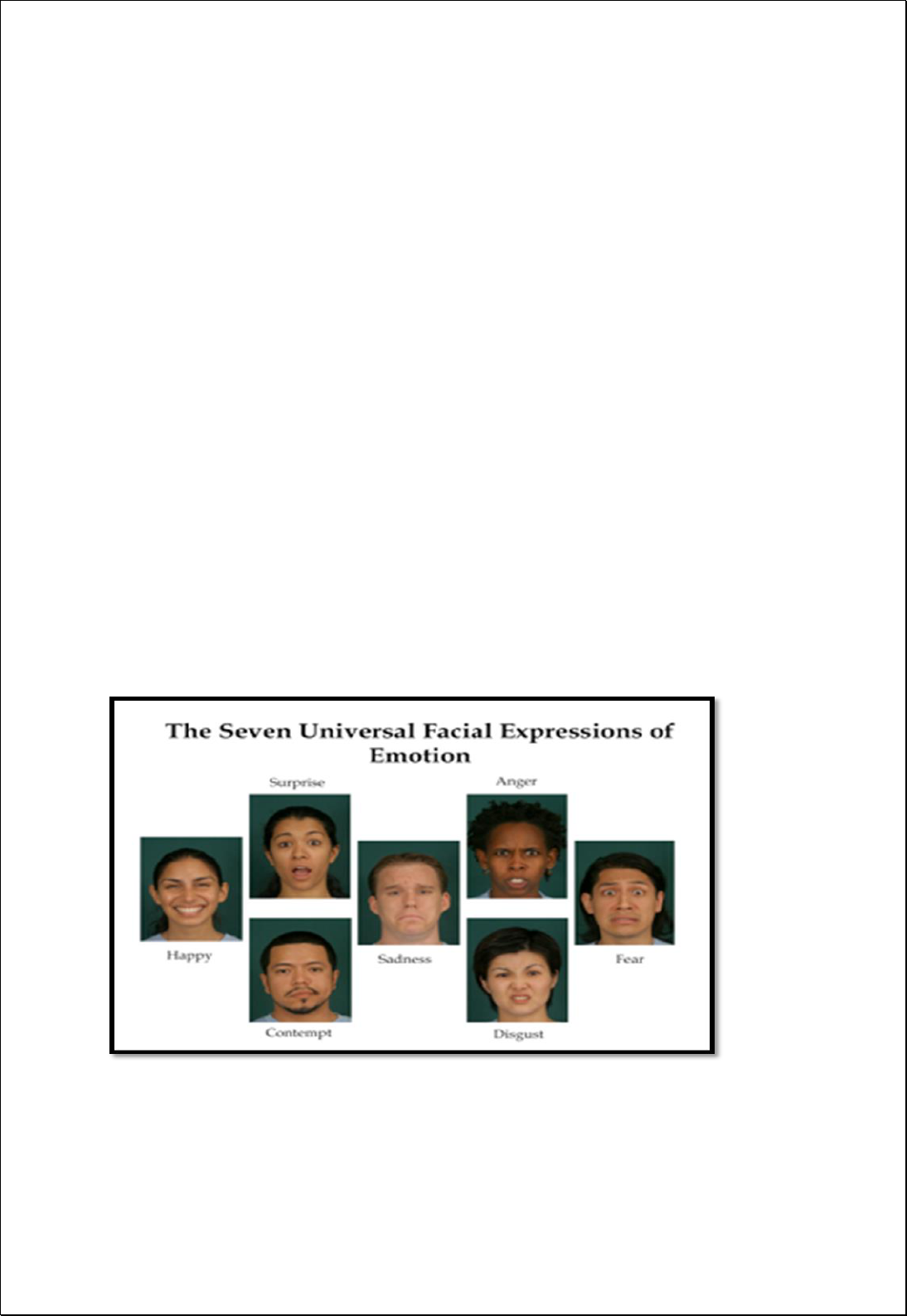
UNIT-IV
Unit-IV: Behavioural Techniques
Body Language: Facial expressions - Body posture – Gestures - Eye movement - Touch and the use
of personal space.
Business attire and Grooming: Different types of attire - Guidelines for business attire.
__________________________________________________________________________
Body Language
Body language refers to the nonverbal signals that we use to communicate. According to
experts, these nonverbal signals make up a huge part of daily communication.
From our facial expressions to our body movements, the things we don't say can still convey
volumes of information.
Body language is a type of a nonverbal communication in which physical behaviours are used
to express or convey the information. Such behaviour includes facial expressions, body
posture, gestures, eye movement, touch and the use of space.
1. Facial expressions
Think for a moment about how much a person is able to convey with just a facial expression. A smile
can indicate approval or happiness. A frown can signal disapproval or unhappiness.
In some cases, our facial expressions may reveal our true feelings about a particular situation. While
you say that you are feeling fine, the look on your face may tell people otherwise.
Just a few examples of emotions that can be expressed via facial expressions include:
Happiness
Sadness
Anger
Surprise
Disgust
Fear
Contempt
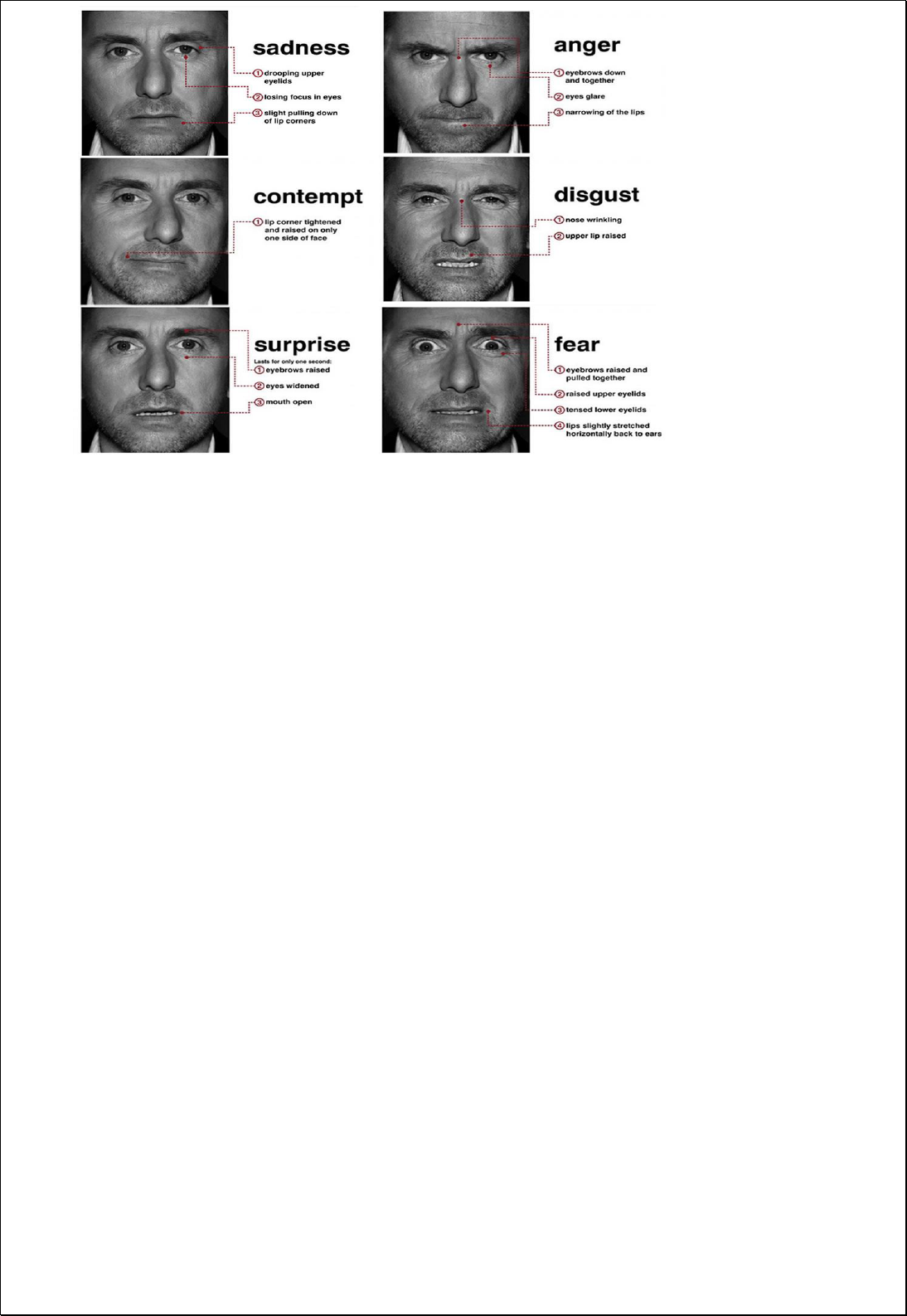
The expression on a person's face can even help determine if we trust or believe what the
individual is saying.
One study found that the most trustworthy facial expression involved a slight raise of the
eyebrows and a slight smile. This expression, the researchers suggested, conveys both
friendliness and confidence.
Facial expressions are also among the most universal forms of body language. The expressions
used to convey fear, anger, sadness, and happiness are similar throughout the world.
The eyes are frequently referred to as the "windows to the soul" since they are capable of
revealing a great deal about what a person is feeling or thinking.
As you engage in conversation with another person, taking note of eye movements is a natural
and important part of the communication process.
Some common things you may notice include whether people are making direct eye contact or
averting their gaze, how much they are blinking, or if their pupils are dilated.
When evaluating body language, pay attention to the following eye signals.
2. The Mouth
Mouth expressions and movements can also be essential in reading body language. For example,
chewing on the bottom lip may indicate that the individual is experiencing feelings of worry, fear, or
insecurity.
Covering the mouth may be an effort to be polite if the person is yawning or coughing, but it may also
be an attempt to cover up a frown of disapproval.
Smiling is perhaps one of the greatest body language signals, but smiles can also be interpreted in
many ways.
A smile may be genuine, or it may be used to express false happiness, sarcasm, or even cynicism.
When evaluating body language, pay attention to the following mouth and lip signals:
Pursed lips. Tightening the lips might be an indicator of distaste, disapproval, or distrust.
Lip biting. People sometimes bite their lips when they are worried, anxious, or stressed.
Covering the mouth. When people want to hide an emotional reaction, they might cover their
mouths in order to avoid displaying smiles or smirks.
Turned up or down. Slight changes in the mouth can also be subtle indicators of what a
person is feeling. When the mouth is slightly turned up, it might mean that the person is feeling
happy or optimistic. On the other hand, a slightly down-turned mouth can be an indicator of
sadness, disapproval, or even an outright grimace.
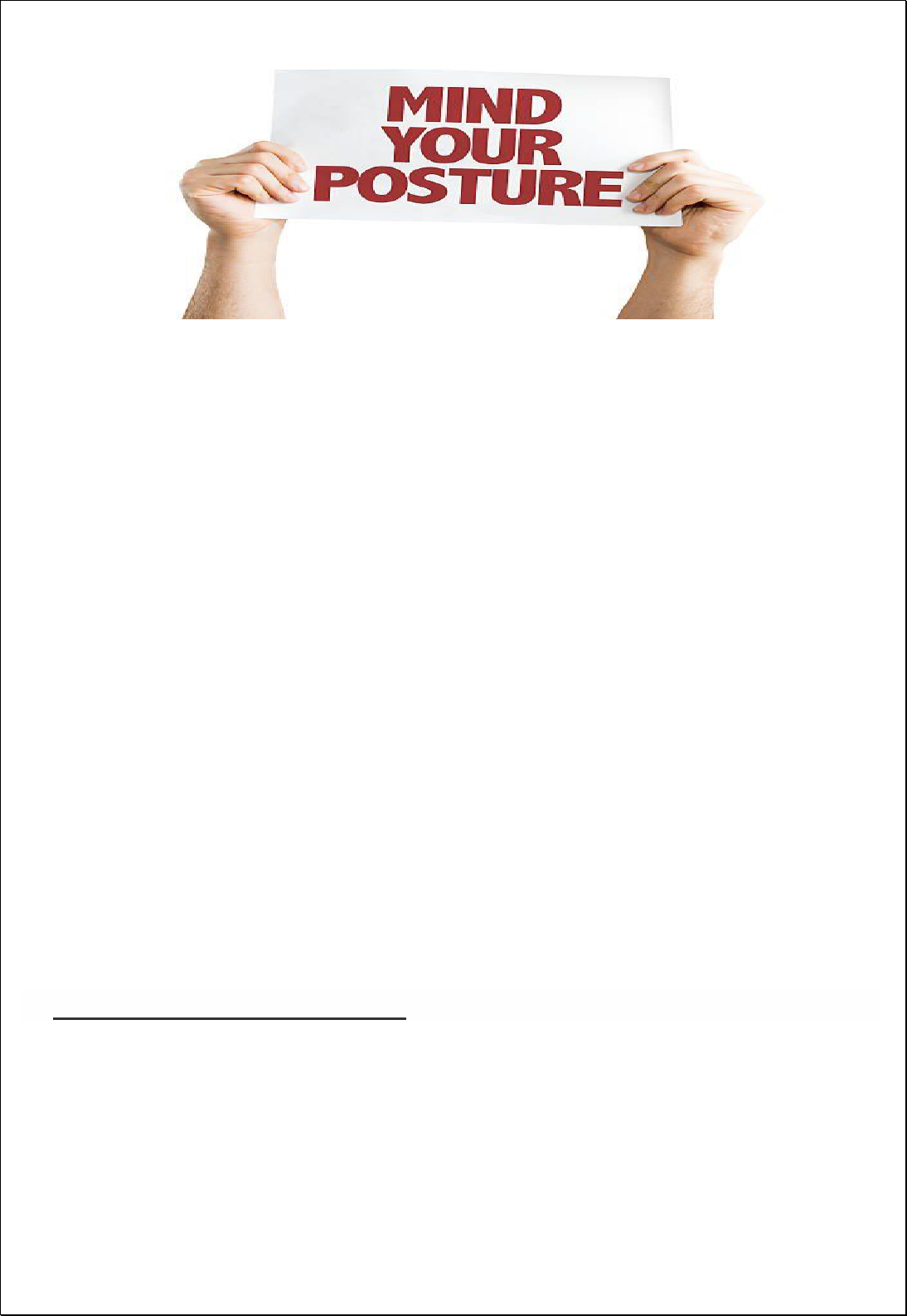
3.Posture
How we hold our bodies can also serve as an important part of body language.
The term posture refers to how we hold our bodies as well as the overall physical form of an
individual.
Posture can convey a wealth of information about how a person is feeling as well as hints about
personality characteristics, such as whether a person is confident, open, or submissive.
Sitting up straight, for example, may indicate that a person is focused and paying attention to
what's going on. Sitting with the body hunched forward, on the other hand, can imply that the
person is bored or indifferent.
When you are trying to read body language, try to notice some of the signals that a person's
posture can send.
Open posture involves keeping the trunk of the body open and exposed. This type of posture indicates
friendliness, openness, and willingness.
Closed posture involves hiding the trunk of the body often by hunching forward and keeping the arms
and legs crossed. This type of posture can be an indicator of hostility, unfriendliness, and anxiety
Emotions can also be detected through body postures. For example, a person feeling angry would
portray dominance over the other, and their posture would display approach tendencies. Sitting or
standing postures also indicate one's emotions.
A person sitting till the back of their chair, leans forward with their head nodding along with the
discussion implies that they are open, relaxed and generally ready to listen. On the other hand, a person
who has their legs and arms crossed with the foot kicking slightly implies that they are feeling
impatient and emotionally detached from the discussion
Consider how your perceptions of people are affected by the way they sit, walk, stand, or hold their
head. The way you move and carry yourself, communicates a wealth of information to the world. This
type of nonverbal communication includes your posture, bearing, stance, and the subtle movements
you make
Dos and don’ts of body posture
Do Stand Tall
For good body posture when standing, always hold yourself erect. Keep your head straight with your
chin tucked in. Pull your shoulders back, keep your stomach tucked in, and knees straight. Take care
not to let your hips jut out. Feel your body straighten up and visualize your head reaching skywards.
Make a conscious effort to follow this method of standing, always.

Do Lift Your Smartphone (Or Book!) Up Higher
Avoiding phone usage is not an option for most people. But you can improve your posture while
reading or texting. Instead of keeping your head bent down to read from your phone, bring the phone
up so it is at eye level. This should reduce the strain on your spine and neck. The same applies to
when you are reading a book.
Do Exercise To Improve Posture
Exercise can help fix balance issues, tighten up loose muscles, and build strength in muscles that
support good posture. For instance, exercises that help build core strength and flexibility are good to
include in your exercise regimen. Tai Chi and Yoga, in particular, are two activities to improve body
positioning and general awareness of your body and posture.
Do adjust your Workstation and Working Surfaces
Ensure your desk at work and countertops in the kitchen are at the right height for you.
If they aren’t, use a short stool or laptop table to adjust their height to something comfortable for
you.
Your desk should be at a height that allows the monitor of your computer to line up level to your eyes.
Your chair must allow your feet to sit flat on the floor and not dangling above the ground. If you are
short, put a footstool or footrest to ensure your thighs are parallel to the ground and feet flat on the
floor.
Get a chair that offers good back support.
Ensure your forearms are parallel to the floor and your arms make an L-shape at the elbows
Consider some activities to improve body position and seating mindfully, every hour or two. This
might be a series of stretches you do at your desk or even just straightening up your body and sitting
more consciously.
Don’t Slouch
This goes without saying, but slouching is terrible for your posture. It stresses the spine as well as
the muscles, joints, and bones that support it.
Don’t Play Statue!
Staying in the same position for a long time can be just as bad as having bad posture. Get up and
walk around every hour or so. Stretch your body in these breaks to ease any muscle tension.
Don’t Cross Your Legs When Seated
Crossing your legs can make your hips/pelvis rotate or tilt. After a while, this can bring on lower
back pain. Sit with your feet flat on the ground.
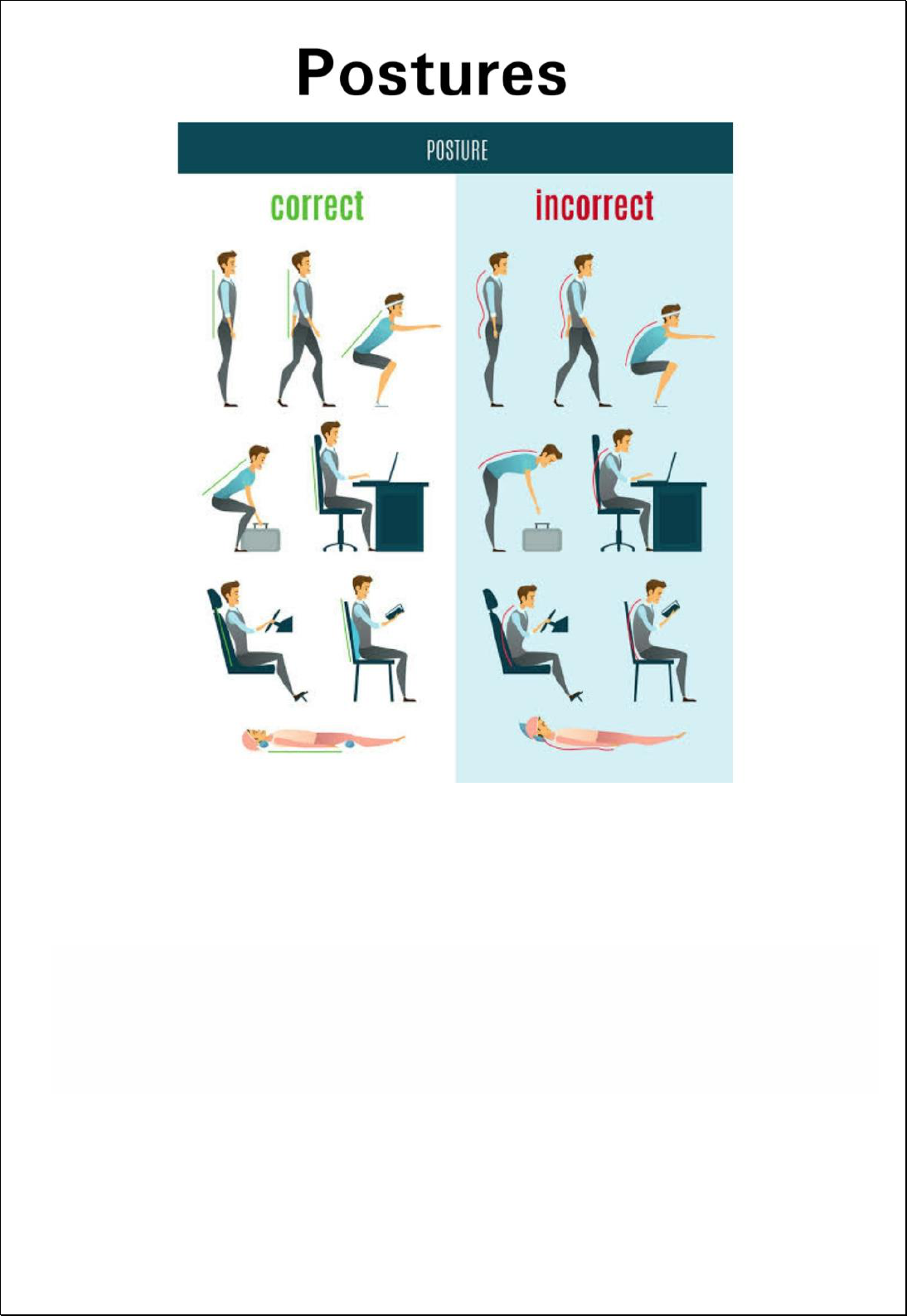
4. Gestures: Gestures are movements made with body parts (example hands, arms, fingers, head, and
legs) and they may be voluntary or involuntary. Different hand gestures help emphasize meanings and
regulate interaction between or among participants
Gestures are woven into the fabric of our daily lives. You may wave, point, beckon, or use your hands
when arguing or speaking animatedly, often expressing yourself with gestures without thinking.
However, the meaning of some gestures can be very different across cultures. While the OK sign made
with the hand, for example, conveys a positive message in English-speaking countries, it’s consider
offensive in countries such as Germany, Russia, and Brazil. So, it’s important to be careful of how you
use gestures to avoid misinterpretation.

DO:
Talk with your palms facing in an upward position. Doing this, so that people can see the inside of
your hand, dramatically increases “the degree of trust of what you are saying,” says Pease. People will
also more often associate this hand gesture with the adjectives of “friendly, laid back, easy going.”
“The reason behind this is because it’s a primal instinct, says Pease, “to should they show they are not
concealing anything in you hands or arms.
“It is hardwired into us, it’s a survival thing. You are being open and not threatening… It has a
soothing affect on people.”
Place your elbows on the outside of the chairs arms when sitting in a chair during a meeting.
According to Pease, people of high authority assume this position because it alludes authority and
confidence. “Elbows on the outside (of the chair) creates an atmosphere that your relaxed and you
don’t feel intimidated. Whereas if you are nervous or up tight they keep their elbows in beside their
ribs as a form of protection.”
Keep hand gestures no higher than your chin when talking or listening. This body language not
only maintains authority, says Pease, but more importantly “you’ll feel more authoritative.”
Keep your hand vertical when shaking hands to create rapport. This neutral position, as well as
maintaining an even pressure, will create a good first impression. The vertical hand presents you as an
equal, not overpowering or submissive, says Pease.
Use powerful gestures such as “the steeple”. This gesture looks “almost like you’re praying,
where the fingertips come together, makes you look and feel confident”, says Pease.
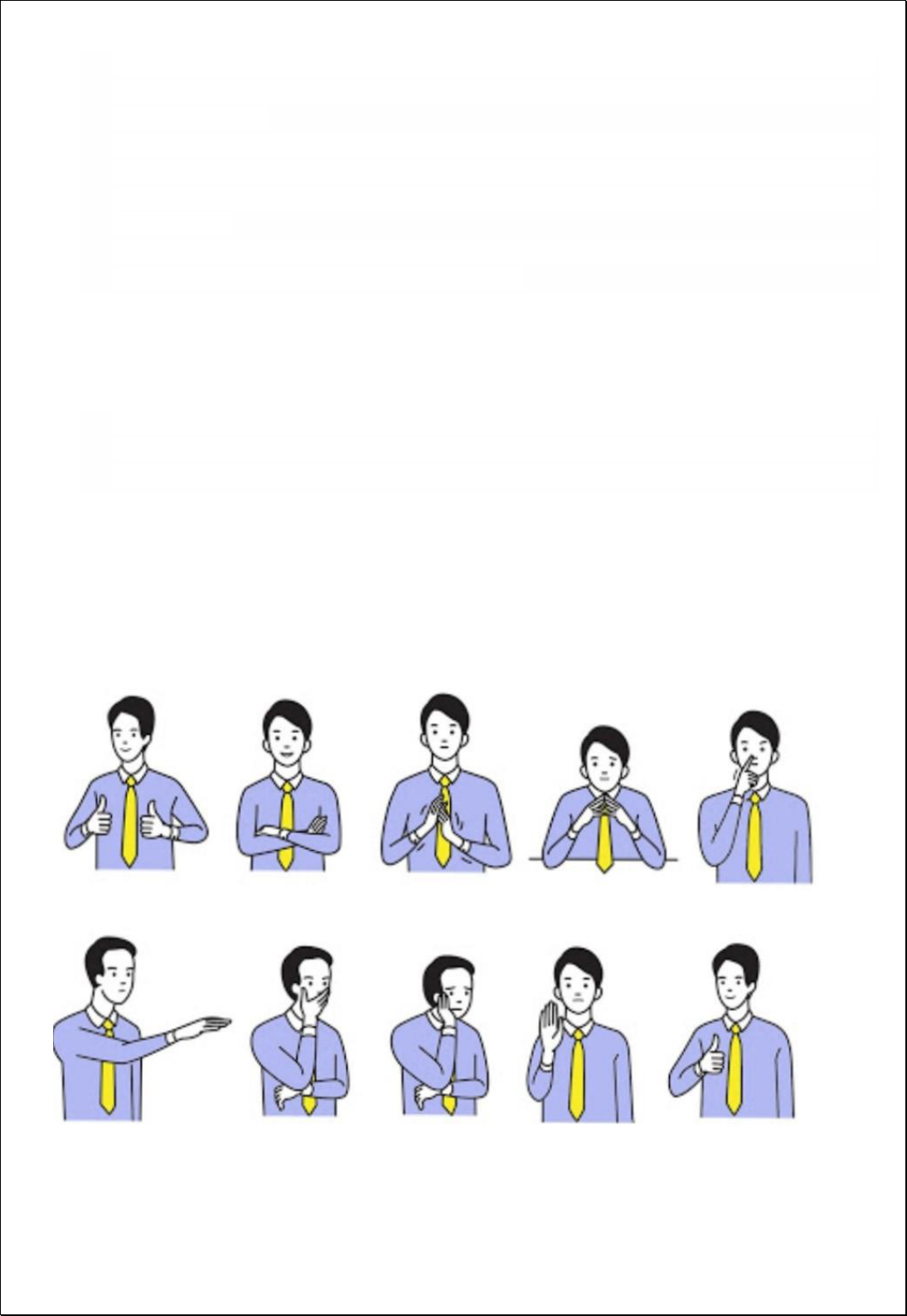
DON’T:
Talk with your palms facing down. According to a test done by Pease, “people recall up to
40% less. And remember you in harsher terms: authoritative, pushy, aggressive” when you use
this body language.
Point. “The rule is you can point at things, not people… You can point with your hand or a
pen.” In the same test by Pease “No one could remember much of what the finger pointer said
and just didn’t like that person… It is like having a small stick and you’re hitting someone with
it”, says Pease.
Talk with your hands higher than your chin. The higher above your chin, “the less
credibility people perceive you’ve got”, says Pease.
Splay your fingers. “For those who don’t feel confident, when they use their hand they spread
their fingers.
“Perhaps is comes down to ancient primal signal that you’ve got nothing, and you’re totally
unthreatening,” says Pease. But in a business meeting when you are trying to appear successful
and confident, it is not a signal you want to give off.
Put your hands behind your back, in your pockets or crossed in front of yourself.
According to Pease these are three big no-nos. “If your palms are out of sight, people get
suspicious. You ancient brain is saying ‘Why is this person not showing me they’re unarmed?'”
Handshake with both your hands over the other persons “Never gives a double-handed
(handshake) on a first meeting – ever,” Pease says. “This is because you want people to feel
accepting of you and not intimidated. By using two hands you are taking control.”
But most importantly gestures must only be used in sync with what you are saying. Hand
movements are great way to aid what you are communicating but only if it is reinforcing what
you are saying.
The following examples are just a few common gestures and their possible meanings:
A clenched fist can indicate anger in some situations or solidarity in others.
A thumbs up and thumbs down are often used as gestures of approval and disapproval.
The "okay" gesture, made by touching together the thumb and index finger in a circle while
extending the other three fingers can be used to mean "okay" or "all right."

In some parts of Europe, however, the same signal is used to imply you are nothing. In some
South American countries, the symbol is actually a vulgar gesture.
The V sign created by lifting the index and middle finger and separating them to create a V-
shape, means peace or victory in some countries. In the United Kingdom and Australia, the
symbol takes on an offensive meaning when the back of the hand is facing outward.
The Arms and Legs
The arms and legs can also be useful in conveying nonverbal information. Crossing the arms
can indicate defensiveness. Crossing legs away from another person may indicate dislike or
discomfort with that individual.
Other subtle signals such as expanding the arms widely may be an attempt to seem larger or
more commanding while keeping the arms close to the body may be an effort to minimize
oneself or withdraw from attention.
When you are evaluating body language, pay attention to some of the following signals that the
arms and legs may convey:
Crossed arms might indicate that a person feels defensive, self-protective, or closed-off.
Standing with hands placed on the hips can be an indication that a person is ready and in
control, or it can also possibly be a sign of aggressiveness.
Clasping the hands behind the back might indicate that a person is feeling bored, anxious, or
even angry.
Rapidly tapping fingers or fidgeting can be a sign that a person is bored, impatient, or
frustrated.
Crossed legs can indicate that a person is feeling closed off or in need of privacy
4. Eye movement
Oculesics -Oculesics, a subcategory of body language, is the study of eye movement, eye behaviour,
gaze, and eye-related nonverbal communication. Eyes are said to be the window to the soul. -
Through eye contact, one can tell if the other party is paying attention to the speaker’s words. - It can
also help in determining whether one is saying the truth or not. - Through eye contact we can be able
to know one’s emotional condition.
Eye Gaze: When a person looks directly into your eyes while having a conversation, it indicates that
they are interested and paying attention. However, prolonged eye contact can feel threatening.
On the other hand, breaking eye contact and frequently looking away might indicate that the person is
distracted, uncomfortable, or trying to conceal his or her real feelings.
Blinking: Blinking is natural, but you should also pay attention to whether a person is blinking too
much or too little.
People often blink more rapidly when they are feeling distressed or uncomfortable. Infrequent blinking
may indicate that a person is intentionally trying to control his or her eye movements.
For example, a poker player might blink less frequently because he is purposely trying to appear
unexcited about the hand he was dealt.
Pupil Size
Pupil size can be a very subtle nonverbal communication signal. While light levels in the environment
control pupil dilation, sometimes emotions can also cause small changes in pupil size.
For example, you may have heard the phrase "bedroom eyes" used to describe the look someone gives
when they are attracted to another person. Highly dilated eyes, for example, can indicate that a person
is interested or even aroused.

Tips for Making Eye-Contact
Turn your shoulders and head to face the other person's eyes. Opening up your body to the
other person tells them you are listening, engaged, and ready to communicate. It also makes
eye contact easier and more natural to maintain. Position yourself a few feet away from the
other person's face
Choose a focal point near the eyes. Most commonly, this is one of the other person's eyes, but
if you are uncomfortable you can look between their eyes, just under or above the eye, or at the
earlobe.
Make gentle eye-contact. Think of how you would look at a painting or great view -- you are
not focusing intently on their eye but instead looking at them gently. Hold your eyes in this
position and resist darting them around. Relax your gaze by breathing slowly as you make eye-
contact and nodding occasionally while you listen.
Break eye contact briefly every 5-15 seconds.
Too much eye-contact can be as off-putting as
none at all.
While you don't need to count the seconds, you should look away every once in a
while to keep the conversation light and easy, but only for a few seconds. Some casual ways to
do so include:
Laughing, nodding, and acknowledging the other person.
Looking at the sky/weather.
Looking off to the side briefly, as if remembering something.
Running your hands through your hair.
Guidelines for Practicing Good Eye-Contact
Make a conscious effort to start making eye-contact slowly. Do not try to force yourself to
hold the eyes of every person you meet if you are uncomfortable. Start slowly, reminding
yourself to make eye-contact in every conversation.
It is easier to practice while listening to someone instead of while you are talking.
Make "whole-face contact" to make your eye's feel more natural. Smile and nod along to
the conversation, rotating your gaze though eyes, the person's nose, and mouth. When talking,
don't feel like you have to make eye-contact the entire time-- change your expression or look
away to keep the other person's interest.
Practice with a TV, web-camera, or mirror. If you struggle with real people, you can
practice with a screen or mirror. Try to make eye-contact with every character you can on TV
or video blogs. News channels, where the anchor looks right at the camera, are a great way to
practice comfortably in your home.
Know when good eye-contact is essential. Making eye-contact is a sign of trust, reliability,
and openness, and helps in a variety of social settings. However, there are some settings when
it is vital for success.
Job Interviews: Good eye-contact tells a boss that they can trust you. Be sure to look them in
eyes while you talk, as it assures them that you know what you're talking about.
5. Touch & use of Personal Space
Touch. We communicate a great deal through touch. Think about the very different messages given by
a weak handshake, a warm bear hug, a patronizing pat on the head, or a controlling grip on the arm, for
example.
Have you ever heard someone refer to their need for personal space? Have you ever started to feel
uncomfortable when someone stands just a little too close to you?
The term Proxemics, coined by anthropologist Edward T. Hall, refers to the distance between people
as they interact. Just as body movements and facial expressions can communicate a great deal of
nonverbal information, so can the physical space between individuals.
Hall described four levels of social distance that occur in different situations.

Intimate Distance: 6 to 18 inches
This level of physical distance often indicates a closer relationship or greater comfort between
individuals. It usually occurs during intimate contact such as hugging, whispering, or touching.
Personal Distance: 1.5 to 4 feet
Physical distance at this level usually occurs between people who are family members or close friends.
The closer the people can comfortably stand while interacting can be an indicator of the level of
intimacy in their relationship.
Social Distance: 4 to 12 feet.
This level of physical distance is often used with individuals who are acquaintances.
With someone you know fairly well, such as a co-worker you see several times a week, you might feel
more comfortable interacting at a closer distance.
In cases where you do not know the other person well, such as a postal delivery driver you only see
once a month, a distance of 10 to 12 feet may feel more comfortable.
Public Distance: 12 to 25 feet
Physical distance at this level is often used in public speaking situations. Talking in front of a class full
of students or giving a presentation at work are good examples of such situations.
It is also important to note that the level of personal distance that individuals need to feel comfortable
can vary from culture to culture.
One oft-cited example is the difference between people from Latin cultures and those from North
America. People from Latin countries tend to feel more comfortable standing closer to one another as
they interact while those from North America need more personal distance.
These rules vary according to culture and location, so they're not etched in stone. They're here as a
guideline for social and professional etiquette.
Here are some basic rules:
1. Never touch anyone you don’t know.
2. Don’t reach for anyone else’s children, regardless of your intentions.
3. Stand at least 4 feet away from a person unless you know him or her well.
4. When someone leans away from you, you are probably in that person’s space that makes him
or her uncomfortable. Take a step back.
5. If you walk into an auditorium or theatre that isn’t crowded, leave an extra seat between you
and the next person. However, it is acceptable to sit next to someone if the room is crowded.
6. Never lean over someone else’s shoulder to read something unless invited.
7. Never go through anyone else’s personal belongings.
8. Don’t allow your dog to go to the bathroom on someone else’s property.
9. Acknowledge personal space on the road. Don’t tailgate when driving.
10. Don’t fling your arm around someone’s shoulder or slap anyone on the back unless you know
the person very well.
11. Don’t enter a room or office without knocking first.
12. Don’t cut in front of people in line.
BUSINESS ATTIRE
Business attire is the clothing that is acceptable at work.
Business attire can influence the impression of your boss, co-workers, and customers
about your capabilities and professionalism.
Appropriate business attire can vary from company to company and even from job to
job within that company.
There are several levels of formality, ranging from casual to business formal.
Business attire is often dictated by a written company dress code, which can explain
what is acceptable clothing and what is not.

Types of Business Attire
1. Business Formal: If the dress code at your workplace is business formal, then the following attire
would be appropriate:
Men:
Formal suit, tie, and business shirt
Upscale sports jacket, dress pants, tie, and business shirt
Leather dress shoes
Conservative leather accessories such as a briefcase or portfolio
Watches and cologne should be subtle
Women:
Skirt suit
Pantsuit
Formal business blouse or top
Stockings
Closed-toe leather shoes
Conservative business accessories such as a briefcase or a leather folder for pads of paper
Subtle jewellery, makeup, and perfume
1
2. Smart Casual: Smart casual business attire is just a step down from traditional, formal attire.
Men:
Sports jacket with a tie, dress pants, and button-down or traditional business shirt or nice
turtleneck
Dress shoes
Accessories as described in traditional business attire
Women:
Jacket or dressy sweater
Dress pants or skirt
Blouse, shirt, top or turtleneck
Hose
Dress shoes
Accessories as described in traditional business attire
3. Business Casual: Business casual attire is slightly more casual than smart casual and permits
more comfortable cuts and fabrics.
Men:
Khakis or dress pants
Shirts with collars or golf or polo shirts
Sweaters
Vests
Occasionally an informal jacket and tie
Attractive leather shoes and accessories
Women:
Nice pants or skirt
Blouse, top, or sweater
Vest
Occasionally an informal jacket
Attractive leather shoes and accessories
4. Casual: If you want to dress appropriately in a casual workplace, you may find yourself wearing
jeans and other casual wear.
Men:
Casual pants
Jeans
Shirt, with or without collar
Sweater

Vest
Sweatshirt
Casual shoes
Women:
Casual pants
Jeans
Casual skirt
Blouse, top, or sweater
Vest
Sweatshirt
Casual shoes
Even with a casual business attire dress code, some articles of clothing are almost always
inappropriate, no matter the workplace, including ripped or shredded clothing, flip-flops, beachwear,
and tops that reveal the midriff.
ETIQUETTES:
Etiquette is merely a set of guidelines for politeness and good manners, the kindnesses with which we
should always treat each other. It will always matter!
Without etiquette, members of society would show far too much impatience and disrespect for one
another, which would lead to insults, dishonesty, cheating, road rage, fist fights, and a rash of other
unfortunate incidents.
1. Greeting etiquette
In business, who you know matters and first impressions are the longest lasting. That's why it's so
important to make the best impression when greeting someone by using the proper business greeting
etiquette, which will help guarantee you start your relationship right every time.
Of course, because greeting etiquette around the world and even among different industries varies, be
prepared to adjust your greeting slightly based on circumstance when necessary.
1. Stand Up
When you’re greeting new people, do so face-to-face. It’s just polite, and shows respect. It means that
you consider them important enough to change your physical position for them. It also helps you to
make eye contact.
2. Make Eye contact
Making eye contact indicates engagement and focus. It shows that you’re interested in the other
person. Staring at your shoes, your watch, or your phone shows the opposite, and suggests
disengagement. Use positive body language.
3. Have a Smile
Even if you’re carrying the woes of the world on your shoulders, try to look happy to see your new
acquaintance. A grimace immediately puts the other person on the defensive, while a smile is
welcoming and inclusive.
4. Take the Initiative with a Handshake
Approach the person you’re greeting and extend your hand. You’ll come across as confident
and assertive, not aggressive. Don’t wait for the other person to take a lead.
Keep it simple: shake firmly, but avoid the “death grip.” A “limp fish” leaves an equally poor
impression. And keep your spare hand by your side: two-handed pumping and hands on shoulders are
strictly for politicians.

5. Introduce yourself
Even better, say why you’re there and what you do. “Hi, I’m Suresh” is a start. “Hi, I’m Suresh. I’m an
account manager with the Client Success team. How can I help?” is actually useful, and shows you’re
making the effort.
6. Observe the Hierarchy
If you’re making the introductions, remember business etiquette. Introduce less senior people to more
senior ones. Start with the name of the senior person, and then introduce the junior person to them.
As you did when you introduced yourself, give some context. So, “Colette, may I introduce Phil? Phil
is our new lead developer. Phil, Colette is our chief financial officer.”
7. Get the Name Game Right
Make sure that you remember the name of anyone you’ve been introduced to, and use the name
properly. It’s better to ask the person to repeat the name than to keep using an incorrect version.
Wait for permission before using someone’s first name. It’s respectful. Some people don’t like
informality from the get-go, and it may be seen as culturally insensitive.
2. Corporate Etiquette
An individual must know how to behave at the workplace. There is a huge difference between college
and professional life. One needs to be disciplined at the workplace.
Corporate Etiquette refers to set of rules an individual must follow while he is at work. One must
respect his organization and maintain the decorum of the place.
Corporate Etiquette refers to behaving sensibly and appropriately at the workplace to create an
everlasting impression. No one would take you seriously if you do not behave well at the workplace.
Remember we can’t behave the same way at work place as we behave at our homes. One needs to be
professional and organized.
It is important to behave well at the workplace to earn respect and appreciation.
Let us go through some Do’s and Don’ts at workplace:
Never adopt a casual attitude at work. Your office pays you for your hard work and not for
loitering around.
Don’t peep into other’s cubicles and workstations. Knock before entering anyone’s cabin.
Respect each other’s privacy.
Put your hand phone in the silent or vibrating mode at the workplace. Loud ring tones are
totally unprofessional and also disturb other people.
Don’t open anyone else’s notepads registers or files without his permission.
It is bad manners to sneeze or cough in public without covering your mouth. Use a
handkerchief or tissue for the same.
Popping chewing gums in front of co-workers is simply not expected out of a professional.
Stay away from nasty politics at the workplace. Avoid playing blame games.
Keep your workstation clean and tidy. Throw unwanted paper in dustbin and keep files in
their respective drawers. Put a label on top of each file to avoid unnecessary searching.
Never criticize or make fun of any of your colleagues. Remember fighting leads to no
solution. There are several other ways to express displeasure. Sit with your colleagues, discuss
issues face to face and decide on something which is mutually acceptable.
Take care of your pitch and tone at the workplace. Never shout on anyone or use foul
words. It is unprofessional to lash out at others under pressure. Stay calm and think rationally.
Never attend meetings or seminars without a notepad and pen. It is little tough to
remember each and everything discussed in the meeting. Jot down the important points for
future reference. Wait for your turn to speak.

Pass on information to all related recipients in the desired form. Communicate through
written modes of communication preferably through emails. Keep your reporting boss in the
loop. Make sure your email signatures are correct.
Reach office on time. One must adhere to the guidelines and policies of the organization.
Discipline must be maintained at the workplace.
No organization likes to have a shabbily dressed employee. Shave daily and do not use
strong perfumes.
Never wear revealing clothes to work. Body piercing and tattoo are not allowed at the
workplace. Females should avoid wearing heavy jewelry to work.
Don’t pass lewd comments to any of your fellow workers.
While having lunch together, do not start till the others have received their food. Make
sure your spoon and fork do not make a clattering sound. Eat slowly to avoid burping in public.
Respect your fellow workers and help them whenever required.
It is unethical to share confidential data with external parties and any other individual who is
not related to the organization. Data in any form must not be passed to anyone outside the
organization.
Office Stationery is meant to be used only at work. Taking any office property back home is
equivalent to stealing.
Make sure you turn off the monitor while you go out for lunch or tea breaks. Switch off
the fans, lights, printer, fax machine, scanner before you leave for the day.
Don’t bring your personal work to office. Avoid taking kids to office unless and until there is
an emergency.
Park your car at the space allocated to you. Don’t park your vehicle at the entrance as it
might obstruct someone’s way.
Never ever drink while you are at work. Smoke only at the smoking zones.
Do not leave the restroom with taps on.
Female Employees should stick to minimal make up.
3. Telephone etiquettes
These are some basic manners that everyone in Business should follow because what you say
represents you, your organization and your ideas. All of these deserve to be portrayed in the best
possible manner. There are certain thumb rules that we go by in Business.
Keep a pleasant voice pitch. Use warm wishes like “good morning, “how are you, good sir?”
and such. First impressions are the last impressions. So make them last.
Know your audience: It’s important to know who you are speaking to set the tone and use
relatable language with them.
Never call any person at odd hours like early morning or late nights as the person will
definitely be sleeping and will not be interested in talking to you.
If you are the one who has called, before starting the conversation, introduce yourself first and
then definitely confirm whether you are talking to the right person. Example – Hello sir. Good
morning. My name is Ajay; I am calling from ABC limited. Am I speaking with Ravi?”
Make sure your content is crisp and relevant. Don’t play with words, come to the point
directly and convey the information as required. If you the one dialling, first prepare your
content thoroughly and then only pick up the receiver to start interacting.
Re-check the dialled number to avoid unwanted confusion and mistakes.
Remember you are making a conversation. Be a good listener and always ask for feedback to
know whether you have the other person on the same page as you. Also, when the call is done,
always ask politely to the person on the other hand if that is all? Then end with pleasantries.
Always speak each and every word clearly. The person on the other end can’t see your
expressions so remember your tone should be apt to express your feelings in the correct form.
Very important telephone etiquette is to never put the second party on very long holds. It
is rude and may cause irritation to the person on the other end.
If there are disturbances around like TVs, radios, etc., it’s telephone etiquette to turn its volume
down so you are audible to the person on the line.

If you are eating and it is a formal phone call, it does not sound good. First off, all calls must be
scheduled on non-lunch hours. If there are unplanned calls that are business related, either ask
for pardoning you till you finish eating or maybe take a break from eating or finish the call
first. Not only do we sound funny when we speak on the phone while eating, but we can also
be not clearly understood.
It is hard to concentrate on the person on the line if you are focusing on other activities like
watching a video, reading a book, eating, playing video games, etc. It may very well come off
as irresponsible and disinterested to some.
One of the important telephone etiquettes is to not take too long to pick up a call. If you
miss the call, make sure you give a call back as the other person might have an important
message to convey. Avoid giving missed calls at workplaces as it irritates the other person. Be
professional and always approach first if you are the one in need.
Do not leave your phone numbers on your emails for them to call you if you are the one
approaching for work.
In professional talks, never keep the conversation too long as the other person might be busy.
Always keep the content crisp and relevant and do come to the point after formal greetings.
If you are not the correct person and the speaker needs to speak to your co-worker always
politely say “one moment please- I will call him/her in a minute”. If the colleague is not in the
office premises, always take a message on his/her behalf and don’t forget to convey to him
when he is back. Also, it is best if you do not discuss these messages with others as some
information could be sensitive too.
If you have network issues between a call, deal with it patiently and wisely. People tend to
raise their voices when the network is the issue. If it’s a patchy network, even a raised voice is
going to sound patchy. So do not resort to yelling. Moreover, it causes disturbance to others
around you. Check your network, if the issue is at your end, politely tell them you are
disconnecting the call to find a better spot to call back from.
Chances are they won’t be able to hear it, but you have no choice. If re-connection takes to
long, leave them a message with a re-scheduled call. In case the network disturbance is from
the other person’s end, politely tell them that you are facing difficulty in hearing them. Kindly
ask them to find a network zone.
4. Email Etiquette
Have you ever received an email that left you wondering about the person who sent it? Or worse, have
you ever sent an email that you later regretted? Being on the receiving end of a bad email can leave
you shaking your head and trying to figure out what on earth the other person was thinking. Being the
one who sent it can ruin an otherwise great day, and it can have adverse repercussions later.
Whether you send a personal or business email, following proper etiquette is essential to prevent
miscommunication or hard feelings.
Follow the Golden Rule by treating the recipient as you would want to be treated. Before you click
“send” on any email take a minute and give it an extra read-through. Effective use of email can put you
in a positive light with your supervisor and may even give you an edge when it's time for a promotion.
1. Don't Assume Privacy: Keep in mind that your company and personal email may not be private. Your
company has the right to read anything sent from the office, so never write and send personal or highly
sensitive information from work. Personal email from home may be forwarded, so don’t put anything in
writing that could cause a problem if it reaches the wrong person.
2. Avoid Offensive Comments: Avoid offensive comments in your email. This includes racist, sexist, or
negative remarks about another person or company. If you receive an offensive email, don’t reply or
forward it to anyone. Never use email to say anything that can be misconstrued or misinterpreted if it
gets back to your boss.

3. Edit Your Messages: Edit your emails before you send them. Use spellchecker and go over all business
emails to make sure you have proper grammar. You always want to present yourself as a professional in
all correspondence. Check personal email after you finish writing it to make sure it gets your intended
point across. Dropping or adding a single word can change the meaning of a sentence.
4. Reply with Caution: Know the proper way to reply to the emails you receive. Pay close
attention to the sender and the others in the “to” and “cc” fields. Respond as quickly as possible
rather than let your “saved” folder become too cluttered.
Avoid the urge to hit “reply all” before looking to see who is listed in the header. Your
response may confuse others on the list or you might wind up sending unnecessary information
to people you don’t know. The only time you should click “reply all” is if you are sure
everyone needs the information you are sending.
5. Know Your Email Tools:
Know the tools and types of email. This includes “to,” “cc,” “bcc,” and subject lines. The
main recipient should be in the “to” field. When you need to copy someone, you would
normally add that person to the “cc” or carbon copy field. If someone needs to be copied
without the others on the list receiving his or her email, use “bcc” or blind carbon copy. Only
copy people who need to know the information you are sending.
Never forward chain emails to anyone. These can be cumbersome and clog people’s email
boxes to the point of annoyance. You don’t want to become the person who forwards messages
that may or may not be true.
You should always fill in the subject line for a business-related email, and it is preferred in a
personal email. Keep the subject line as short as possible and only have one topic per mailing.
6. Keep It Brief
Most people prefer brief emails rather than long, wordy messages. If possible, state your point
in a couple of sentences. For a longer message, start with an introductory paragraph letting
people knows the basics. If you have more than one topic, split your message into more than
one mailing, with one topic per email.
7. Watch Your Tone
Save the sarcastic humor for voice communications so others can hear the tone of your voice.
This also includes anger. You should always avoid sending angry emails, or you may risk
offending someone you work with or care about.
8. Sign Your Name
Don’t forget to sign your emails. The recipients may get annoyed if they have to scroll up to figure out
who sent them the message. If you expect a response by phone, be sure to include the number, even if
you know the person has it on file. The purpose of email is to save time, and having to stop what he or
she is doing will slow things down. If you have a signature line, keep it updated with the proper email
address and phone numbers.
5.Meeting Etiquette
One must learn to maintain the decorum of the work place. It is important to respect one’s organization
to expect the same in return. No one would ever take you seriously if do not behave well at the
workplace.
Meetings are an important part of corporate where employees sit together on a common platform,
exchange their views and opinions and reach to a solution benefitting the organization and mutually
acceptable to all.
Meeting Etiquette refers to codes of behaviour an individual ought to follow while attending
meetings and discussions at the workplace.

Let us go through some meeting etiquette in detail:
Try to find out what the meeting is all about. Understand the importance of the meeting. Never
go blank. Employees should do all the ground work before attending meetings to ensure
maximum participation from their end. Prepare notes in advance.
Never attend meetings without a notepad and pen. It is practically not possible for an individual
to remember each and every thing discussed at the time of meeting. A notepad helps in jotting
down the important points for future reference.
Always keep your cell phone on the silent or vibrator mode. Cell phones ringing in the middle
of meetings and seminars are considered rude and unprofessional. This might insult others
sitting in the same room as well as break the pace of the meeting.
Do not attend phone calls during meetings unless it is an emergency. It is bad manners to do
the same.
Superiors must create an agenda before every meeting. The agenda must be circulated among
all employees for them to prepare in advance. Meetings should not be conducted just for the
sake of it. It is important to have well defined plans. Make a list of issues to be discussed at the
time of meeting. Make sure you do not deviate from the key points. Keep the meetings short.
Never be late for meetings. Going late for a meeting is something which is not expected out of
a professional.
Chewing gum during meetings is childish and must be avoided.
Be a good listener. Listen to what others have to say. Wait for your turn to speak.
Sit wherever you find a place. Do not run here and there.
Do not enter the meeting room once the meeting has already begun It disturbs others.
Avoid taking your cups of coffee or tea to meeting rooms unless and until advised by superiors.
Fiddling with pen or notepad is one of the major distractions in meetings. One must concentrate
and stay alert. Be an attentive listener. Do not yawn even if you find the meeting boring.
The one chairing the meeting must speak loud and clear. It is essential to take care of the pitch
and tone.
Meetings ought to be interactive and allow employees to come up with their suggestions and
valuable feedback. A question answer round must be kept at the end for employees to clear
their doubts.
Once the meeting is over, minutes of the meeting must be prepared and circulated across all
departments for them to take necessary action
Use Whiteboards, projectors, graphs, pointers, slides for better clarity.
Do not convert the meeting room into a battle ground. Speak politely and do respect your
colleagues.
Never attend meetings in casuals. Follow a professional dress code.
6. Netiquette
The internet often plays a huge part in many young people’s daily activities; allowing them to
communicate freely with others and share information with ease via messaging apps, social media and
gaming networks.
At any one time they can be navigating a whole host of different apps, with some of the most popular
ones being Snapchat, Instagram and WhatsApp. With so much of their lives playing out online, it is
important for young people to consider how their online behavior and choices can have an impact on
themselves, and others.
1. Be respectful. Everyone has different feelings and opinions and it is important to respect this
online. You may wish to comment on something someone has shared but always remember that behind
every account is a real person.
2. Be aware of how your comments might be read: Strong language, capital letters, and exclamation
marks can be easily misinterpreted online. In the real world we have the addition of body language,
tone of voice and facial expressions to help us understand what someone has said. We also have the
opportunity to re-phrase what we say if we’re misunderstood in the offline world. When you are
online, these are missing.

3. Be careful with humor and sarcasm. It’s always great to share jokes with others and it is
important to be yourself online and let your personality shine through. However, not everything is
always clear online and sometimes people might not realize you are joking. Often people rely on
emoji’s or texts speak.
4. Think about who can see what you have shared. Privacy settings are a simple way to restrict who
can see what you are sharing, but even with them in place nothing is ever truly private online. Make
sure you keep as much of your personal information off the internet as possible and never share
anything inappropriate or that may get you into trouble.
5. Remember to check friend requests and group invites before accepting them. The internet is a
great place to share content and chat to friends but remember to review any new requests before
accepting them. Check if they are from someone you know or were expecting to receive a request
from.
6. Take time to have a read of the rules of conduct/ community standards. Most online forums,
social networks and gaming networks have their own code of conduct or guidelines for a user’s online
behavior. Every user has the right to have the same positive experience online. The services you’re
using use these guidelines to help guide and support you so that you know what will and won’t be
tolerated on their service
7. Be forgiving. The online world can be very different from the offline world so try to be
understanding of others when they struggle with online communication. If you see something online
that you don’t think is appropriate, you can use reporting tools to flag it to the site’s safety team.
7. Personal etiquette
There are times throughout every day of your life when you have to make a choice of whether to use
good etiquette or be that person whose friends and family start avoiding. Even under the most trying of
situations, it isn’t that much more difficult to be well mannered, and you’ll ultimately feel better later
if you do the right thing.
Be Friendly and Polite
If you step outside your house during the day, you’re likely to encounter people, so try to be friendly.
Even on miserable days when everything seems to be going wrong, forcing a smile has the potential to
lift the mood of not only the person you’re looking at but yours as well. Offer a greeting, and you
might even see an extra ray of sunshine.
Certain words carry a tremendous amount of power when you care enough to be polite and civil to
others. Add “please,” “thank you,” “you’re welcome,” and “excuse me” to your vocabulary, and you
may find others responding with reciprocated kindness. You get extra points in the manners and
conversation department if you include a compliment, such as, "Good job," or "You look nice today."
Be On Time
Avoid being late for an appointment with anyone, whether it's your doctor or your child. Being on time
shows your respect for the other person.
When you're late for meetings, appointments, work, get-togethers with friends, or anything else, you're
forcing others to wait, which is a huge waste of their time. They'll never get those minutes or hours
back. Remember how you feel when you've had to wait for someone.

Be a Helper
You don’t have to be a Boy Scout to help out your fellow citizen. If you see someone whose arms are
overloaded with packages, open the door for them. Also, if you have just entered a building and
someone is right behind you, hold the door to keep it from slamming in his or her face. These gestures
of kindness are simple but make a big difference in everyone's mood.
Respect Others
When you interact with other people, you need to respect them. Allow others to voice their opinions
without argument. Respect their personal space as you would want others to respect yours. When you
are in the company of someone of greater authority, show him or her proper respect.
Let Others Go First
If you can let others go first without awkwardness, then do it. This includes walking, standing in line,
and driving. A woman with small children will appreciate getting through the checkout lane quickly,
particularly if her children are hungry or bored. If a driver needs to move into your lane, and you can
let him in without the person behind you rear-ending you, then gesture for him to go ahead.
Hold Down the Noise
This world has become too noisy, so try not to add to it. Keep your cell phone ringer volume as low as
possible. If you work in an office cubicle, be considerate of your fellow office mates by keeping your
voice low while chatting on the phone.
Eat Politely
Whether you brought your lunch or you’re eating out with friends, everyone appreciates good table
manners that your parents should have taught you. Keep your elbows off the table, don’t talk with your
mouth full, and avoid reaching across people to grab the saltshaker. Formal dinners have more
etiquette rules, so if you’ll be going to one of those, take a little time to brush up on what’s expected.
When eating in a restaurant, there are additional rules you need to follow. You need to be considerate
of everyone, from others in your group to the server. Make sure you talk to your children about
behaving properly before you take them to a restaurant so they'll be welcome back.
Remove Your Hat
The old remove-the-hat-indoors etiquette rule seems to have gone out the window, but there are still
some guidelines that you’d be wise to follow. If your hat is large and obstructs someone’s view (such
as in a theater), remove it. If you are on a business call or job interview, don’t risk being seen as
impolite by leaving your hat on. When the national anthem is played, it’s a sign of respect to stand and
remove your hat.
Send a Thank You Note
Being thankful will never go out of style. When someone does something for you, or sends you a gift,
thank the person with a handwritten note. It’s the least you can do for a person who has taken the time
to think of you.
Introduce People
When you are in a situation where you’re the only person who knows the other parties, take the time to
introduce them. Look at the person whose name you are saying, speak clearly, and if you’re in a social
setting, find something the people have in common.

8. Social Etiquette
There are general rules of etiquette that work all the time, while there are others that are specific to
each situation. It's important to know the basics of good manners, regardless of where you go.
There are more bad manners and social faux pas than ever, so it's easy to be confused about what's
socially acceptable. Many of the correct behaviors people once considered common sense have gotten
lost in the swirling wind of bad advice, outdated manners rules, and social media that makes it too easy
to slip up and be rude.
There are certain accepted behaviors in all social situations that you need to learn. With few
exceptions, putting them into practice can make a big difference in your social life.
Social rules:
Easy to have good manners – These basic rules of proper etiquette are mostly common sense
with a healthy dose of the Golden Rule thrown in for good measure.
Be on time – No one likes to wait for others who are chronically late. However, there are times
when being late is out of your control.
Personal space – When you see someone squirming as you step closer back off a bit. Every
culture has different comfort levels of personal space, so before you travel, find out how close
you can get to people without being rude.
Men’s manners – This one is simple: All you have to do is be a gentleman. Rudeness is never
manly.
Women’s manners – You can be a lady and still show strength. Times have changed, and some
rules have become outdated, but it's always appropriate to be mannerly.
Teens’ manners – Show everyone how grown up you are by demonstrating good manners.
Chances are, if you exhibit proper etiquette, you'll earn respect and maybe even more
privileges.
Children’s manners – Be the kid everyone wants to play with. Even grownups will want to be
around you if you're polite.
Host and Hostess Gift - Never show up empty-handed when you're a guest in someone's home.
Dealing with a Flaky Friend - It's difficult to deal with someone who is always late, forgets to
show up, or can't be relied on.
9. Dining Etiquette
Regardless of where you are eating, proper etiquette at the table is important. Even when it's just you
and your family having a meal together, you still want to set an example for your kids.
Here are some essential dining etiquette rules that you should follow:
Turn off your cell phone before sitting down. It is rude to talk on your phone or text while in
the company of others.
Never talk when you have food in your mouth. That’s just gross. Even if someone asks you a
question, wait until you swallow before answering.
Taste your food before you add salt, pepper, or other seasoning. Doing otherwise may be
insulting to the host or hostess. If you are dining with a prospective employer, the person may
perceive you as someone who acts without knowing the facts.
Don’t cut all your food before you begin eating. Cut one or two bites at a time.
Never blow on your food. If it is hot, wait a few minutes for it to cool off. Scoop your soup
away from you.
Some foods are meant to be eaten with your fingers. Follow the lead of the host or hostess.
If you are drinking from a stemmed glass, hold it by the stem.
Break your bread into bite-sized pieces and butter only one bite at a time.
Try at least one or two bites of everything on your plate, unless you are allergic to it.
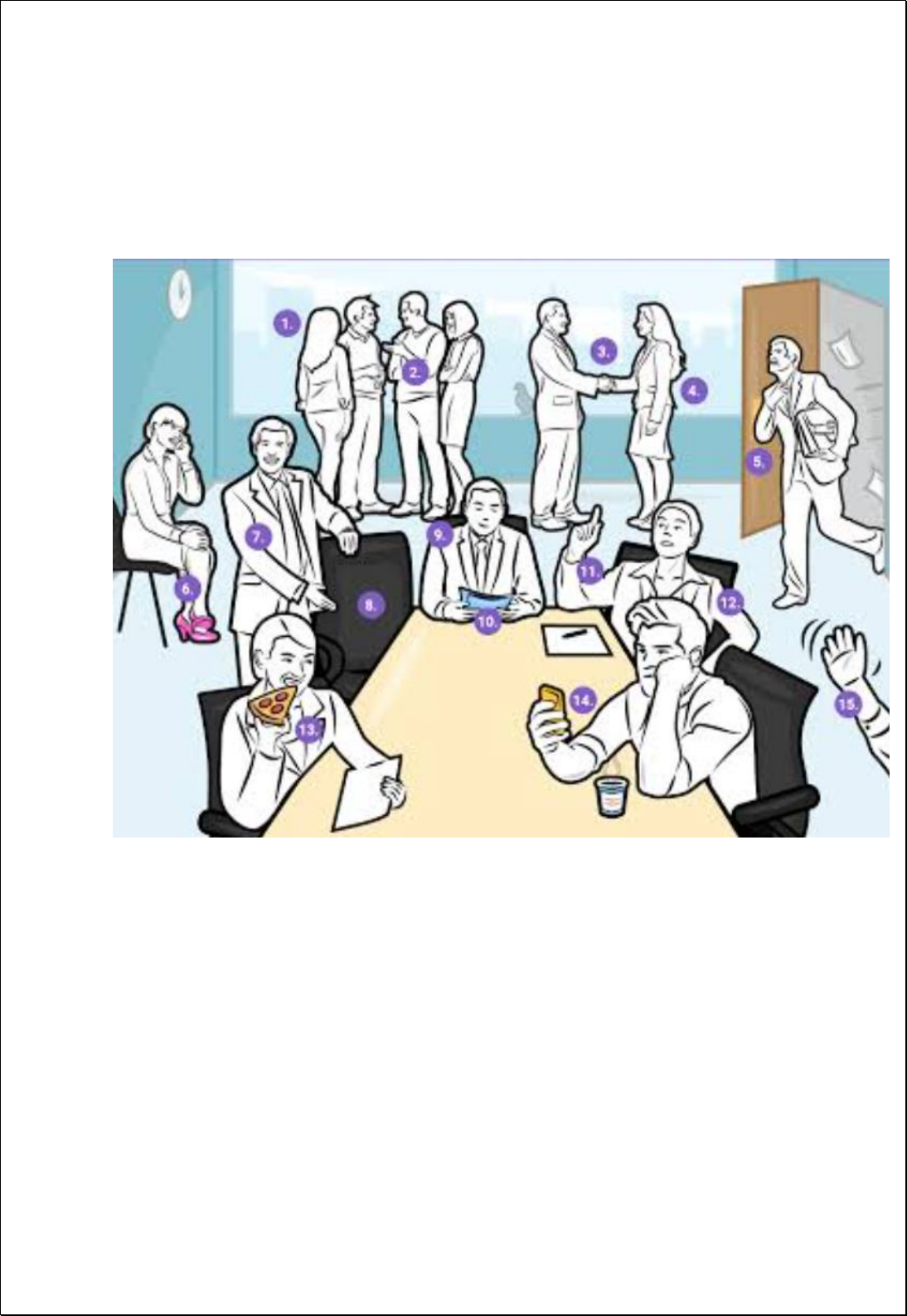
Compliment the hostess if you like the food, but don’t voice your opinion if you don’t.
Use your utensils for eating, not gesturing.
Keep your elbows off the table. Rest the hand you are not using in your lap.
Eat slowly and pace yourself to finish at the same approximate time as the host or hostess.
Avoid making other rude sounds at the table.
If you spill something at a restaurant, signal one of the servers to help. If you spill something at
a private dinner party in someone’s home, pick it up and blot the spill. Offer to have it
professionally cleaned if necessary.
When you finish eating, leave your utensils on your plate or in your bowl.
Never use a toothpick or dental floss at the table.
